| Brainstorm: "Second Smile" (Intercord/Spiegelei, Jan. 1974) |
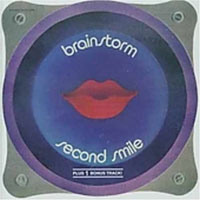 Lost & Found!
Lost & Found!
(27.06.2008) |
| Herbie Hancock: "Head Hunters" (Columbia, Jan. 1974) |
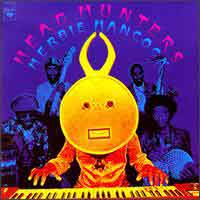 Eigentlich sind Funk- und Jazzrock nicht meine Baustellen, aber an diesem
Album von Ex-Miles-Davis-Keyboarder Herbie Hancock kommt man kaum
vorbei, denn ES ROCKT! Und das ganz ohne E-Gitarren! Stark ist auch die
Intro zur Neuauflage seines Klassikers "Watermelon Man" aus
den 60ern, gespielt auf einer Okarina. Oder ist das doch ein Synthie?
Egal!
Eigentlich sind Funk- und Jazzrock nicht meine Baustellen, aber an diesem
Album von Ex-Miles-Davis-Keyboarder Herbie Hancock kommt man kaum
vorbei, denn ES ROCKT! Und das ganz ohne E-Gitarren! Stark ist auch die
Intro zur Neuauflage seines Klassikers "Watermelon Man" aus
den 60ern, gespielt auf einer Okarina. Oder ist das doch ein Synthie?
Egal!

 Mehr ...
Mehr ...
"Head Hunters is the best-selling jazz album of all
time. It came out at a time when jazz was struggling commercially against
rock and pop. Herbie Hancock did with Head Hunters what Miles Davis had
failed to do with On the Corner (Columbia, 1972): make a jazz album that
was immensely appealing to a wider audience.
Head Hunters heralded the birth of the jazz-funk era, characterised by the
use of jazz reeds, electric bass, guitar and keyboards, a highly defined
rhythm driven by a tight bass-and-drum relationship, riff-based compositional
devices, use of sudden silences and space as rhythmic elements in themselves,
and an overall electric sound that demanded to be played loud.
There was no electric guitar in the band, which helped to distinguish it
from jazz-rock fusion bands of the time such as John McLaughlin's Mahavishnu
Orchestra, or the band that played on Billy Cobham's Spectrum in the same
year Head Hunters was recorded.
"Chameleon", the opening track, was immediately recognised as
a major contribution to both the jazz canon and the dance canon. No riff
in jazz had ever sounded as deep and thrusting as this. In spite of the
widespread popularity of "Chameleon" and the legion of admirers
who claim it's the greatest jazz-funk track ever, the real masterpiece is
"Watermelon Man".
It's mildly ironic that the best piece on the album should be one that Hancock
had composed early in his career (it first appears on his first album as
leader, Takin' Off, Blue Note, 1962). The 1973 version is virtually unrecognisable
from the original - it retains only the blues-based progression, and Paul
Jackson's detached bass figures wink distantly at Butch Warren's original
blues bass line. The composition is constructed cautiously over a light
ostinato pipe figure that builds up into a theme dominated by Hancock's
Fender Rhodes, alternating between a staccato emphasis on the off-beat and
a call-and-response dialogue between Hancock and Bennie Maupin that hovers
in eerie suspension over the bass and drums.
Most significantly, the album introduces humour as a central element in
the argument: jazz-funk could only be taken seriously as a genre when it
mocked itself. Head Hunters drew simultaneously on Herbie Hancock's decade
of playing with the jazz greats, the wah-wah sound of Jimi Hendrix's legacy,
and the feverish dance sound of Sly Stone and George Clinton. And it did
this with the supreme paradoxical humour of simultaneous detachment and
involvement that only a master like Hancock could pull off." (Cootie)
|
|
| Gram Parsons: "Grievous Angel" (Reprise, Jan. 1974) |
 Die Veröffentlichung seines zweiten Soloalbums hatte er nicht mehr
erlebt. Kurz nach den Aufnahmen September 1973 starb Parsons den typischen
Rock'n'Roll-Tod (Drogen...) und hinterließ eine wunderbare Platte mit
wunderbaren Liedern: "Brass
Buttons", "$1000 Wedding" und das Duett mit Emmylou
Harris: "Love Hurts".
Die Veröffentlichung seines zweiten Soloalbums hatte er nicht mehr
erlebt. Kurz nach den Aufnahmen September 1973 starb Parsons den typischen
Rock'n'Roll-Tod (Drogen...) und hinterließ eine wunderbare Platte mit
wunderbaren Liedern: "Brass
Buttons", "$1000 Wedding" und das Duett mit Emmylou
Harris: "Love Hurts".

 Mehr ...
Mehr ...
| "Even with the persistent rough edges, this is a masterful
album, where Gram and his posse finally hit a groove. The musicians are
more relaxed, and at last it doesn't seem like they feel they have to prove
themselves: hippie-billy country has arrived. The vocals (especially Emmylou's)
are sometimes still technically choppy, but Gram's warm, confident delivery
sounds positively serene, and even the flubbed parts exude soulfulness and
purpose. As the album winds down, Gram and Emmylou have finally nailed their
duets down, particularly on "Love Hurts" and "In My Hour
Of Darkness," which are two of the golden moments they are remembered
for. One of the great "what-ifs" of all time is what would have
happened with this ensemble if Parsons hadn't overdosed in the desert right
after this was made. Sigh" |
|
Parsons helped invent country rock with the Byrds and the
Flying Burrito Brothers, but he perfected it here. Emmylou Harris was his
ideal singing partner, and their voices blend in the high lonesome wail
of "Brass Buttons" and "$1,000 Wedding." Weeks after
finishing the album, Parsons was dead at twenty-six. (Rolling Stone)
Total album sales: 140,000
Peak chart position: 195 |
|
| Ducks Deluxe (RCA, Feb. 1974) |
|
 Das unübertroffene Debüt der Band! Die Keimzelle der Tyla
Gang (Sean Tyla), der Motors
(Nick Garvey) und Graham Parkers Begleitband The
Rumour (Martin Belmont). Pubrock at it's best!
Das unübertroffene Debüt der Band! Die Keimzelle der Tyla
Gang (Sean Tyla), der Motors
(Nick Garvey) und Graham Parkers Begleitband The
Rumour (Martin Belmont). Pubrock at it's best!
The Ducks Deluxe's debut record may be the pinnacle of
the pub rock genre. Its 12 cuts hold up as exciting, textbook rock &
roll, released at a time when mainstream rock had forsaken its roots.
Ducks Deluxe is filled with minor classics, from the driving "Don't
Mind Rockin' Tonite" and "Coast to Coast," to the New
Orleans R&B of "Daddy Put the Bomp." (J.P. Ollio)
|
| Bob Dylan & The Band: "Planet Waves" (Elektra/Asylum, Feb. 1974) |
 Die Reunion von Dylan und seiner besten Begleitband nach einer mehrjährigen
Unterbrechung führte zu diesem Studioalbum und einer sehr erfolgreichen
Tournee mit anschließendem Livealbum. Für mich ist bis heute unerklärlich,
warum diese Platte als eine der schwächeren Dylan-Platten eingeschätzt
wird: "Going, Going, Gone" und "Forever Young" gehören
zu den besten Songs von Dylan. Außerdem spielen Levon Helm, Rick
Danko, Garth Hudson, Robbie Robertson und Richard
Manual wie immer traumwandlerisch zusammen.
Die Reunion von Dylan und seiner besten Begleitband nach einer mehrjährigen
Unterbrechung führte zu diesem Studioalbum und einer sehr erfolgreichen
Tournee mit anschließendem Livealbum. Für mich ist bis heute unerklärlich,
warum diese Platte als eine der schwächeren Dylan-Platten eingeschätzt
wird: "Going, Going, Gone" und "Forever Young" gehören
zu den besten Songs von Dylan. Außerdem spielen Levon Helm, Rick
Danko, Garth Hudson, Robbie Robertson und Richard
Manual wie immer traumwandlerisch zusammen. |
| Humble Pie: "Thunderbox" (A&M, Feb. 1974) |
 Dieses Pie-Album habe ich damals im Weseler Kaufhof für einen 5er
vom Wühltisch ergattert - ich muss zugeben, hauptsächlich wegen
des Innencovers (benutzt eure Maus!), denn Steve Marriott, Clem
Clempson & Co. waren mir damals kaum ein Begriff. Die Musik auf
der Platte ist schwärzester Soulrock von einer weißen Band und war
damals eigentlich überhaupt nicht nach meinem Geschmack. Erst viel
später habe ich die tollen Soulsongs zu schätzen gelernt: "Groovin'
With Jesus" (Gene Barge), "Anna" (Arthur Alexander), "I
Can't Stand The Rain" und "99 Pounds" (Ann
Peebles), "Drift Away" (Dobie
Gray) etc.
Dieses Pie-Album habe ich damals im Weseler Kaufhof für einen 5er
vom Wühltisch ergattert - ich muss zugeben, hauptsächlich wegen
des Innencovers (benutzt eure Maus!), denn Steve Marriott, Clem
Clempson & Co. waren mir damals kaum ein Begriff. Die Musik auf
der Platte ist schwärzester Soulrock von einer weißen Band und war
damals eigentlich überhaupt nicht nach meinem Geschmack. Erst viel
später habe ich die tollen Soulsongs zu schätzen gelernt: "Groovin'
With Jesus" (Gene Barge), "Anna" (Arthur Alexander), "I
Can't Stand The Rain" und "99 Pounds" (Ann
Peebles), "Drift Away" (Dobie
Gray) etc. |
| King Crimson: "Starless And Bible Black" (Island/EG, Feb. 1974) |


 Mehr ...
Mehr ...
Starless and Bible Black is even more powerful and daring than its predecessor, Larks' Tongues in Aspic, with jarring tempo shifts, explosive guitar riffs, and soaring, elegant, and delicate violin and Mellotron parts scattered throughout its 41 minutes, often all in the same songs. The album was on the outer fringes of accessible progressive rock, with enough musical ideas explored to make Starless and Bible Black more than background for tripping the way Emerson, Lake & Palmer's albums were. "The Night Watch," a song about a Rembrandt painting, was, incredibly, a single release, although it was much more representative of the sound that Crimson was abandoning than where it was going in 1973-1974. More to that point were the contents of side two of the LP, a pair of instrumentals that threw the group's hardest sounds right in the face of the listener, and gained some converts in the process.
(by Bruce Eder, All Music Guide)
|
| Loudon Wainwright III: "Attempted Moustache" (Columbia, Feb. 1974) |
 Loudon
wurde in den 70ern als einer der vielen neuen "Dylans" gehandelt,
war aber eigentlich immer nur "Loudon". Dies ist sein 4. Album
und enthält einige seiner bekanntesten Songs: "Swimming Song"
(gab's mal in deutsch von Cochise: wer kennt die noch?), "Down
Drinking At The Bar", "The Man Who Couldn't Cry" (gibt's
'ne tolle Version von Johnny Cash!). Außerdem covert er selber
"Come A Long Way" von seiner damaligen Frau Kate
McGarrigle. In der Begleitung die damalige Nashville-Mafia (Mack
Gayden, Reggie Young, Pig Robbins, Johnny Christopher,
Tommy Cogbill, Kenny Buttrey u.a.), produziert hat der Dylan-Spezi
Bob Johnston. Loudon
wurde in den 70ern als einer der vielen neuen "Dylans" gehandelt,
war aber eigentlich immer nur "Loudon". Dies ist sein 4. Album
und enthält einige seiner bekanntesten Songs: "Swimming Song"
(gab's mal in deutsch von Cochise: wer kennt die noch?), "Down
Drinking At The Bar", "The Man Who Couldn't Cry" (gibt's
'ne tolle Version von Johnny Cash!). Außerdem covert er selber
"Come A Long Way" von seiner damaligen Frau Kate
McGarrigle. In der Begleitung die damalige Nashville-Mafia (Mack
Gayden, Reggie Young, Pig Robbins, Johnny Christopher,
Tommy Cogbill, Kenny Buttrey u.a.), produziert hat der Dylan-Spezi
Bob Johnston. |
| Steely Dan: "Pretzel Logic" (ABC, März 1974) |
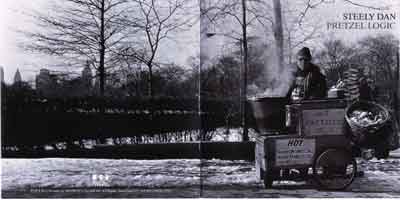 Drittes Album einer der wichtigsten Bands der 70er und auch einer meiner
Lieblingsbands! Gleichzeitig ist es auch das letzte Album als "Band
im herkömmlichen Sinne": Nach einer langen, anstrengenden und
frustrierenden Tournee zu diesem Album brach die Truppe auseinander: Gitarrist
Jeff Baxter und Drummer Jim Hodder waren weg, nur der Gitarrist
Dennis Diaz kam auch auf dem nächsten Album "Katy
Lied" (1975) noch gelegentlich zum Einsatz. Danach war Steely
Dan nur noch ein Studioprojekt, bestehend aus den Songschreibern Walter
Becker (Bass, Gitarre) und Donald Fagan (Gesang, Keyboards).
Zu unser aller Glück hatte sich ABC damals darauf eingelassen, weshalb
es in der Zukunft noch viele tolle Steely Dan-Alben geben würde.
"Pretzel Logic" war zu Unrecht für mich lange ein übersehenes
Steely Dan-Album, denn ich hatte die Band erst mit "Katy
Lied" kennen gelernt und kannte von den drei Vorgängern
eigentlich nur das Debüt "Can't
Buy Thrill" (1972) mit den Hits "Do It Again" und "Reeling
In The Years". Im Nachhinein betrachtet ist aber auch dieses Album
nicht zu verachten und enthält ein paar exzellente Songs, z.B. den
Hit "Rikki Don't Lose That Number" und "Barrytown".
Drittes Album einer der wichtigsten Bands der 70er und auch einer meiner
Lieblingsbands! Gleichzeitig ist es auch das letzte Album als "Band
im herkömmlichen Sinne": Nach einer langen, anstrengenden und
frustrierenden Tournee zu diesem Album brach die Truppe auseinander: Gitarrist
Jeff Baxter und Drummer Jim Hodder waren weg, nur der Gitarrist
Dennis Diaz kam auch auf dem nächsten Album "Katy
Lied" (1975) noch gelegentlich zum Einsatz. Danach war Steely
Dan nur noch ein Studioprojekt, bestehend aus den Songschreibern Walter
Becker (Bass, Gitarre) und Donald Fagan (Gesang, Keyboards).
Zu unser aller Glück hatte sich ABC damals darauf eingelassen, weshalb
es in der Zukunft noch viele tolle Steely Dan-Alben geben würde.
"Pretzel Logic" war zu Unrecht für mich lange ein übersehenes
Steely Dan-Album, denn ich hatte die Band erst mit "Katy
Lied" kennen gelernt und kannte von den drei Vorgängern
eigentlich nur das Debüt "Can't
Buy Thrill" (1972) mit den Hits "Do It Again" und "Reeling
In The Years". Im Nachhinein betrachtet ist aber auch dieses Album
nicht zu verachten und enthält ein paar exzellente Songs, z.B. den
Hit "Rikki Don't Lose That Number" und "Barrytown". |
| War: "Live!" (United Artists, März 1974) |
 Sie begannen als Begleitband von Eric Burdon, konnten sich aber
ähnlich wie The Band schnell
von ihrem Vorsänger emanzipieren und brachten eine Reihe erfolgreicher
Alben unter eigenem Namen heraus. Auffällig in dieser ansonsten "schwarzen"
Truppe war immer Lee Oskar, ein dänischer (!) Mundharmonika-Virtuose,
der zusammen mit dem Saxofonisten Charles Miller starke "Bläsersätze"
spielte. Dieses Live-Doppelalbum habe ich mir damals nach einem tollen
Auftritt der Truppe im Fernsehen gekauft (muss wohl Beatclub oder Musikladen
gewesen sein).
Sie begannen als Begleitband von Eric Burdon, konnten sich aber
ähnlich wie The Band schnell
von ihrem Vorsänger emanzipieren und brachten eine Reihe erfolgreicher
Alben unter eigenem Namen heraus. Auffällig in dieser ansonsten "schwarzen"
Truppe war immer Lee Oskar, ein dänischer (!) Mundharmonika-Virtuose,
der zusammen mit dem Saxofonisten Charles Miller starke "Bläsersätze"
spielte. Dieses Live-Doppelalbum habe ich mir damals nach einem tollen
Auftritt der Truppe im Fernsehen gekauft (muss wohl Beatclub oder Musikladen
gewesen sein).

 Mehr ...
Mehr ...
|
War Live — also sometimes known simply as Live — was recorded
just as the group was achieving a peak of popularity and virtuosity, and
released 16 months later, amid a string of highly successful studio LPs.
It was underappreciated at the time, and only on CD has it found its proper
audience. Recorded at one late November show at the High Chaparral in
Chicago, the group had been engaged earlier the same year in a national
tour as the opening act for Isaac Hayes and was reportedly so good that
Hayes kept cutting back the length of their opening set. The tapes from
this show have held up extremely well across the decades, with rich fidelity
and a close sound. The live renditions of "The Cisco Kid" and
other such songs may not supplant the studio originals, but the 20-minute
"Get Down" is worth hearing.
(by Bruce Eder, All
Music Guide)
|
|
| Jesse Colin Young: "Light Shine" (Warner, März 1974) |
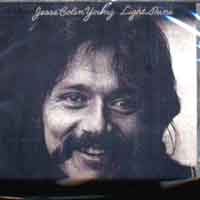 Leider ist dieser Mann bei uns völlig unbekannt! Spielte mal Ende
der 60er in einer der ersten wichtigen "Westcoast-Hippie-Bands",
den Youngbloods. Die kennt hier aber auch keiner. Wiederveröffentlichungen
auf CD sind wohl im Moment nicht verfügbar oder schweineteuer. Als
die Platten in den 70ern raus kamen gingen sie völlig an mir vorbei.
Ich hatte aber das Glück, bei einem Freund Ende der 70er das Album
"Song For Juli" von 1973
zu entdecken: wunderbar entspannte Westcoastklänge gibt es da zu
hören. In den kommenden Jahren - noch vor Einführung der CDs
- konnte ich die meisten seiner Soloalben dann aus irgendwelchen Grabbelkisten
ziehen. Solltet Ihr also irgendwas von ihm im 2nd-Hand-Plattenladen eures
Vertrauens finden: SOFORT KAUFEN!!!
Leider ist dieser Mann bei uns völlig unbekannt! Spielte mal Ende
der 60er in einer der ersten wichtigen "Westcoast-Hippie-Bands",
den Youngbloods. Die kennt hier aber auch keiner. Wiederveröffentlichungen
auf CD sind wohl im Moment nicht verfügbar oder schweineteuer. Als
die Platten in den 70ern raus kamen gingen sie völlig an mir vorbei.
Ich hatte aber das Glück, bei einem Freund Ende der 70er das Album
"Song For Juli" von 1973
zu entdecken: wunderbar entspannte Westcoastklänge gibt es da zu
hören. In den kommenden Jahren - noch vor Einführung der CDs
- konnte ich die meisten seiner Soloalben dann aus irgendwelchen Grabbelkisten
ziehen. Solltet Ihr also irgendwas von ihm im 2nd-Hand-Plattenladen eures
Vertrauens finden: SOFORT KAUFEN!!!

 Mehr ...
Mehr ...
|
Whether it was creative fervor or contractual obligation, Jesse Colin
Young was back with a new album only six months after his commercial and
artistic breakthrough with Song for Juli, and though the album featured
more original songs, Young seemed to be stretching for material, turning
the three tunes on side one into a "California Suite" with lots
of jazzy instrumental work. But the writing was less important than the
playing, as many of Young's backup musicians -- notably drummer Jeffrey
Myer, keyboardist Scott Lawrence and reed player Jim Rothermel -- had
been with him for a while now and were playing like a tight band. Some
of the songs were little more than weather reports ("Grey Day")
or travelogues ("Barbados"), and when Young did have a message
to convey, as in the title song (repeated from the Youngbloods' Good and
Dusty album), he could come off as preachy, but the music was so delightful
that none of that mattered much. Fans made it Young's highest-charting
album yet, and it ranks with Song for Juli as his biggest seller.
(by William Ruhlmann, All
Music Guide)
|
|
|
Jesse Colin Young's third post-Youngbloods solo album is
on a par with the first two — making it a worthwhile musical half
hour. His appealingly laid-back twang and usually top grade, if slightly
love-and-sunshine-obsessed, songwriting continue to appeal to my subcutaneous
rural streak. Side One consists entirely of "California Suite,"
an admirable vehicle for nearly all of his virtues. In its wake, Side
Two feels more like filler.
(Alan Niester, Rolling Stone)
|
|
| Miles Davis: "Big Fun" (Columbia, April 1974) |
 Ein
wunderbares Doppelalbum mit gerade einmal vier Liedern, jedes deutlich
über 20 Minuten. Aufnahmen von November 1969 bis Juni 1972 - wahrscheinlich
Outtakes von "Bitches Brew"
bis "On The Corner". Ein
wunderbares Doppelalbum mit gerade einmal vier Liedern, jedes deutlich
über 20 Minuten. Aufnahmen von November 1969 bis Juni 1972 - wahrscheinlich
Outtakes von "Bitches Brew"
bis "On The Corner".
(01.04.2016)

 Mehr ...
Mehr ...
Despite the presence of classic tracks like Joe Zawinul's "Great Expectations," Big Fun feels like the compendium of sources it is. These tracks are all outtakes from other sessions, most notably Bitches Brew, On the Corner, and others. The other element is that many of these tracks appeared in different versions elsewhere. These were second takes, or the unedited takes before producer Teo Macero and Miles were able to edit them, cut and paste their parts into other things, or whatever. That is not to say the album should be dismissed. Despite the numerous lineups and uneven flow of the tracks, there does remain some outstanding playing and composing here. Most notably is "Great Expectations" from 1969, which opens the album. Here the lineup is Miles, Steve Grossman, Bennie Maupin, John McLaughlin, Khalil Balakrishna, and Bihari Sharma on sitar and tambura, Herbie, Chick Corea, Ron Carter, Harvey Brooks, Billy Cobham, and Airto. Creating a series of vamps from drones and a small melodic figure, there is very little in the way of groove or melodic development until the middle section, where a series of modalities enters the composition. The second album in the set features "Go Ahead John," an outtake from Jack Johnson's sessions that is 28 minutes in length. It's a riff-based groover, with McLaughlin and his wah-wah pedal setting the pace with Steve Grossman on soprano. The basic motif is the blues, floating around E and Bb flat, but there are modulations introduced by Miles into Db flat that add a kinkier dimension into the proceedings as well. Dave Holland is the bass player, and DeJohnette is the drummer. There is no piano. What's most interesting about this date is how it prefigures what would become "Right Off" from Jack Johnson. It doesn't have the same fire, nor does it manage to sustain itself for the duration, but there are some truly wonderful sections in the piece. This is for Miles fans only, especially those of his electric period, because it fills in the puzzle. The reissue added four bonus tracks to the original double-LP set, but other than "Recollections" by Zawinul, they shed little light on the mystique and development of the intensely creative music being developed in 1969 and 1970. Others should be directed to Bitches Brew, In A Silent Way, Jack Johnson, or Live Evil as starting points.
(by Thom Jurek, All Music Guide)
|
| Joni Mitchell: "Court And Spark" (Elektra/Asylum, April 1974) |
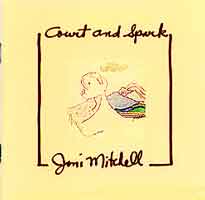 Eines der vielen Klassealben von Joni Mitchell. Hier ist die Jazzorientierung
zum ersten Mal deutlich zu erkennen: die Begleitband wird weitestgehend
von den Crusaders gestellt (Wilton Felder, Joe Sample
und Larry Carlton).
Eines der vielen Klassealben von Joni Mitchell. Hier ist die Jazzorientierung
zum ersten Mal deutlich zu erkennen: die Begleitband wird weitestgehend
von den Crusaders gestellt (Wilton Felder, Joe Sample
und Larry Carlton). |
| Richard & Linda Thompson: "I Want To See The Bright Lights Tonight" (Island, April 1974) |
 Diese erste Veröffentlichung vom Ex-Fairport
Convention-Gitarristen zusammen mit seiner Frau Linda gilt allgemein
als Meilenstein des Folkrock: gigantische Lieder von Richard (ich weiß
gar nicht, welches ich besonders hervorheben soll), beeindruckender Gesang
des Paares und ein tolles Ensemblespiel, bei dem Richards Gitarre herausragt.
Als Gäste u. a. dabei: die Fairport-Kollegen
Simon Nicol und Trevor Lucas, sowie Richard Harvey
und Brian Gulland von Gryphon.
Diese erste Veröffentlichung vom Ex-Fairport
Convention-Gitarristen zusammen mit seiner Frau Linda gilt allgemein
als Meilenstein des Folkrock: gigantische Lieder von Richard (ich weiß
gar nicht, welches ich besonders hervorheben soll), beeindruckender Gesang
des Paares und ein tolles Ensemblespiel, bei dem Richards Gitarre herausragt.
Als Gäste u. a. dabei: die Fairport-Kollegen
Simon Nicol und Trevor Lucas, sowie Richard Harvey
und Brian Gulland von Gryphon.

 Mehr ...
Mehr ...
"After splitting from Fairport Convention, the UK's most consistently exploratory folk-rock outfit, Richard Thompson launched what's been one of the most infuriatingly on/off solo careers this side of Bob Dylan. It wasn't until he struck out on his own that he began to sing most of his own material and his voice - with its dark, wry, quality - was the perfect vehicle for the increasingly nihilistic material he was penning. 1974's I Want To See The Bright Lights Tonight was the first of six albums recorded with his wife Linda and it's the couple's bleakest and most ambitious work.
Thompson's exhilarating tremolo guitar work beautifully disfigures a series of songs that work as aural snapshots from the desperate margins, where drink has the power to level all comers and girls dream of escaping to anywhere. In many ways it feels like an English version of Bruce Springsteen's bleak masterpiece Nebraska.
Although the pair are still working within folk forms they expand those parameters as boldly as Fairport Convention, no more so than on The Calvary Cross, where Thompson's guitar spirals out into elegiac clusters of pure, free sound.
Still, the highlight is undoubtedly The End Of The Rainbow, a breathtaking dialogue directed to a newborn child warning that: "There's nothing at the end of the rainbow / There's nothing to grow up for anymore." It's Thompson's unblinking ability to poeticise these kind of uncomfortable sentiments that make it such a harrowingly affecting record."
Die gro�e Tradition des britischen Folk-Rocks ist im Laufe der letzten drei Pop-Jahrzehnte vielfach mutiert. W�hrend die Identit�ts-stiftende Wirkung der Zauselfrisuren und bodenlangen Hippie-Kleidern l�ngst von zig anderen Subkulturen �berwuchert ist, feiert das musikalische Erbe dieser "Bewegung" fr�hliche Urst�nde. Nicht nur fesche Indie-M�dchen stemmen sich heutzutage mit einsamer Gitarre h�chst erfolgreich gegen jeden elektronischen Trend. Handgemacht und emotional.
Dieses Verm�chtnis haben Richard und Linda Thompson zwischen Ende der sechziger und Mitte der siebziger Jahre mitgepr�gt: Die melancholische Sch�nheit in ihren Songs, die sanfte D�sternis einer von Schicksalen geplagten Welt, in der gek�mpft, geliebt und gelitten wird. Mit ihrer glockenhellen Stimme war Linda eine Art europ�ischer Widerpart der ber�hmten US-Kolleginnen Joan Baez oder Joni Mitchell. Das amerikanische Nachrichtenmagazin "Newsweek" bezeichnete sie einmal als "the brightest voice in popmusic".
Diese Konzentration auf den reinen, klaren (Gitarren-)Song erfolgte erst bei der vielk�pfigen Band Fairport Convention (nur Richard) und ab 1974 dann als frisch verm�hltes Singer-/Songwriter-Ehepaar mit diesem Debutalbum. Als Duett perfektionieren die Beiden den spr�den Charme von Richard Thompsons Solo-Debut "Henry, The Human Fly". W�hrend Lindas Stimme das brummig-virtuose Spiel ihres damaligen Gatten in lichte H�hen f�hrt, h�lt Richard dagegen und l�sst im Klassiker "Calvary Cross" die Saiten jaulen. Das unmittelbar darauf folgende "Withered and Died" zeigt die Technik des Wechselspiels sehr eindrucksvoll: Auf die tieft�nende Vorgabe Richards folgt eine zerbrechliche, aber nicht minder ergreifende Ballade Lindas.
"I Want to See.." ist sicherlich die d�ster-gef�rbteste Platte der Thompsons. Manchmal scheint es, als wollten die Beiden mit ihrer virtuosen Musikalit�t direkt zu Beginn ihrer gemeinsamen �ra allen gebeutelten Gestalten trotz allen Ungl�cks Hoffnung und Zuversicht einhauchen. Dass sie nicht nur Meister der Moll-Stimmungen sind, sondern auch brillante Studiot�ftler, zeigen kleine, feine Produktions-technische Kniffe im Chorus des Titelsongs oder die Holzblas-Instrumente in "We Sing Hallelujah".
Etwa ein Jahrzehnt hielt die Musik- und Liebes-Beziehung des Folk-Paares. W�hrend Richard stets bei seinem Instrument blieb, wechselte Linda, neben gelegentlicher Engagements als Songschreiberin, zum Theater und f�hrte sp�ter in London ein Schmuckgesch�ft, bevor sie 2002 ins Musikgesch�ft zur�ckkehrte.
(Ralf Niemczyk, www.pure.dee)
|
| Robert Calvert: "Captain Lockheed & The Starfighters" (United Artists, Mai 1974) |
 ACHTUNG! Ein KONZEPTALBUM? Ein neues HAWKWIND-Album? Ein HöRSPIEL?
Alles irgendwie richtig! Bob Calvert, Teilzeit-Lyriker und -sänger
von Hawkwind, hatte die damals
zahlreichen Starfighter-Abstürze und die Verstrickungen der Politiker
zum Thema seines Solodebüts gemacht. Weshalb auch Franz-Josef
Strauss hier (wahrscheinlich erstmalig) zur Hauptfiguren einer britischen
Rockplatte wurde. Kippt 4 Teile Hawkwind
(bis auf den ausgestiegenen Dikmik sind alle dabei), 4 Teile Hörspiel
und je 1 Teil Pink Fairies (Paul
Rudolph und Twink) und Arthur Brown in einen Topf, rührt
um und würzt das Ganze mit ein bisschen Eno - und Ihr wisst,
wie das klingt!
ACHTUNG! Ein KONZEPTALBUM? Ein neues HAWKWIND-Album? Ein HöRSPIEL?
Alles irgendwie richtig! Bob Calvert, Teilzeit-Lyriker und -sänger
von Hawkwind, hatte die damals
zahlreichen Starfighter-Abstürze und die Verstrickungen der Politiker
zum Thema seines Solodebüts gemacht. Weshalb auch Franz-Josef
Strauss hier (wahrscheinlich erstmalig) zur Hauptfiguren einer britischen
Rockplatte wurde. Kippt 4 Teile Hawkwind
(bis auf den ausgestiegenen Dikmik sind alle dabei), 4 Teile Hörspiel
und je 1 Teil Pink Fairies (Paul
Rudolph und Twink) und Arthur Brown in einen Topf, rührt
um und würzt das Ganze mit ein bisschen Eno - und Ihr wisst,
wie das klingt!

 Mehr ...
Mehr ...
|
What can you say about an album that crosses space rock charge out with
Monty Pythonistic skits—except that it’s a hazardous rock and
with ever-darkening humour direct from the bi-polar brainpan of Hawkwind’s
erratic vocalist/lyricist, Robert Calvert. It was recorded at about the
same time as Calvert’s first and only studio release with Hawkwind
during their tenure with United Artists, the “Urban Guerilla”/
“Brainbox Pollution” single. And Hawkwind all appear here (minus
the recently-departed Dikmik), co-joined by Paul Rudolph (on 6 string
and bass guitar), Twink, Arthur Brown, Adrian Wagner, Brian Eno, Vivian
Stanshall and Jim Capaldi creating a virtual Hawkwind ep split into spoken
word skits and the Arthur Brown tormented two-parter, “The Song of
The Gremlin”. The veritable Hawkwind tracks are all supremely mental
space rock outs of the highest order, giving a hint as to what Hawkwind
would’ve like if Paul Rudolph had replaced not Lemmy, but Dave Brock.
This concept album deals with the tragedy that occurred when American
made Lockheed Starfighter jets were purchased in the sixties by the West
German Air Force in a supreme act of folly. As stated in the gatefold,
the Starfighter was “…originally used by the U.S. Air Force
as a light, single seater, fair weather fighter…[but the German Defense
Ministry had these hastily converted into]…heavy duty, atom bombers.
It was these severe structural modifications which rendered the jet unstable
and difficult to control.” Calvert must have felt a strong affinity
with them, as he too was unreliable, difficult to control and unstable
as hell.
The sputtering of a trashed Luftwaffe plane starts up the album over Calvert’s
brilliant portrayal of the West German Defence Minister as a raging psychopath
who begins angrily berating his country’s air force power, which
mutates into a vainglorious fantasy of a “reawakening of German air
supremacy” as his raving overdubs into backward Strauss masking and
into the first of four 1973-styled Hawkwind hard space rock thrash outs,
“Aerospaceage Inferno”. Calvert calmly intones echoed lines
over Rudolph’s swooping guitar lines AND his overdubbed, pumping
bass riffs and Simon King’s ever-stamina drumming. It links directly
into the hilarious “Aircraft Salesman”, where the “wunnerful”
American Starfighter salesman cons the still-uptight German Air Defence
Minister with buying his wares with promises not of safety or of adequate
ground crew support, but of a tasty-looking logo with an identifying “G”
(for ‘Germany”). The only non-Calvert composition (co-written
with Dave Brock) “The Widow Maker” follows, and it’s Hawkwinding
like crazy, all churning guitar and Rudolph’s (or Lemmy’s?)
heat-generating bass over more Simon King drums and cymbal bashing. Side
two continues with vocal skits, and it is interesting to note the inclusion
of “The Widow’s Song”, which appears in the printed libretto.
It is nowhere to be found on the album, but turned up years later on a
crap Hawkwind collection with Calvert femme-vocalising. It was once recorded
that Nico was named as a possible contributing vocalist on “Lockheed”,
and in all certainty “Widow’s Song” was slated for her.
Between Calvert’s vocal rendition, the funereal nature of the song
and the overall Teutonic effect makes it seem more than a possibility).
A screeching electronic swirl crashes open the Hawkwind-styled “Ejection”,
with classic Calvert lyrics that rhyme every word with the title over
repeated rhythms and omnipresent Simon King high-hat and piston-like fills.
“I’m too high to die”, intones Calvert, and Rudolph proceeds
to tear it up with yet again before the final crash. The dirge-like “Catch
A Falling Starfighter” is surrounded by ghostly electronics as Twink
beats a funeral march over the assembled moaning of blackened Starfighter
pilots. Calvert’s following album, “Lucky Leif And the Longships”,
was hardly as successful. Although it includes personnel from this album,
it was an outright disaster. But then again, Robert Calvert was never
exactly known for doing anything in half measures.
(www.headheritage.co.uk)
|
|
| Man: "Rhinos, Winos + Lunatics" (United Artists, Mai 1974) |
|
 Musikalisch sicherlich einer der Höhepunkte in der langen Bandgeschichte.
Das Bandkarussell hatte sich mal wieder gedreht, was bislang konstante
Höchstleistungen im Studio verhinderte. Von der alten Truppe blieben
nur Micky Jones (g,v) und Terry Williams (dr) übrig.
Deke Leonard (g,v) kehrte von seinem Iceberg-Projekt
zurück (und blieb dieses mal!), neu dazu kamen von der aufgelösten
Band Help Yourself Keyboarder
Malcolm Morley und Bassist Ken Whaley.
Musikalisch sicherlich einer der Höhepunkte in der langen Bandgeschichte.
Das Bandkarussell hatte sich mal wieder gedreht, was bislang konstante
Höchstleistungen im Studio verhinderte. Von der alten Truppe blieben
nur Micky Jones (g,v) und Terry Williams (dr) übrig.
Deke Leonard (g,v) kehrte von seinem Iceberg-Projekt
zurück (und blieb dieses mal!), neu dazu kamen von der aufgelösten
Band Help Yourself Keyboarder
Malcolm Morley und Bassist Ken Whaley.
(ca. 2005)
Gerade eben höre ich das Album zum ersten mal wieder nach langer
Zeit - und zwar aus dem leicht peinlichen Grund, dass ich es mir gerade
als MP3s besorgt habe. Tja - der Mensch ist halt faul und schwach. Auf
jeden Fall fällt es mir mal wieder auf, dass das tatsächlich
eines der allerbesten Alben der Band ist. Lichtjahre besser als das,
was Martin Ace und seine Sohnemann da kürzlich unter dem
Etikett Man "verbrochen"
haben.
(27.10. 2009)

 Mehr ...
Mehr ...
An excellent set of material energized by the return of the pleasingly abrasive vocals of Deke Leonard; it charted nearly as well as Back Into the Future, and its tighter composition means that in many ways it's held up better over the years. The second half may be the band's artistic high point -- bookended by the pomp-wah instrumentals, "Intro" and "Exit," it contains the unusually sultry "Kerosene" and the epic "Scotch Corner," which builds up from rattling snare and picked guitar verses to beautiful choruses of harmonized vocals.
(by Paul Collins, All Music Guide)
|
| "Bad Company" (Swan Song, Juni 1974) |
 Nach dem Ende von Free taten sich Sänger Paul Rodgers
und Drummer Simon Kirke mit dem Bassisten Boz Burrell (Ex-King
Crimson, sang und spielte auf dem 1971er Werk "Islands")
und dem Gitarristen Mick Ralphs (Ex-Mott
The Hoople) zusammen und waren sogar erfolgreicher als bei Free (abgesehen
vielleicht von deren Hit "All Right Now"). Gutgemachter Hardrock
mit Popeinschlag und Gott sei dank kein dumpfes Heavymetalgebräu.
Nach dem Ende von Free taten sich Sänger Paul Rodgers
und Drummer Simon Kirke mit dem Bassisten Boz Burrell (Ex-King
Crimson, sang und spielte auf dem 1971er Werk "Islands")
und dem Gitarristen Mick Ralphs (Ex-Mott
The Hoople) zusammen und waren sogar erfolgreicher als bei Free (abgesehen
vielleicht von deren Hit "All Right Now"). Gutgemachter Hardrock
mit Popeinschlag und Gott sei dank kein dumpfes Heavymetalgebräu.

 Mehr ...
Mehr ...
"kinda miss the "supergroup". Watching a
bunch of guys get together to collectively destroy their individual reputations
(often at the instigation of their record companies) - that was entertainment!
(Asia, anyone?). Bad Company was never that bad, but they always had a cloud
hanging over them. Critics charged that they left the accomplished confines
of their previous bands (Mott The Hoople, Free, King Crimson) to cash out
in the arena rock arena. And, boy, did they cash in...
...but not without merit. The boys had a pedigree, and singer Paul Rodgers
was very nearly "best of breed" in the strutting lead singer category.
Their first album, Bad Co., is a thrill ride of hooks and riffs, and the
next two, Straight Shooter and Running With Pack, each carry a lot of weight.
Things get a little lighter after that as Rodgers left and the band began
to ape their hair-sprayed peers." (Randy's
Rodeo) |
|
| Jerry Garcia: "Garcia (Compliments)" (Round, Juni 1974) |
 Auch Jerrys zweites Soloalbum heißt wieder einfach nur "Garcia".
Doch diesmal gibt es keine eigenen neuen Songs, die ja sonst in der Zusammenarbeit
mit Texter Robert Hunter entstehen (und oft auch den Weg in das
Dead-Repertoire finden), sondern Jerry Garcia wirkt "nur" als
Sänger und Sologitarrist für eine Reihe mehr ("Let's Spend
The Night Together" von Jagger/Richards) oder weniger (Irving Berlins
"Russian Lullaby") bekannter Fremdkompositionen, die von Stammbassist
John Kahn als verantwortlichem Produzenten vorgeschlagen und nach
Jerry's Zustimmung mit einer großen Gruppe von Studiomusikern (neben Kahn
und Merl Saunders aus der Jerry-Garcia-Band waren
das der Elvis-Trommler Ron Tutt, der danach fest in die JG-Band
einstieg, die Gitarrenlegenden Larry Carlton und Ben Benay,
Pianist Michael Omartian und viele andere) in Los Angeles aufgenommen
wurden, meist in Abwesenheit des derweil mit den Dead tourenden Gitarristen.
Fehlende psychedelische Akzente (10 relativ kurze Lieder mit nur kurzen
Gitarrensoli, Geigen, Holzbläser, etc.), sowie Song- und Musikerauswahl
haben das Album nicht zu den unter den Deadheads besonders beliebten Garcia-Veröffentlichungen
gemacht. Auch war die Platte in den späten 70ern/ frühen 80ern
schwer zu bekommen (ich habe mir mit viel Aufwand eine teure japanische
Importplatte besorgt und war zuerst auch ein bischen enttäuscht!).
Aus der Distanz heraus und inzwischen längst als CD wiederveröffentlicht
muss ich aber sagen: ein sehr schöne Platte mit schönen, meist
sehr altmodischen Songs!
Auch Jerrys zweites Soloalbum heißt wieder einfach nur "Garcia".
Doch diesmal gibt es keine eigenen neuen Songs, die ja sonst in der Zusammenarbeit
mit Texter Robert Hunter entstehen (und oft auch den Weg in das
Dead-Repertoire finden), sondern Jerry Garcia wirkt "nur" als
Sänger und Sologitarrist für eine Reihe mehr ("Let's Spend
The Night Together" von Jagger/Richards) oder weniger (Irving Berlins
"Russian Lullaby") bekannter Fremdkompositionen, die von Stammbassist
John Kahn als verantwortlichem Produzenten vorgeschlagen und nach
Jerry's Zustimmung mit einer großen Gruppe von Studiomusikern (neben Kahn
und Merl Saunders aus der Jerry-Garcia-Band waren
das der Elvis-Trommler Ron Tutt, der danach fest in die JG-Band
einstieg, die Gitarrenlegenden Larry Carlton und Ben Benay,
Pianist Michael Omartian und viele andere) in Los Angeles aufgenommen
wurden, meist in Abwesenheit des derweil mit den Dead tourenden Gitarristen.
Fehlende psychedelische Akzente (10 relativ kurze Lieder mit nur kurzen
Gitarrensoli, Geigen, Holzbläser, etc.), sowie Song- und Musikerauswahl
haben das Album nicht zu den unter den Deadheads besonders beliebten Garcia-Veröffentlichungen
gemacht. Auch war die Platte in den späten 70ern/ frühen 80ern
schwer zu bekommen (ich habe mir mit viel Aufwand eine teure japanische
Importplatte besorgt und war zuerst auch ein bischen enttäuscht!).
Aus der Distanz heraus und inzwischen längst als CD wiederveröffentlicht
muss ich aber sagen: ein sehr schöne Platte mit schönen, meist
sehr altmodischen Songs!
(07.07.2004)

 Mehr ...
Mehr ...
| Jerry Garcia's second solo effort initially bore the same
eponymous title as his first. A parenthetical "Compliments Of"
was originally featured on promotional copies that bore the words atop the
"Garcia" moniker. The name was officially changed in the late
'80s, when the platter evolved into the CD format, to alleviate any confusion
between the two very different recordings. In direct contrast to the 1972
release, the vast majority of the ten tracks on 1974's Garcia (Compliments)
are cover versions performed with an ensemble, rather than just by the multi-instrumental
artist. Equally distinguishing is that most of the material was not selected
by the guitarist, but rather by the project's producer, John Kahn, who likewise
had been Garcia's bassist and primary non-Grateful Dead collaborator. Although
Garcia would reassert more control over the choice of songs in the future,
this album heralds the origins of what would ultimately become the Jerry
Garcia Band. Backed by an A-list cast of studio heavies, covers such as
the Rolling Stones' "Let's Spend the Night Together" and Van Morrison's
"He Ain't Give You None" come off sounding slightly over-arranged.
The converse, however, can be said of Garcia's intimately chilling reading
of Peter Rowan's "Mississippi Moon," the slinky irrepressible
Motown vibe on the Marvelettes' "The Hunter Gets Captured By the Game,"
and Little Milton's "That's What Love Will Make You Do" -- all
of which remained as staples of the Jerry Garcia Band's live catalog. Although
there aren't very many opportunities for Garcia to unleash the full potential
of his formidable fretwork, the reading of Irving Berlin's "Russian
Lullaby" -- adapted from Argentinean guitarist Oscar Alemán's
arrangement -- does allow him to perform some of the disc's most involved
and intricately executed guitar work, which he renders on an acoustic classical
axe. The solitary original composition, "Midnight Town" from Kahn
and lyricist Robert Hunter, comes off somewhat uncharacteristically lightweight
in deference to the album's otherwise solid effort. -- Lindsay Planer (AMG) |
|
| The Grateful Dead: "From The Mars Hotel" (Grateful Dead Rec., Juni 1974) |
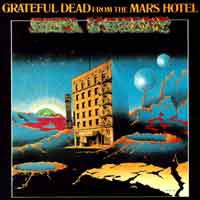 Nicht
mein Lieblinxalbum der Band, aber eigentlich doch ganz schön! Kleine
Besonderheit: es gibt gleich zwei vom Bassisten Phil Lesh komponierte
und gesungene Lieder ("Unbroken Chain" mit Synthesizereinlagen
von Lesh-Spezie Ned Lagin und der bizarre Countrysong "Pride
Of Cucamonga" mit der Pedalsteel des späteren Doobie Brothers
John McFee). Nicht
mein Lieblinxalbum der Band, aber eigentlich doch ganz schön! Kleine
Besonderheit: es gibt gleich zwei vom Bassisten Phil Lesh komponierte
und gesungene Lieder ("Unbroken Chain" mit Synthesizereinlagen
von Lesh-Spezie Ned Lagin und der bizarre Countrysong "Pride
Of Cucamonga" mit der Pedalsteel des späteren Doobie Brothers
John McFee).
Zwei Garcia-Beiträge sind sehr gelungen: "Ship Of Fools"
und "China Doll", zwei weitere dagegen eher nicht, weil für
meinen Geschmack zu plump rockend ("U.S. Blues" und "Loose
Lucy"). Der einzige Beitrag von Bob Weir ("Money Money")
fällt leider auch in die letzte Kategorie. |
| "Merl Saunders" (Fantasy, Juni 1974) |
 Vielleicht ist das titellose dritte nicht das beste Soloalbum des Organisten aus
dem Grateful Dead Umfeld, aber auf jeden Fall
das erste, das ich damals in den frühen 80ern in der Grabbelkiste eines
Plattenladens finden konnte. Schöner Funk mit guten, alten Keyboardssounds
(Hammond! Hohner D-6! Rhodes!), schöne Flöten- und Saxofoneinlagen von
Martin Fierro. Nur Singen kann Saunders leider nicht, was er aber
auch nur einmal versucht. Dieses mal ohne Jerry Garcia
an der Gitarre, was aber nicht wirklich stört.
Vielleicht ist das titellose dritte nicht das beste Soloalbum des Organisten aus
dem Grateful Dead Umfeld, aber auf jeden Fall
das erste, das ich damals in den frühen 80ern in der Grabbelkiste eines
Plattenladens finden konnte. Schöner Funk mit guten, alten Keyboardssounds
(Hammond! Hohner D-6! Rhodes!), schöne Flöten- und Saxofoneinlagen von
Martin Fierro. Nur Singen kann Saunders leider nicht, was er aber
auch nur einmal versucht. Dieses mal ohne Jerry Garcia
an der Gitarre, was aber nicht wirklich stört.
(13.07.2009) |
| Robert Wyatt: "Rock Bottom" (Virgin, Juni 1974) |


 Mehr ...
Mehr ...
|
"Time has done little to erode this classic
from the ex-drummer/vocalist of Soft Machine. Rock Bottom was produced
by Pink Floyd's Nick Mason and released in 1974, just over one year after
Wyatt's now-infamous fall from a window, leaving him paralyzed for life.
Whimsical lyrics in the Lewis Carroll vein are clothed in stirring melodies
tinged with melancholy. Throw in a substantial portion of musical eccentricism--the
backwards, droning loops of South African trumpeter Mongezi Feza (sadly,
he would die of pneumonia in a psychiatric hospital the next year) or
Ivor Cutler's insane Scottish recitative that closes out the album--and
you have a simply unforgettable recording. I don't want to spoil it by
describing too much, because it really would. Suffice to say, I think
this is a really beautiful album: sad, funny, and very, very strange.
Go give it a spin! Recently reissued by Thirsty Ear Records (with a new
front cover, complete lyrics, and new liner notes by Wyatt), so you have
no excuse."
(Joe McGlinchey, All
Music Guide)
|
|
| Kevin Ayers - John Cale - Eno - Nico: "June 1, 1974" (Island, Juli 1974) |
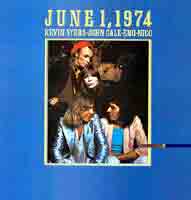 Das muss damals am 1. Juni ein tolles Konzert gewesen sein. Der Ex-Soft
Machine-Sänger Kevin Ayers lud die verwandten Seelen John
Cale und Nico (Ex-Velvet Underground)
und Brian Eno (Ex-Roxy Music)
ein. Man musizierte getrennt und z.T. zusammen. Sehr schön sind zwei
Coverversionen: Nico "singt" Jim Morrisons "The
End", John Cale bringt "Heartbreak Hotel" (Elvis Presley)
in neue Dimensionen.
Das muss damals am 1. Juni ein tolles Konzert gewesen sein. Der Ex-Soft
Machine-Sänger Kevin Ayers lud die verwandten Seelen John
Cale und Nico (Ex-Velvet Underground)
und Brian Eno (Ex-Roxy Music)
ein. Man musizierte getrennt und z.T. zusammen. Sehr schön sind zwei
Coverversionen: Nico "singt" Jim Morrisons "The
End", John Cale bringt "Heartbreak Hotel" (Elvis Presley)
in neue Dimensionen.

 Mehr ...
Mehr ...
I just wish I'd been there on June 6th. I actually knew a guy who was there and was so jealous. I was already an Kevin Ayers / Eno / Velvet Underground Fan and their playing together made me rush out and buy the Album (on vinyl). I now of course have it on CD and mp3'd on my PC. Kevin Ayers I knew from his background in Soft Machine and later gave Mike Oldfield a job as a Guitarist in the "Whole world". He needed to be seen live to be really appreciated, which of course I had many times (I still want a powder blue velvet jacket). Eno was and still is out on his own, although I find it hard to forgive him for writing the 'W95 Microsoft Sound'. Nico's rendition of the Doors Song 'The End' like John Cale's version of 'Heartbreak Hotel' set standards not exceeded since, especially as this was a one off live performance of friends, not an established band. If you like any of the artists or all of them, buy this album, you will not be disappointed.
|
| Ronnie Lane's Slim Chance: "Anymore For Anymore" (GM, Juli 1974) |
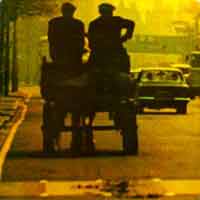 Nach seinem Ausstieg bei den Faces
kaufte Ronnie Lane ein Zirkuszelt, um mit seiner Band Slim Chance
über die Dörfer zu ziehen. Die Sache war leider ein finanzielles
Fiasko, aber es entstanden in dieser Zeit ein paar schöne Alben,
von denen mir dieses erste am besten gefällt. Zur Band gehörten
anfangs auch Graham Lyle und Bernie Gallagher, die später
als Duo und Songschreiber sehr erfolgreich wurden. Die Musik könnte
man als "English Country Music" bezeichnen.
Nach seinem Ausstieg bei den Faces
kaufte Ronnie Lane ein Zirkuszelt, um mit seiner Band Slim Chance
über die Dörfer zu ziehen. Die Sache war leider ein finanzielles
Fiasko, aber es entstanden in dieser Zeit ein paar schöne Alben,
von denen mir dieses erste am besten gefällt. Zur Band gehörten
anfangs auch Graham Lyle und Bernie Gallagher, die später
als Duo und Songschreiber sehr erfolgreich wurden. Die Musik könnte
man als "English Country Music" bezeichnen.

 Mehr ...
Mehr ...
|
"Mixing 1950's roots music with the directness of
music hall whilst adding a fair helping of violin, accordion, mandolin
and airy saxophone shadings, Ronnie Lane came up with a music which was
not folk, definitely not from a yank, hardly straight rock'n'roll, certainly
not cliched and yet one which suggeseted a very real and gentle English
afternoon, one seen from a battered caravan window as it rolled down a
quite country lane for a picnic near a favourite grove of elm, the sea
just visible from beyond a nearby cliff, with ale, sandwiches and a small
wireless at the ready." (Sid Griffin)
"Ronnie Lane of Small Faces and Faces fame. I wonder
if he knew he had MS when he christened his band Slim Chance? Some of
these British folk/country songs are so achingly sad that you almost cry
when you listen to them. Others so joyful that you run around the house
shouting 'Hurr*h!'. Remember (or - have you heard of) Rod Stewart's early
stuff on Mercury? Pre 'Atlantic Crossing'? Rod was also a member of The
Faces when he made those albums. And although Ronnie Lane never played
on any of them, some of the same kind of thinking is in play (sic) here."
|
|
| John Stewart: "The Phoenix Concert" (RCA, Juli 1974) |
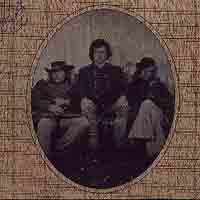 Die
Konzerte, welche John Stewart im März 1974 in Phoenix spielte, gelten
als ein Meilenstein in seiner langjährigen Karriere. Es entstand
ein Konzertmitschnitt, der locker in eine Reihe mit "Running
On Empty" und "Four-Way-Street"
gestellt werden kann. "The Pirates Of Stone County Road", "July
You're A Woman" und "California Bloodlines" gehören
zu den bekannteren Titeln eines durchgängig guten Albums. Die
Konzerte, welche John Stewart im März 1974 in Phoenix spielte, gelten
als ein Meilenstein in seiner langjährigen Karriere. Es entstand
ein Konzertmitschnitt, der locker in eine Reihe mit "Running
On Empty" und "Four-Way-Street"
gestellt werden kann. "The Pirates Of Stone County Road", "July
You're A Woman" und "California Bloodlines" gehören
zu den bekannteren Titeln eines durchgängig guten Albums. |
| Brinsley Schwarz: "New Favourites" (United Artists, Juli 1974) |
 Die letzte Platte der Band um den Sänger, Songwriter und Bassisten
Nick Lowe wurde von Dave Edmunds produziert und enthält
mit "(What's So Funny About) Peace, Love And Understanding"
den Song, der durch die Coverversion von Curtis Stigers vom "Bodyguard-Soundtrack"
weltbekannt wurde und sicherlich nicht unerheblich zu Nick Lowe's Rentensicherung
beiträgt.
Die letzte Platte der Band um den Sänger, Songwriter und Bassisten
Nick Lowe wurde von Dave Edmunds produziert und enthält
mit "(What's So Funny About) Peace, Love And Understanding"
den Song, der durch die Coverversion von Curtis Stigers vom "Bodyguard-Soundtrack"
weltbekannt wurde und sicherlich nicht unerheblich zu Nick Lowe's Rentensicherung
beiträgt.

 Mehr ...
Mehr ...
|
With their final album, Brinsley Schwarz turn in their most pop-oriented
record, filled with infectious gems like "The Ugly Things,"
"Trying to Live My Life Without You," and "(What's So Funny
'bout) Peace, Love and Understanding." Lowe's songs were the best
he had ever written and show that his ambitions were beginning to conflict
with those of the rest of the band. Nevertheless, there isn't a weak song
or uninspired performance on New Favourites, making it an excellent farewell
album.
(by Stephen Thomas Erlewine, All
Music Guide)
|
|
| Jan Garbarek & Bobo Stenson: "Witchi-Tai-To" (ECM, Juli 1974) |
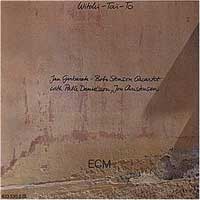 Ende
der 70er war ich in einer heftigen Jazzphase, in der ich mit meinen Kumpels
vor allem ECM-Platten gehört habe (und damals den Punk verschlafen
habe - aber das ist eine andere Geschichte). Jan Garbarek und Bobo Stensons
Platte mit dem Titelsong aus der Feder von Jim Pepper und dem Revolutionslied
"Hasta Siempre" ist mir aus dieser Zeit besonders gut in Erinnerung. Ende
der 70er war ich in einer heftigen Jazzphase, in der ich mit meinen Kumpels
vor allem ECM-Platten gehört habe (und damals den Punk verschlafen
habe - aber das ist eine andere Geschichte). Jan Garbarek und Bobo Stensons
Platte mit dem Titelsong aus der Feder von Jim Pepper und dem Revolutionslied
"Hasta Siempre" ist mir aus dieser Zeit besonders gut in Erinnerung. |
| Ian Matthews: "Some Days You Eat The Bear ..." (Reprise, Juli 1974) |
 |
| Neil Young: "On The Beach" (Reprise, Juli 1974) |
|
 Skandalös: "On The Beach" ist eine der besten Neil Young-Platten
- und es gibt sie immer noch nicht auf CD: ich hab mir deshalb jetzt
selber eine CD-Version gebastelt, damit ich sie auch im Auto hören
kann. Allen denen, die Herrn Young nur von seinem Hitalbum "Harvest"
her kennen, ist diese Platte allerdings nicht zu empfehlen: sie ist
wunderbar depressiv und völlig unkommerziell. Zu meiner Schande
muss ich gestehen, dass auch ich sie damals kurz nach Harvest nicht
verstanden habe und sie erst Jahre später zu schätzen lernte.
Skandalös: "On The Beach" ist eine der besten Neil Young-Platten
- und es gibt sie immer noch nicht auf CD: ich hab mir deshalb jetzt
selber eine CD-Version gebastelt, damit ich sie auch im Auto hören
kann. Allen denen, die Herrn Young nur von seinem Hitalbum "Harvest"
her kennen, ist diese Platte allerdings nicht zu empfehlen: sie ist
wunderbar depressiv und völlig unkommerziell. Zu meiner Schande
muss ich gestehen, dass auch ich sie damals kurz nach Harvest nicht
verstanden habe und sie erst Jahre später zu schätzen lernte.
Inzwischen schon! Vielleicht musste ich aber erst meine Privat-CD brennen,
damit die "echte" wiederververöffentlicht
wurde! Was? Ihr kennt doch sicherlich die Geschichte von dem Schlag
eines Schmetterlingsflügels über kosmische Zusammenhänge
...
(10.08.2003)

 Mehr ...
Mehr ...
|
"Young chose to include an old song, "See the
Sky About to Rain." Some reviewers have suggested that it is an attempt
at irony on Young's part to include a prime example of his "downer"
songs here, after the sentiments expressed in "Walk On," but
it's just a great song with a magical chord progression change at the
last verse and superb drumming from Levon Helm. It is followed by "Revolution
Blues," a song inspired by Young's meetings with Manson. One can
almost hear the 10,000,000 dune buggies coming down the mountain as the
song rolls along with the Band's Levon Helm and Rick Danko in the engine
room, and David Crosby supplying manic rhythm guitar."
(Sam Tennent, All Music
Guide)
|
|
| Leonard Cohen: "New Skin For The Old Ceremony" (Columbia, Aug. 1974) |
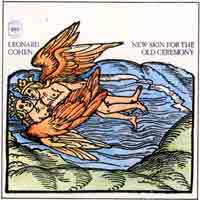 Dies
ist das erste Album, was ich damals von dem kanadischen Poeten gehört
habe. Da ich auch kein sonderlicher Kenner der Materie bin, weiß ich nicht,
ob das jetzt ein "wichtiges" Cohen-Album ist oder nicht. Es
enthält auf jeden Fall einige gute Songs, die ich nach langen Jahren
des Nichthörens immer noch mehr oder weniger fehlerfrei im Ohr habe:
"Is This What You Wanted", natürlich "Lover, Lover,
Lover" und "Who By Fire", aber auch "Why Don´t
You Try". Dies
ist das erste Album, was ich damals von dem kanadischen Poeten gehört
habe. Da ich auch kein sonderlicher Kenner der Materie bin, weiß ich nicht,
ob das jetzt ein "wichtiges" Cohen-Album ist oder nicht. Es
enthält auf jeden Fall einige gute Songs, die ich nach langen Jahren
des Nichthörens immer noch mehr oder weniger fehlerfrei im Ohr habe:
"Is This What You Wanted", natürlich "Lover, Lover,
Lover" und "Who By Fire", aber auch "Why Don´t
You Try". |
| Ian Matthews: "Journeys From Gospel Oak" (Mooncrest, Aug. 1974) |
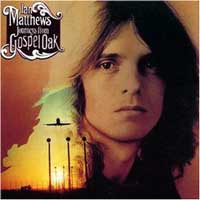 Ein unterbewertetes Album, entstanden bereits 1972 zur Erfüllung des
Solovertrags bei Vertigo, während Matthews bereits mit seiner neuen
Band Plainsong beschäftigt
war und dafür auch schon einen Vertrag bei Elektra unterzeichnet
hatte. Das Budget für "Journeys..." war entsprechend klein
und am Ende wurde das Produkt an die kleine Firma Mooncrest verkauft,
die es erst 1974 veröffentlichte. Zu der Zeit war für Matthews
auch Plainsong schon längst
wieder Geschichte und es gab mit "Valley
Hi" und "Someday You Eat The Bear.." bereits 2 neue
Alben von Matthews. Was bleibt? Trotz allem ein schönes Album mit
kleiner, aber feiner Band (Andy Roberts von Plainsong
an der akustischen und Jerry Donahue von Fotheringay
und Fairport Convention an der elektrischen
Gitarre, Timi Donald am Schlagzeug und Pat Donaldson von
Fotheringay am Bass) und gutem
Songmaterial u.a. von Tim Hardin, Mickey Newbury, Jimmy Webb, Paul Siebel
und Merl Haggard.
Ein unterbewertetes Album, entstanden bereits 1972 zur Erfüllung des
Solovertrags bei Vertigo, während Matthews bereits mit seiner neuen
Band Plainsong beschäftigt
war und dafür auch schon einen Vertrag bei Elektra unterzeichnet
hatte. Das Budget für "Journeys..." war entsprechend klein
und am Ende wurde das Produkt an die kleine Firma Mooncrest verkauft,
die es erst 1974 veröffentlichte. Zu der Zeit war für Matthews
auch Plainsong schon längst
wieder Geschichte und es gab mit "Valley
Hi" und "Someday You Eat The Bear.." bereits 2 neue
Alben von Matthews. Was bleibt? Trotz allem ein schönes Album mit
kleiner, aber feiner Band (Andy Roberts von Plainsong
an der akustischen und Jerry Donahue von Fotheringay
und Fairport Convention an der elektrischen
Gitarre, Timi Donald am Schlagzeug und Pat Donaldson von
Fotheringay am Bass) und gutem
Songmaterial u.a. von Tim Hardin, Mickey Newbury, Jimmy Webb, Paul Siebel
und Merl Haggard. |
| Hawkwind: "Hall Of The Mountain Grill" (United Artists, Sept. 1974) |
 Der Titel bringt Richard Wagner und eine Imbissstube zusammen: vielleicht
etwas bizarr - aber gar nicht so falsch! Ein eher unbekanntes, aber sehr
schönes Album meiner alten Helden.
Der Titel bringt Richard Wagner und eine Imbissstube zusammen: vielleicht
etwas bizarr - aber gar nicht so falsch! Ein eher unbekanntes, aber sehr
schönes Album meiner alten Helden. |
| Little Feat: "Feats Don't Fail Me Now" (Warner, Sept. 1974) |
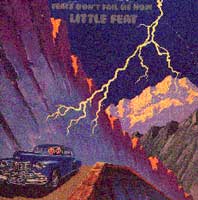 Bis auf Little Feat (und vielleicht noch Steely Dan)
müsste man die Mitsiebziger (ca. 1974-75) als das absolute Jammertal
der Rockmusik bezeichnen, was auch dieses Album wieder einrucksvoll bestätigte,
auf dem man eigentlich keinen der tollen Songs besonders hervorheben muss.
Bis auf Little Feat (und vielleicht noch Steely Dan)
müsste man die Mitsiebziger (ca. 1974-75) als das absolute Jammertal
der Rockmusik bezeichnen, was auch dieses Album wieder einrucksvoll bestätigte,
auf dem man eigentlich keinen der tollen Songs besonders hervorheben muss. |
| The Neutrons: "Black Hole Star " (United Artists, Sept. 1974) |
 Ein interessanter Man-Ableger mit Phil Ryan (keyb)
und Will Youatt (g) und John Weathers (dr).
Ein interessanter Man-Ableger mit Phil Ryan (keyb)
und Will Youatt (g) und John Weathers (dr). |
| Robert Palmer: "Sneakin' Sally Thru The Alley" (Island, Sept. 1974) |
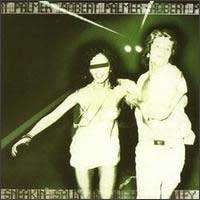 Mal wieder ein Fund aus der Grabbelkiste!
Mal wieder ein Fund aus der Grabbelkiste!

 Mehr ...
Mehr ...
|
Before becoming a slick, sharp-dressed pop star in the 1980s, Robert
Palmer was a soul singer deeply rooted in R&B and funk. Those influences
are on full display on his debut album Sneakin' Sally Through the Alley.
With a backing band including members of Little Feat and the Meters, the
music has a laid-back groove whether Palmer's covering New Orleans legend
Allen Toussaint (the title track) or singing originals ("Hey Julia,"
" Get Outside"). While the music is tight and solid, it is Robert
Palmer's voice that is revelatory -- he sounds supremely confident among
these talented musicians, and they seem to feed off his vocal intensity.
Fans of the Meters or people who want to discover the funky side of Robert
Palmer should check this one out.
(by Vik Iyengar, All
Music Guide)
|
|
| Carlos Santana & Alice Coltrane: "Illuminations" (Columbia, Sept. 1974) |
 Carlos und die Jazzharfinistin und Witwe des legendären Saxofonisten kamen
sich möglicherweise näher, als beide beim Guru Sri Chinmoy
(oder so ähnlich) abhingen, aber sicherlich eher aus musikalischen
Gründen, denn schon auf "Love,
Devotion & Surrender" seiner Zusammenarbeit mit John McLaughlin,
wurde Santanas Begeisterung für die Musik John Coltranes deutlich.
Und weil die Rockband Santana damals Unmengen von Platten
verkaufte und es noch keine Krise der Musikindustrie gab wurde ihm wohl
von seinen Chefs bei CBS dieses "unkommerzielle" Jazzalbum gestattet.
Quasi, um den Star bei Laune zu halten. Auch ich fand die Platte bei der
Veröffentlichung doof, bzw. hab sie nicht verstanden - ich war dafür
einfach noch zu jung. Kürzlich hab ich sie für den Preis von
etwa zwei Glas Bier bei 2001 entdeckt und gekauft. Jetzt muß ich
klar geststellen: gute Platte. U.a. mit Jack
DeJohnette und Dave Holland, sowie
der Rhythmus & Rasseltruppe von Santana.
Carlos und die Jazzharfinistin und Witwe des legendären Saxofonisten kamen
sich möglicherweise näher, als beide beim Guru Sri Chinmoy
(oder so ähnlich) abhingen, aber sicherlich eher aus musikalischen
Gründen, denn schon auf "Love,
Devotion & Surrender" seiner Zusammenarbeit mit John McLaughlin,
wurde Santanas Begeisterung für die Musik John Coltranes deutlich.
Und weil die Rockband Santana damals Unmengen von Platten
verkaufte und es noch keine Krise der Musikindustrie gab wurde ihm wohl
von seinen Chefs bei CBS dieses "unkommerzielle" Jazzalbum gestattet.
Quasi, um den Star bei Laune zu halten. Auch ich fand die Platte bei der
Veröffentlichung doof, bzw. hab sie nicht verstanden - ich war dafür
einfach noch zu jung. Kürzlich hab ich sie für den Preis von
etwa zwei Glas Bier bei 2001 entdeckt und gekauft. Jetzt muß ich
klar geststellen: gute Platte. U.a. mit Jack
DeJohnette und Dave Holland, sowie
der Rhythmus & Rasseltruppe von Santana.
(ca. 2003) |
| Starry Eyed & Laughing (Columbia, Sept. 1974) |
|
 Benannt nach einer Dylan-Textzeile und mit einem hauptamtlichen Rickenbacker-12string
Gitarristen sind die Byrds-Vergleiche bei dieser englischen Band natürlich
unvermeidlich. Aber: es gibt ausschließlich eigenes hochkarätiges
Songmaterial, das seine historischen Referenzen nicht verleugnet. Außerdem
klingt die Ricky hier besser als jemals bei Roger McGuinn geklungen
hat. Es gibt auch ein paar interessante musikalische Gäste: Englands
Pedalsteel-Legende B.J.Cole, Lindisfarnes Mandolinenspieler
Ray Jackson (der ja auch schon Rolf Stuttgarts "Maggie May"
veredelt hat) und Gitarrist/Komponist Russ Ballard von Argent
am Piano.
Benannt nach einer Dylan-Textzeile und mit einem hauptamtlichen Rickenbacker-12string
Gitarristen sind die Byrds-Vergleiche bei dieser englischen Band natürlich
unvermeidlich. Aber: es gibt ausschließlich eigenes hochkarätiges
Songmaterial, das seine historischen Referenzen nicht verleugnet. Außerdem
klingt die Ricky hier besser als jemals bei Roger McGuinn geklungen
hat. Es gibt auch ein paar interessante musikalische Gäste: Englands
Pedalsteel-Legende B.J.Cole, Lindisfarnes Mandolinenspieler
Ray Jackson (der ja auch schon Rolf Stuttgarts "Maggie May"
veredelt hat) und Gitarrist/Komponist Russ Ballard von Argent
am Piano.
Die im Covertext gezeigte Euphorie hat leider zu keiner großen Karriere
gereicht. Im Jahr 1975 gab's zwar noch mit "Thought
Talk" ein ebenso gutes Nachfolgeralbum und sogar einen Fernsehauftritt
im ARD (Musikladen? Musiksack? Oder wie die Sendung als Vorläufer
zum Rockpalast auch immer geheißen hat), dann war Schluss. Es hat im
Grunde noch nicht mal zu einer Fussnote in der Rockgeschichte gereicht,
denn in kaum einem Rocklexikon kommen sie vor - das ist sehr schade
und völlig ungerecht. Natürlich gibt's auch bisher keine CD-Wiederveröffentlichung,
weshalb ich mir genauso wie bei Neil Youngs "On
The Beach" und "Time
Fades Away" eine eigene Starry Eyed-CD mit beiden Alben gebastelt
habe. Immerhin gibt es aber eine informative
Internetseite dazu.

 Mehr ...
Mehr ...
|
Originally a distinctly Byrds-influenced duo of guitarist/vocalists Ross
McGeeney and Tony Poole (and thus instantly comparable to an early R.E.M.),
Starry Eyed and Laughing were one of the most individual acts to gravitate
toward the London pub rock scene as the 1970s neared their midpoint. Formed
in the midlands city of Northampton during 1973, within a year the band
had swollen to a quartet comprising McGeeney, Poole, bassist Steve Hall,
and drummer Nick Brown and were packing venues across the capital. This
lineup survived only a matter of months, but did bring the band to the
attention of CBS. With a new rhythm section of Iain W hitmore and the
splendidly named drummer Mick Wackford, plus a cast of guests including
Russ Ballard, Lindisfarne's Ray Jackson, and BJ Cole, Starry Eyed and
Laughing cut their eponymous debut album in mid-1974, alongside the single
"Money Is No Friend of Mine."
A second album, Thought Talk, followed in 1975, together with further
singles "Nobody Home" and Good Love," and that fall, Starry
Eyed and Laughing made their U.S. debut with a short, but very well-received
tour. Upon returning home, however, McGeeney quit the band -- he was replaced
by Roger Kelly for the 1976 single "Don't Give Me a Hard Time,"
before bassist Whitmore, too, departed.
Opting to continue on as a trio, the band abbreviated its name to Starry
Eyed alone, but never recaptured the excitement of earlier years and broke
up soon after.
(by Dave Thompson, All
Music Guide)
|
|
|
"Where do you start? How about with the name?
Yeah. Starry Eyed And Laughing, as all good Dylanophiles know, is the
first line of the last verse of "Chimes Of Freedom". It's the
sort of name you probably won't forget, and it's also to be a great extent
onomatopoaeic (which means it sounds like it looks). They don't laugh
out of context, mind you, and after all that motorway food, stars in the
eyes could prove a little difficult, but the sound is basically that produced
by optimists, and the songs are unlikely to lead to dispair even in the
most downtrodden of lives.
It's my contention, and several tasteful writers agree, that Starry Eyed
And Laughing come several miles nearer to successfully adapting that jingly
jangly Californian style, complete with original material, than anyone
so far. Tony Poole (12string-player) says his group's music "guaranteed
to take you higher". Should I explain what he means by "higher"?
Too much time and vinyl are taken up with ramblings. Here is the music
that belongs to everyone - yours to enjoy."
(Covertext von John Tobler)
|
|
| Supertramp: "Crime Of The Century" (A&M, Sept. 1974) |
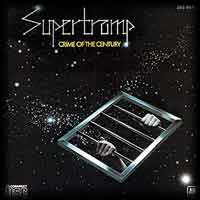 An dieser Platte kam man 1974 eigentlich nicht vorbei: Supertramp schufen
ein wunderbares Album mit tollen Songs und vor allem einem tollen Sound
(zwei starke Sänger/Songschreiber, die Mundharmonika, aber vor allem
das Wurlitzer-Piano). Danach haben sie diese Erfolgsformel aber zu Tode
geritten und wurden dabei zu Weltstars. Was bleibt, ist dieses eine Album,
das man auch heute noch mit Begeisterung hören kann.
An dieser Platte kam man 1974 eigentlich nicht vorbei: Supertramp schufen
ein wunderbares Album mit tollen Songs und vor allem einem tollen Sound
(zwei starke Sänger/Songschreiber, die Mundharmonika, aber vor allem
das Wurlitzer-Piano). Danach haben sie diese Erfolgsformel aber zu Tode
geritten und wurden dabei zu Weltstars. Was bleibt, ist dieses eine Album,
das man auch heute noch mit Begeisterung hören kann. |
| Traffic: "When The Eagle Flies" (Island, Sept. 1974) |
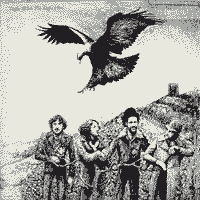 Der Flug des Adlers war der Schwanengesang von Traffic: danach startete Steve
Winwood seine Solokarriere, hat dabei aber m. E. nie mehr die Qualität
von Traffic erreicht. "Dream Gerard" mit dem tollen Saxofonspiel
von Chris Wood war damals ein echter Tanzbodenfeger in unserer
Lieblingsrockdisco "Old Daddy" in Duisburg (die gibt's immer
noch!)
Der Flug des Adlers war der Schwanengesang von Traffic: danach startete Steve
Winwood seine Solokarriere, hat dabei aber m. E. nie mehr die Qualität
von Traffic erreicht. "Dream Gerard" mit dem tollen Saxofonspiel
von Chris Wood war damals ein echter Tanzbodenfeger in unserer
Lieblingsrockdisco "Old Daddy" in Duisburg (die gibt's immer
noch!) |
| John Cale: "Fear" (Island, Okt. 1974) |
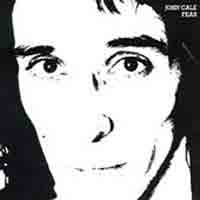 Cale erste Platte bei Island (wenn man mal "June,
1st" außen vor lässt) gilt zu Recht als eine seiner besten.
Besonders gerne mag ich das Lied "Buffalo Ballet", das auch
lange im Repertoire von Waiting For Louise war.
Cale erste Platte bei Island (wenn man mal "June,
1st" außen vor lässt) gilt zu Recht als eine seiner besten.
Besonders gerne mag ich das Lied "Buffalo Ballet", das auch
lange im Repertoire von Waiting For Louise war.

 Mehr ...
Mehr ...
"By 1974 Cale all but abandoned the 'no-bull-experimental'
approach to making music, especially after his early Seventies' modern classical
efforts brought him next to no audience except for dedicated cult followers.
Not that Fear was a bestseller, of course; but it's still one of John's
most critically laudable albums, and for good reason. When I first bought
it, I thought it would be something spooky beyond recognition. And my suspicions
were all but groundless, considering it was my first acquaintance with John's
solo career. Just put all the facts together: the most vicious experimentator
in the rows of the Velvet Underground puts out a record called Fear on which
he's pictured in black and white, no smile, hell, no expression at all.
He also teams up with Eno (credited for 'Eno' on the album!! I mean, it
says - 'guitars: Phil Manzanera, John Cale', etc., etc., 'Eno: Eno'), and
comes up with song titles like 'Fear Is A Man's Best Friend', 'Gun', and,
oh me my God, 'The Man Who Couldn't Afford To Orgy'.
Now let me disappoint those who are looking forward to spend the evening
accompanied by an audio analog of the creepiest horror flick in existence.
All of these things are deceiving - this is a peaceful, quiet album, full
to the brink with stripped-down arrangements, sad, melancholic piano/acoustic
ballads, very moderate experimental tunes, and only a small ounce of true
darkness and paranoia. Eno himself shows up only occasionally, particularly
on 'Gun' (and probably 'Barracuda'), and his contributions, as always, are
minimalistic and tremendously effective. And the tunes themselves are swell;
their only flaw is that none are particularly memorable, as I suddenly figured
out after the fourth 'airing' of the record. I understand critics who keep
complaining about Cale's songwriting abilities never ranking up there with
Lou Reed's: the instrumental melodies are mostly simplistic beyond hope
(hell, 'Emily', the most beautiful ballad on the record, is based on, like,
an endless repetition of four notes! Figures), and it's not the Beatles-style
genial simplicity, too: Cale very rarely scales any epic or cathartic heights.
This, however, does not mean that these are tunes you must listen to once
or twice and dismiss as 'dated' or 'lightweight'. As we all know, Cale has
a musical lingo of his own, somewhat similar to but also somewhat different
from Lou Reed's, and Fear is an excellent example. Basically, John just
grabs a bunch of musical genres and styles and throws them all together
in a fascinating melting pot. Meaningless? Perhaps. Senseless? Probably.
Hopelessly out of time? Definitely, but that's what makes the record so
much more exciting today.
So what do we have here? 'Fear Is A Man's Best Friend' is vintage Cale,
his own inimitable style based on a simple piano pattern with haunting psycho
imagery strewn over it: 'Darkness warmer than a bedroom floor/Want someone
to hold me close forever more/I'm a sleeping dog, but you can't tell/When
I'm on the prowl you'd better run like hell', and the classic word of pessimism
to end it all - 'Fear is a man's best friend/You add it up it brings you
down'. I'm not exactly pleased by the way he howls out the refrain over
and over again at the end of the tune when the music has already faded away,
but that's a matter of taste and tolerance. But if this track can be said
to represent Cale's true face (note - I'm not sure about that), then nothing
else on the album does.
What can be said of 'Buffalo Ballet'? A country-western song of lament for
the vast plains of America and the buffalos exterminated by choo-choo trains?
(The melody is ripped off from Dylan's 'Knockin' On Heaven's Door', but
hey, you never heard me say that...) Is it Cale? The violas are probably
Cale, but little else is; yet the tune is beautiful, peaceful and majestic,
even if it never reaches the devastating effect of the 'original'. And what
about the above-mentioned 'Emily'? The Velvet Underground? A powerful operatic
ballad it is, slightly reminiscing of an underarranged Queen song (only
better), with stately ocean noises in the background and beautiful, fully
suitable female backing voices on the 'maybe we'll love again' chorus. Then
again, somebody might probably compare it to Sinatra. I suppose I'll just
cut out the comparisons, thank you very much... 'The Man Who Couldn't Afford
To Orgy' turns out to be a jolly, somewhat hilarious 'pseudo-doo-wop' ditty
with sexy female overdubs and a philosophical message - turns out that we're
supposed to pity the actual fellow. 'You Know More Than I Know' is 'Emily
Volume 2', but just as pretty - perfect mood music for those who can't tolerate
ambient and who are too tasteful to be entertained by Phil Collins.
There are some rabble-rousing tracks on here, too: Cale does pay his dues
to loudness and electronis psychopathy. Then again, it's not just Cale.
On 'Momamma Scuba' it's Cale paying tribute to Morrison - truthfully, he
sounds exactly like Jim, and the song's 'tribal' character only emphasizes
the analogy. And 'Barracuda' is Cale paying tribute to good old España,
peppered with Eno and spiced up with just a trifle dissonance. This is also
the place where you'll finally encounter the main proof that this is a Cale
recording - a nearly-atonal, feedbacky violin solo. But if you're still
hungry after the Velvets, look forward to the album's centerpiece - the
eight-minute 'Gun'. This is where Cale really rocks out, first time since
he left the band in 1968. The tune might be, in fact, viewed as a logical
successor to 'Sister Ray', except that it's shorter, more explicit (the
lyrics are sung from the point of view of a, ahem, mutilated outlaw), and
supposedly features Phil Manzanera on the crazyass guitar solos, so it has
more chances to put you into a trance than 'Sister Ray' ever had.
In this way, Fear turns out to be just about the best introduction to Cale's
solo work: diverse, entertaining and rich with musical and emotional content,
even if short on catchy melodies. It also heralds a series of firsts - Cale's
re-appearance as a credible, sincere rocker, for one, and maybe even more
important - the beginning of his long-time association with Eno. The two
geniuses of Bizarre Sonic Textures have finally met each other and they
couldn't go wrong; over the next twenty years, they would often collaborate
on each other's records." |
|
| Gene Clark: "No Other" (Elektra/Asylum, Okt. 1974) |
 Dies ist ganz eindeutig das beste Album des Ex-Byrd!
Genial überproduziert: wie bei "Sgt. Pepper" stimmt jeder
Song. Und ähnlich wie Jackson Browne's "Late
For The Sky" sollte man dies Platte unbedingt komplett durchhören!
Eine meiner allerliebsten Platten für die einsame Insel. Leider sah
es die Plattenfirma nicht so, machte keine Promotion und schmiss Gene
Clark bald danach raus. Unbegreiflich!
Dies ist ganz eindeutig das beste Album des Ex-Byrd!
Genial überproduziert: wie bei "Sgt. Pepper" stimmt jeder
Song. Und ähnlich wie Jackson Browne's "Late
For The Sky" sollte man dies Platte unbedingt komplett durchhören!
Eine meiner allerliebsten Platten für die einsame Insel. Leider sah
es die Plattenfirma nicht so, machte keine Promotion und schmiss Gene
Clark bald danach raus. Unbegreiflich!

 Mehr ...
Mehr ...
|
Upon its release in 1974, Gene Clark's No Other was soundly reviled as an exercise
in studio and financial excess, a critical and commercial failure -- it was
pop music's Heaven's Gate. However, a scant year and a half later, Fleetwood
Mac's self-titled album and its successor, Rumours, utilizing similar performance
and production techniques, were adored by critics and the record-buying public,
and have become cultural mainstays. The appearance of No Other on CD in America
some 26 years after its release offers the opportunity to hear this record for
what it was: a solidly visionary recording that decided to use every available
means to illustrate Gene Clark's razor sharp songwriting that lent itself to
open-ended performance and production -- often in the same song (one listen
to the title track bears this out in spades). Clark and producer Thomas Jefferson
Kaye entered Village Recorders in L.A. assembled a cast of players that included
Clark veterans such as Michael Utley and Jesse Ed Davis, Allman Brothers' Butch
Trucks, Lee Sklar, Russ Kunkel, Joe Lala, Chris Hillman, Danny "Kooch"
Kortchmar, Howard Buzzy Feiten, and Stephen Bruton. Backing vocalists such as
Clydie King, Venetta Field, and Shirley Matthews -- who would appear on Bob
Dylan's Street Legal two years later -- and including Cindy Bullens, Carlena
Williams, Ronnie Barron, Claudia Lennear, and the Eagles' Timothy B. Schmidt,
were also in the house. What it adds up to is sprawling, ambitious work that
brought elements of country, folk, jazzed-out gospel, blues, and trippy rock
to bear on a song cycle that reflects the mid-'70s better than anything from
that time, yet sounds hauntingly timely even now. There are no edges on No Other,
even in its rockier tracks such as "Strength Of Strings," that echoes
Neil Young's "Cowgirl In the Sand," melodically, but its bridge is
pure mystic Eastern-harmony, complete with slide guitar wizardry. The shimmering
dark textures of "Silver Raven," where Clark's falsetto vocal is kissed
by synth and muted bass lines, and extended by a chorus that could have come
off CSNY's Déjà Vu, is one of the most heartbreakingly blissed-out
country folk songs in recorded music history. "From A Silver Phial,"
as haunting and beautiful as it is, is one of the strangest songs Clark ever
wrote, given its anti-drug references (especially considering this is one of
the more coked out records to come from L.A. during the era). The final two
cuts, "The True One," and "Lady of the North" (co-written
with Doug Dillard) are the only two pieces on the disc that mirror back with
accuracy where Clark had come from, but even these, as they wind around the
listener, are far bigger than mere country rock tunes, and they offer glissando
passages of pedal steel and ostinato piano that create narrative movement in
the lyrics. This is one of those<\i> recordings, one that is being rediscovered
for the masterpiece it is. The shortcoming of the CD presentation is that the
rest of the session is not here -- it was originally cut as a double-album,
but Asylum refused to release it that way. There are versions with alternate
takes, but so far only the WEA International version has an additional track.
But this is what we have,and as it stands it is a stunning, if completely misunderstood
milestone, in Clark's oeuvre.
~Thom Jurek, All Music Guide
|
|
|
When Gene Clark left The Byrds in 1966, he immediately released several
critically acclaimed but commercially unsuccessful albums, both as a solo
artist and in collaboration with the Gosdin Brothers and Doug Dillard.
When Clark rejoined The Byrds for a 1973 tour and album the results were
largely uninspired (as cash grabs generally are), but Clark’s contributions
to the album stood out enough that Asylum Records head honcho David Geffen
decided to sign Clark as a solo artist. He even gave Clark a then whopping
$100,000 budget, which Clark and producer Thomas Jefferson Kaye were determined
to spend in an attempt to create an ambitious masterpiece that would finally
gain Clark the widespread acclaim he deserved.
The result of their labors has long been out of print on both sides of
the Atlantic, but Collectors’ Choice Music has finally rescued No
Other from undeserved obscurity. The album begins with “Life’s
Greatest Fool,” one of three songs here (the others being “From
A Silver Phial” and “The True One”) with a loping country
melody. Of course, it’s the gospel backing vocals and upbeat, catchy
“do you believe” chorus that makes this such a standout song.
The guitar playing is also impressive, as it is throughout the album,
whether by Clark himself or in tandem with several hired session aces.
“Silver Raven” continues with an atmospheric ballad that lingers,
in part due to Thomas Jefferson Kaye’s appropriately haunting, echo-laden
production.
Throughout the album, it is this attention to detail that makes No Other
such a richly rewarding experience. Of course, Clark’s strong songwriting
is the main thing that impresses, particularly on songs such as the title
track, which mixes together jazz, funk, and psychedelia before really
taking off on its Latin-tinged percussion. “Strength Of Strings”
is another ambitious epic, on which its choral vocals build dramatically.
Perhaps it’s a little too slow paced and extravagant for its own
good, but I’d still describe this song as “flawed but fascinating,”
just like the album itself.
Indeed, songs such as the 8-minute “Some Misunderstanding”
and the 6-minute “Lady Of The North” are other grand showcases
for Clark and Kaye’s overflowing ambition. The former is a dreamy
orchestral ballad with yet more great guitar, while the latter at times
reminds me of Neil Young’s “Broken Arrow,” primarily due
to its elaborate production. To counteract these songs, which are highly
successful upon repeat listens (especially "Lady Of The North")
but which are difficult to sink your teeth into at first, comes more straightforward
fare in the form of “From A Silver Phial” and “The True
One.” The former again features terrific guitar playing (and harmonies),
while the latter delivers more modest pleasures, but both provide welcome
breaks from the at-times excessive experimentation.
Fortunately, most of the experimentation is successful, though the album
is a little slow going at times, and obviously overblown at others. Yet
Clark’s sure songwriting touch almost always manages to seize the
day, and though he’s merely a serviceable singer, his plaintive vocals
fit his material. Granted, occasional “hippy” lyrics might make
the album sound “dated” to some, but its creative mishmash of
several styles should ensure its freshness to the majority of listeners.
Alas, when Clark handed the album to Geffen he was less than impressed
with it’s mere eight songs (he obviously hadn’t heard of Led
Zeppelin IV!), and the under-promoted album came and went with little
fanfare. Clark’s career never really recovered, and ill health coupled
with an aversion to touring further ensured that he would always remain
a musician whose commercial stature far undersold his musical talent.
Rarely was the breadth of his talents put on better display than on this
welcome reissue, which still sounds like no other album I’ve ever
heard.
Scott Floman
|
|
| Ducks Deluxe: "Taxi To Terminal Zone" (RCA, Okt. 1974) |
 Neben Brinsley Schwarz galten die Luxusenten als
wichtigste Band der englischen Pubrockszene. Ohne selber kommerziell wirklich
erfolgreich zu sein, waren sie aber vor allem das Sprungbrett für
Folgekarrieren: Sänger Sean Tyla (vorher Roadie bei Help
Yourself) konnte mehr oder weniger erfolgreich die Tyla
Gang in's Rennen schicken, Gitarrist Martin Belmont spielte
zuerst lange Jahre für Graham Parker
und anschließend für Nick Lowe.
Am erfolgreichsten waren aber Nick Garvey und Andy Mcmasters,
die mit den Motors mehrere Hits (z.B.
"Airport") landen konnten.
Neben Brinsley Schwarz galten die Luxusenten als
wichtigste Band der englischen Pubrockszene. Ohne selber kommerziell wirklich
erfolgreich zu sein, waren sie aber vor allem das Sprungbrett für
Folgekarrieren: Sänger Sean Tyla (vorher Roadie bei Help
Yourself) konnte mehr oder weniger erfolgreich die Tyla
Gang in's Rennen schicken, Gitarrist Martin Belmont spielte
zuerst lange Jahre für Graham Parker
und anschließend für Nick Lowe.
Am erfolgreichsten waren aber Nick Garvey und Andy Mcmasters,
die mit den Motors mehrere Hits (z.B.
"Airport") landen konnten. |
| Jan Garbarek/Keith Jarrett: "Belonging" (ECM, Okt. 1974) |
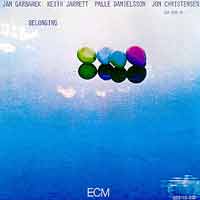 Eine der ersten ECM-Jazzplatten, die ich Mitte der 70er gehört habe und
immer noch einer meiner Favoriten aus dieser Zeit. Der amerikanische Wunderpianist
Keith Jarrett nahm zusammen mit dem norwegischen Saxofonisten Jan
Garbarek und dessen skandinavischer Rhythmusgruppe (Palle Danielsson
am Bass und Jon Christensen am Schlagzeug) einige seiner besten
Stücke auf. Gefällt mir besser als sein viel berühmteres
Solo-Live-Doppelalbum "The Köln Konzert"!
Eine der ersten ECM-Jazzplatten, die ich Mitte der 70er gehört habe und
immer noch einer meiner Favoriten aus dieser Zeit. Der amerikanische Wunderpianist
Keith Jarrett nahm zusammen mit dem norwegischen Saxofonisten Jan
Garbarek und dessen skandinavischer Rhythmusgruppe (Palle Danielsson
am Bass und Jon Christensen am Schlagzeug) einige seiner besten
Stücke auf. Gefällt mir besser als sein viel berühmteres
Solo-Live-Doppelalbum "The Köln Konzert"! |
| King Crimson: "Red" (Island/EG, Okt. 1974) |
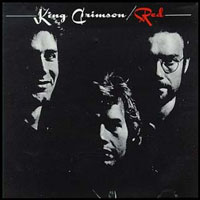

 Mehr ...
Mehr ...
King Crimson fell apart once more, seemingly for the last time, as David Cross walked away during the making of this album. It became Robert Fripp's last thoughts on this version of the band, a bit noiser overall but with some surprising sounds featured, mostly out of the group's past -- Mel Collins' and Ian McDonald's saxes, Marc Charig's cornet, and Robin Miller's oboe, thus providing a glimpse of what the 1972-era King Crimson might've sounded like handling the later group's repertory (which nearly happened). Indeed, Charig's cornet gets just about the best showcase it ever had on a King Crimson album, and the truth is that few intact groups could have gotten an album as good as Red together. The fact that it was put together by a band in its death throes makes it all the more impressive an achievement. Indeed, Red does improve in some respects on certain aspects of the previous album -- including "Starless," a cousin to the prior album's title track -- and only the lower quality of the vocal compositions keeps this from being as strongly recommended as its two predecessors.
(by Bruce Eder, All Music Guide)
|
| Kraan: "Andy Nogger" (Intercord/Spiegelei, Okt. 1974) |
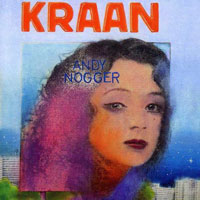 Drittes Album der deutschen Band, die sich elegant zwischen Kraut- und
Jazzrock bewegte. Gleichzeitig letztes Album der "klassischen"
Quartettbesetzung mit Hellmut Hattler (Bass), Peter Wohlbrandt
(Gitarre), Jan Fride Wohlbrandt (Schlagzeug) und Johannes Pappert
(Altsaxofon).
Drittes Album der deutschen Band, die sich elegant zwischen Kraut- und
Jazzrock bewegte. Gleichzeitig letztes Album der "klassischen"
Quartettbesetzung mit Hellmut Hattler (Bass), Peter Wohlbrandt
(Gitarre), Jan Fride Wohlbrandt (Schlagzeug) und Johannes Pappert
(Altsaxofon).
(10.03.2017)

 Mehr ...
Mehr ...
... Sie verbanden swingende Funkriffs und raunzige Saxophonsoli mit treibenden Rhythmen und jazzigen H�henfl�gen und mixten das Ganze mit einer Prise verschrobenen Humors. Dass Kraan zu den besten deutschen Gruppen der 70er Jahre und zu den wenigen Formationen z�hlte, deren Platte trotz ihres Alters kaum Patina angesetzt haben, das belegen die CD-Wiederver�ffentlichungen. Immer noch ragt das Album 'Andy Nogger' heraus, mit dem sich Kraan 1974 etablierte.
(M. Gillig in HiFiVision 5 / 91)
Andy Nogger was the last studio album from Kraan's original lineup, and it is an excellent summary of their various influences, as well as what the band made of them. The title track is as experimental as it is engaging, with electronically mutated sax tones providing an underpinning to a bright guitar-led melody. "Nam Nam" is as close as Kraan ever got to being a straight-ahead rock band, and on the evidence they would have been a good one. Here and on tracks like the funky Home the band creates a remarkable instrumental interplay which would be exhibited even better on their Live album. Other tracks, such as "Son of the Sun" and "Yellow Bamboo" seamlessly blend tropical and Middle Eastern rhythms with electronic noodling. The thing that makes his album indispensable for Kraan fans is the studio version of "Holiday Am Marterhorn," a concert favorite that is always a starting point for an extended jam and brilliant soloing. The version on this album is almost the only track without any electronic effects -- a wise decision, since it is impossible to imagine anything that might have improved it. Though Kraan explores various ideas on this album everything fits together well and sounds like natural exploration of styles rather than a contrived attempt to reach another audience. Andy Nogger is the best studio album this band ever did, and it hasn't aged a bit.
(by Richard Foss, All Music Guide)
|
| Man: "Slow Motion" (United Artists, Okt. 1974) |
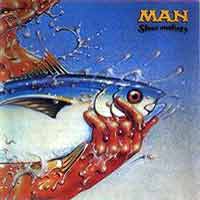 Eigentlich war 1974 ja eher ein Tiefpunkt der Rockmusik - und Man
haben mal wieder alles falsch gemacht, indem sie genau in diesem Jahr
gleich zwei Alben - zwei ihrer besten! - veröffentlicht haben.
Eigentlich war 1974 ja eher ein Tiefpunkt der Rockmusik - und Man
haben mal wieder alles falsch gemacht, indem sie genau in diesem Jahr
gleich zwei Alben - zwei ihrer besten! - veröffentlicht haben.
Interessanterweise gab's zur Abwechselung mal keinen Besetzungswechsel,
sondern nur einen "Abgang" zu vermelden: Malcolm Morley,
der Keyboarder, hatte sie nach dem letzten Album vom Frühjahr ("Rhinos...")
bereits wieder verlassen. Das konnte natürlich nicht lange halten:
auf der nächsten Tournee in 1975 stand bereits wieder eine andere
Besetzung auf der Bühne, dokumentiert auf dem wunderbaren Livealbum
"Maximum Darkness".

 Mehr ...
Mehr ...
Boasting an eye-catching cover straight from Mad magazine, this is a less successful follow-up to Rhinos, Winos, and Lunatics, with almost the same personnel. While this album has the same California-via-Wales guitar twang and spit as its predecessor, evidenced by the laconically witty "You Don't Like Us," it somehow lacks ambition. Perhaps it's the absence of keyboardist Malcolm Morley. The pensive "Grasshopper" rises to the occasion, though, with a percussive piano part and weeping strings overlaid by gentle strummed guitar.
(by Paul Collins, All Music Guide)
|
| Van Morrison: "Veedon Fleece" (Warner, Okt. 1974) |
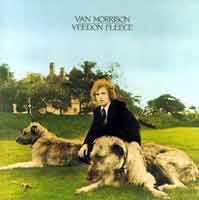 Nach einem kleinen "Durchhänger" (die beiden Vorgängeralben
"Saint Dominic's Preview" und "Hard
Nose The Highway" erreichten nicht ganz die Klasse von "Moondance"
oder "Tupelo Honey", sind
aber immer noch besser als das meiste andere aus dieser Zeit!) war Van
Morrison mit diesem Album wieder voll da. Erstmalig zeichnete sich hier
seine Vorliebe für keltische Themen ab ("Streets Of Arklow",
"County Fair").
Nach einem kleinen "Durchhänger" (die beiden Vorgängeralben
"Saint Dominic's Preview" und "Hard
Nose The Highway" erreichten nicht ganz die Klasse von "Moondance"
oder "Tupelo Honey", sind
aber immer noch besser als das meiste andere aus dieser Zeit!) war Van
Morrison mit diesem Album wieder voll da. Erstmalig zeichnete sich hier
seine Vorliebe für keltische Themen ab ("Streets Of Arklow",
"County Fair"). |
| Ougenweide: "All Die Weil Ich Mag" (Polydor, Okt. 1974) |
|
 An dieser Platte (Album Nr. 2 der Band) hängt mein Herz immer noch
ein wenig, denn es ist die erste, die ich mir damals von der Band gekauft
habe. Mitte der 70er habe ich die Minnerocker dann sehr intensiv gehört,
um sie danach aber wieder komplett aus meinen Hörgewohnheiten zu verdrängen.
Jetzt aus der Distanz kann ich es etwas gelassener betrachten: eigentlich
ist das eine ganz nette Platte!
An dieser Platte (Album Nr. 2 der Band) hängt mein Herz immer noch
ein wenig, denn es ist die erste, die ich mir damals von der Band gekauft
habe. Mitte der 70er habe ich die Minnerocker dann sehr intensiv gehört,
um sie danach aber wieder komplett aus meinen Hörgewohnheiten zu verdrängen.
Jetzt aus der Distanz kann ich es etwas gelassener betrachten: eigentlich
ist das eine ganz nette Platte!
PS: der restliche deutsche Folk(rock) aus dieser Zeit (Fiedel Michel,
Liederjan, Singspiel, Elster Silberflug,
Zupfgeigenzumsel und wie sie alle hiessen) kann mir nach wie vor
gestohlen bleiben!
(ca.2005)
Vor kurzem erschien tatsächlich mit "Herzsprung"
ein neues Ougenweide-Album -und sogar ein richtig gutes! Ich habe jetzt
sogar die alten Platten herausgekramt und muss mein obiges Urteil revidieren:
"All Die Weil Ich Mag" gefällt
mir mehr als nur "ein wenig":
Ich kann sogar alle anderen Alben aus der Frühzeit der Band (also
aus der Zeit von 1973 bis 1976)
wieder richtig geniessen! Es ist schon komisch: vor ca. 35 Jahren fand
ich dier Band einmal richtig klasse, vor 30 Jahren war die Liebe dann
deutlich abgekühlt (was nicht nur an mir, sondern an den gleichzeitig
modernen und trotzdem zu Zeiten der NDW anachronistischen Früh80er-Spätwerken
der Band liegt!). Vor 20 und auch noch vor 10 Jahren haben sie mich
überhaupt nicht interessiert, aber jetzt ist die Band zurück
und alles passt wieder gut zusammen. Ein wenid unheimlich ist dabei,
dass ich manche Lieder, obwohl teilweise 30 Jahre nicht mehr gehört,
noch so gut im Gedächtnis habe, dass ich auch mittelhochdeutsche
Texte noch mitsingen kann und mir ganze Instrumentalpassagen noch vollkommen
vertraut sind.
(17.07.2010)
|
| Randy Newman: "Good Old Boys" (Reprise, Okt. 1974) |
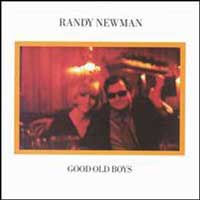 Nur eines von Newmans zahlreichen hochkarätigen Alben aus den 70ern ...
Nur eines von Newmans zahlreichen hochkarätigen Alben aus den 70ern ...

 Mehr ...
Mehr ...
| Randy Newman's songwriting often walks a narrow line between
intelligent satire and willful cruelty, and that line was never finer than
on the album Good Old Boys. Newman had long displayed a fascination with
the American South, and Good Old Boys was a song cycle where he gave free
reign to his most imaginative (and venomous) thoughts on the subject. The
album's scabrous opening cut, "Rednecks," is guaranteed to offend
practically anyone with its tale of a slow-witted, willfully (and proudly)
ignorant Southerner obsessed with "keeping the n——-s down."
"A Wedding in Cherokee County" is more polite but hardly less
mean-spirited, in which an impotent hick marries a circus freak; if the
song's melody and arrangement weren't so skillful, it would be hard to imagine
anyone bothering with this musical geek show. But elsewhere, Good Old Boys
displays a very real compassion for the blighted history of the South, leavened
with a knowing wit. "Birmingham" is a funny but humane tale of
working-class Alabamians, "Louisiana 1927" and "Kingfish"
are intelligent and powerfully evocative tales of the deep South in the
depths of the Great Depression, and "Rollin'" is cheerful on the
surface and troubling to anyone willing to look beneath it. Musically, Newman
dives deep into his influences in Southern soul and also adds potent country
accents (with the help of Al Perkins pedal-steel guitar) while dressing
up his songs in typically expert string and horn arrangements. And Newman
assumes each character, either brave or foolish, with the skill of a gifted
actor, giving even his most loathsome characters enough depth that they're
human beings, despite their flaws. Good Old Boys is one of Newman's finest
albums; it's also one of his most provocative and infuriating, and that's
probably just the way he wanted it. — (Mark Deming, All Music Guide)
|
|
| Newman draws on his roots in the blues and New Orleans boogie
to uncork this blistering portrait of the American South. He shows that
he was pop's most cutting satirist on "Rednecks" -- a song that
doesn't spare Northern or Southern racism; Newman said he still gets nervous
playing it in some U.S. cities. (Rolling Stone)
Total album sales: Under 500,000
Peak chart position: 36
|
|
| Ace: "Five-A-Side" (Anchor, Nov. 1974) |
 Ace wurden von Bam King, dem ehemaligen Gitarristen von The Action
und Mighty Baby gegründet
und waren wie Brinsley Schwarz ein Bestandteil
der englischen Pubrockszene, hatten aber mit "How Long", aus
der Feder ihres Sängers Paul Carrack, direkt einen Welthit.
Sie machten danach noch zwei Alben und versuchten, in den USA Fuß zu fassen.
Das gelang leider nicht und sie verloren zusätzlich ihr heimischen
"Kneipenpublikum". Paul Carrack hat später für
viele Bands gesungen und georgelt (Frankie Miller, Roxy Music,
The Smiths, Squeeze, Nick
Lowe, Mike & The Mechanics, etc.) und immer mal wieder
eine Solokarriere versucht (und dabei noch mehrmals "How Long"
aufgenommen).
Ace wurden von Bam King, dem ehemaligen Gitarristen von The Action
und Mighty Baby gegründet
und waren wie Brinsley Schwarz ein Bestandteil
der englischen Pubrockszene, hatten aber mit "How Long", aus
der Feder ihres Sängers Paul Carrack, direkt einen Welthit.
Sie machten danach noch zwei Alben und versuchten, in den USA Fuß zu fassen.
Das gelang leider nicht und sie verloren zusätzlich ihr heimischen
"Kneipenpublikum". Paul Carrack hat später für
viele Bands gesungen und georgelt (Frankie Miller, Roxy Music,
The Smiths, Squeeze, Nick
Lowe, Mike & The Mechanics, etc.) und immer mal wieder
eine Solokarriere versucht (und dabei noch mehrmals "How Long"
aufgenommen). |
| Can: "Soon Over Babaluma" (United Artists, Nov. 1974) |
 |
| Bonnie Raitt: "Streetlights" (Warner, Nov. 1974) |
 Eines meiner ersten Alben, das ich von Bonnie Raitt zeitgleich mit ihrem
"No Nukes"-Auftritt entdeckt habe. Enthält die definitive
Version von John Prines "Angel from Montgomery". Das
wird sicherlich auch Mr. Prine neidlos anerkennen. Außerdem "Rainy
Day Man" von James Taylor, "That Song About The Midway"
von Joni Mitchell und "Ain't Nobody Home" von Jerry
Ragovoy, der auch für die bluesig-soulige Produktion verantwortlich
zeichnet.
Eines meiner ersten Alben, das ich von Bonnie Raitt zeitgleich mit ihrem
"No Nukes"-Auftritt entdeckt habe. Enthält die definitive
Version von John Prines "Angel from Montgomery". Das
wird sicherlich auch Mr. Prine neidlos anerkennen. Außerdem "Rainy
Day Man" von James Taylor, "That Song About The Midway"
von Joni Mitchell und "Ain't Nobody Home" von Jerry
Ragovoy, der auch für die bluesig-soulige Produktion verantwortlich
zeichnet.

 Mehr ...
Mehr ...
|
"Bonnie Raitt had delivered three stellar albums,
but chart success wasn't forthcoming, even if good reviews and a cult
following were. So, she teamed with producer Jerry Ragovoy for Streetlights
and attempted to make the crossover record that Warner so desperately
wished she'd release. Over the years, the concessions that she made here
-- particularly the middle-of-the road arrangements (as opposed to the
appealingly laid-back sounds of her previous records), the occasional
use of strings, but also some of the song selections -- have consigned
Streetlights to noble failure status. There's no denying that's essentially
what Streetlights is, but that makes it out to seem worse than it really
is. It winds up paling to the wonderful ease and warm sensuality of her
first three albums -- she only occasionally hits that balance -- but it's
still undeniably pleasant, and there are moments here where she really
pulls off some terrific work, including the opening cover of Joni Mitchell's
"That Song About the Midway," a good version of John Prine's
"Angel From Montgomery," and the much-touted take on Allen Toussaint's
"What Is Success." It may be easy to lament the suppression
of the laid-back sexiness and organic feel of Raitt's earlier records,
but there's still enough here in that spirit to make this worthwhile."
(Stephen Thomas Erlewine, All Music Guide)
Mit ausschließlich fremdkomponierten Material nahm
Bonnie Raitt ihr 1974er Album "Streetlights" auf. Obwohl diese
Platte sehr kritisch beäugt wurde, kann man der Gitarristin und Sängerin
mit der rauchigen Altstimme auch hier ihr Talent nicht absprechen. Sanfte
jazzig angehauchte Balladentöne wie "Got You On My Mind"
kommen durch ihre Stimme herrlich erotisch gelöst rüber, wie
sie ebenso mit knackigen Funktönen bei "Got To Be Ready In Love"
zu überzeugen weiß, was von einer brillanten Backing- Band
ebenso sensibel umgesetzt wird. Auch Songs von Joni Mitchell und James
Taylor ("Rainy Day Man", ein Anspieltip) sind zu hören.
Frau Raitt beherrscht dabei ebenso die zärtlicheren wie die energischeren
Töne. So ist "Streetlights" in seiner Abwechslung ein gutes
Album, bei dem Bonnie Raitt einfach knapp vierzig Minuten lang gute Laune
macht. (Amazon)
|
|
| Linda Ronstadt: "Heart Like A Wheel" (Capitol, Nov. 1974) |
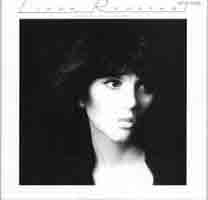 Linda
Ronstadt galt in den 70ern als die Rocksängerin schlechthin, wenn
ihre Musik auch weniger Rock und mehr Country bzw. Singer/Songwriter ist.
Zwar schreibt sie so gut wie keine eigenen Songs, hat aber wie Tom
Rush oder Judy Collins das Talent, gute Songs bisher unbekannter
Autoren zu entdecken und zu veredeln. Viele Künstler verdanken ihre
Karriere dem Sachverhalt, von Linda Ronstadt gecovert worden zu sein.
Auf dieser, ihrer meiner Meinung nach besten Platte, machte Linda uns
mit dem Titelsong zum ersten mal mit der Musik von Anna McGarrigle
vertraut, bevor Anna mit ihrer Schwester Kate im nächsten
Jahr selber eine Platte veröffentlichen konnte ("Kate
& Anna McGarrigle"). Weitere hochkarätige Songschreiber
auf dieser Platte: John David Souther ("Faithless Love"),
Paul Anka, Hank Williams, Dan Penn, Phil Everly,
James Taylor etc. Linda
Ronstadt galt in den 70ern als die Rocksängerin schlechthin, wenn
ihre Musik auch weniger Rock und mehr Country bzw. Singer/Songwriter ist.
Zwar schreibt sie so gut wie keine eigenen Songs, hat aber wie Tom
Rush oder Judy Collins das Talent, gute Songs bisher unbekannter
Autoren zu entdecken und zu veredeln. Viele Künstler verdanken ihre
Karriere dem Sachverhalt, von Linda Ronstadt gecovert worden zu sein.
Auf dieser, ihrer meiner Meinung nach besten Platte, machte Linda uns
mit dem Titelsong zum ersten mal mit der Musik von Anna McGarrigle
vertraut, bevor Anna mit ihrer Schwester Kate im nächsten
Jahr selber eine Platte veröffentlichen konnte ("Kate
& Anna McGarrigle"). Weitere hochkarätige Songschreiber
auf dieser Platte: John David Souther ("Faithless Love"),
Paul Anka, Hank Williams, Dan Penn, Phil Everly,
James Taylor etc. |
| Roxy Music: "Country Life" (Island/EG, Nov. 1974) |
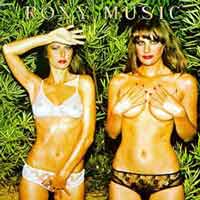 Grabbelkiste!!
Grabbelkiste!!
(19.07.2009)

 Mehr ...
Mehr ...
Continuing with the stylistic developments of Stranded, Country Life finds Roxy Music at the peak of their powers, alternating between majestic, unsettling art rock and glamorous, elegant pop/rock. At their best, Roxy combine these two extremes, like on the exhilarating opener "The Thrill of It All," but Country Life benefits considerably from the ebb and flow of the group's two extremes, since it showcases their deft instrumental execution and their textured, enthralling songwriting. And, in many ways, Country Life offers the greatest and most consistent set of Roxy Music songs, illustrating their startling depth. From the sleek rock of "All I Want Is You" and "Prairie Rose" to the elegant, string-laced pop of "A Really Good Time," Country Life is filled with thrilling songs, and Roxy Music rarely sounded as invigorating as they do here.
(by Stephen Thomas Erlewine, All Music Guide)
|
| Santana: "Borboletta" (Columbia, Nov. 1974) |
 Meiner
Meinung nach die letzte richtig gute Santanaplatte. Zwar nicht so stark
wie "Caravanserai"
und "Welcome" - aber immerhin
... Meiner
Meinung nach die letzte richtig gute Santanaplatte. Zwar nicht so stark
wie "Caravanserai"
und "Welcome" - aber immerhin
... |
| Dr. Feelgood: "Down By The Jetty" (United Artists, Dez. 1974) |
 Das Debüt
einer der besten britischen R&B-Bands mit dem Sänger Lee Brilleaux
und dem genialen Gitarristen Wilko
Johnson, von Vic Maile witzigerweise in Mono produziert. Bereits
mit einigen der späteren Konzertklassiker aus der Feder von Wilko
("Roxette", "20 Yards Behind" und "She Does It
Right"), sowie Coverversionen von John Lee Hooker und Mickey
Jupp. Besonders gut gefällt mir der live eingespielte Gassenhauer
"Tequila", bei dem sich Bob Andrews und Brinsley Schwarz
kurz nach dem Split ihrer Stammband Brinsley
Schwarz und noch vor der Gründung von Graham
Parker & The Rumour" als dilettantischer, aber hingebungsvoller
Bläsersatz präsentieren! Das Debüt
einer der besten britischen R&B-Bands mit dem Sänger Lee Brilleaux
und dem genialen Gitarristen Wilko
Johnson, von Vic Maile witzigerweise in Mono produziert. Bereits
mit einigen der späteren Konzertklassiker aus der Feder von Wilko
("Roxette", "20 Yards Behind" und "She Does It
Right"), sowie Coverversionen von John Lee Hooker und Mickey
Jupp. Besonders gut gefällt mir der live eingespielte Gassenhauer
"Tequila", bei dem sich Bob Andrews und Brinsley Schwarz
kurz nach dem Split ihrer Stammband Brinsley
Schwarz und noch vor der Gründung von Graham
Parker & The Rumour" als dilettantischer, aber hingebungsvoller
Bläsersatz präsentieren!

 Mehr ...
Mehr ...
|
The CD reissue of this album is a must-own release, even for those who
already have one of the Dr. Feelgood anthologies currently available,
neither of which has more than three of the 13 tracks here. The 1975 album,
a magnificent first album, recorded in pure mono, has been transferred
to CD in exemplary form, a clean, sharp, crunchy, close sound that recalls
the sonic textures of the Rolling Stones' first album, even as they cross
swords with the Stones' arch-rivals of the era, the Animals, with a superb
version of "Boom Boom." Released amid the burgeoning radio presence
of acts like Thin Lizzy, Blue Öyster Cult, and Kansas, and the growing
self-conscious profundity of Bruce Springsteen, Down by the Jetty was
as refreshingly lean as anything the headline-grabbing '70s punks would
later loose on the world, and as stripped down as the most basic roots
rock. Lee Brilleaux's singing could go up against Eric Burdon's or Cyril
Davies, and even take on elements of a thick rasp vaguely reminiscent
of Howlin' Wolf (listen closely to "Roxette"), certainly better
than Mick Jagger ever did; and guitarist Wilko Johnson could play Jimmy
Reed, Chuck Berry, or Bo Diddley licks with equally imposing (and seemingly
effortless) virtuosity. This record was one of the great '70s rock &
roll albums, right up there with the Groovies' Shake Some Action and anything
CCR left listeners, and ran circles around the Rolling Stones' post-Exile
on Main Street output. The final cut, a killer live medley of "Bonie
Maronie"/"Tequila" with guests Brinsley Schwarz and Bob
Andrews blowing saxes, was a taste of what they did on stage with astonishing
regularity, and could have sent the Ramones back to the drawing board
if the Queens-based quartet had heard it. (by Bruce Eder, AMG)
|
|
| Gryphon: "Red Queen To Gryphon Three" (Brain/Transatlantic, Dez. 1974) |
 Das dritte Album der englischen Band mit der ungewöhnlichen Frontline
bestehend aus Blockflöte und Fagott. Eine der wenigen Platten auf
dem kultigen Brainlabel, die definitiv kein DEUTSCH ROCK war. Eher so'was
wie Prog-Folk-Rock. Vier instrumentale Lieder (vielleicht
besser gesagt: Kompositionen) von jeweils 10 Minuten sind
zu hören. Virtuos, aber trotzdem schön.
Das dritte Album der englischen Band mit der ungewöhnlichen Frontline
bestehend aus Blockflöte und Fagott. Eine der wenigen Platten auf
dem kultigen Brainlabel, die definitiv kein DEUTSCH ROCK war. Eher so'was
wie Prog-Folk-Rock. Vier instrumentale Lieder (vielleicht
besser gesagt: Kompositionen) von jeweils 10 Minuten sind
zu hören. Virtuos, aber trotzdem schön.
(16.11.2011)

 Mehr ...
Mehr ...
|
Red Queen to Gryphon Three is only available coupled with the Raindance
album on the same disc, but it has stood the test of time as an excellent
progressive rock piece. The album centers around a game of chess, with
each track around ten minutes in length. The symphonic structure of the
movements intricately combine rich textured strings with medieval horns,
reminiscent of 16th century England. The keyboards bridge together certain
passages with just the right intensity so that they keep from modernizing
the album's feel. While some progressive rock can seem over the top or
contrived, Gryphon mixes subtlety with diversity to formulate beautiful
streamline music. The use of the bassoon and krumhorn gives this album
depth and a profound musical element not found in other bands of the same
nature. The tempos and accents express moods that are structured for each
piece precisely, such as the brainstorming arrangements in "Opening
Move" and the victorious finale heard throughout "Checkmate,"
the last song on the album. The absence of vocals lets the music carry
extra weight, enhancing the vision of the chessboard in the mind's eye.
(by Mike DeGagne, All
Music Guide)
|
|
| "Asleep At The Wheel" (Epic, 1974) |
|
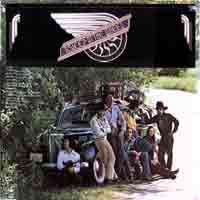 Neben
Commander Cody & The Lost Planet Airmen
war es Ende der 60er/Anfang der 70er vor allem diese Truppe, die es
schaffte, Hippies und Rednecks gemeinsam zum Tanzen zu kriegen! Asleep
At The Wheel gelten als die einzig wahren Erben von Bob Wills,
dem König des Texas-Swings! Auf diesem Album #2 gibt's solche Knaller
wie "Choo Choo Ch'Boogie" (Louie Jordan) und "Jumpin'
At The Woodside" (Count Basie). Neben
Commander Cody & The Lost Planet Airmen
war es Ende der 60er/Anfang der 70er vor allem diese Truppe, die es
schaffte, Hippies und Rednecks gemeinsam zum Tanzen zu kriegen! Asleep
At The Wheel gelten als die einzig wahren Erben von Bob Wills,
dem König des Texas-Swings! Auf diesem Album #2 gibt's solche Knaller
wie "Choo Choo Ch'Boogie" (Louie Jordan) und "Jumpin'
At The Woodside" (Count Basie).
"They really pick up the pace on this album, which
is a stone cold classic. Almost every song on here is first-rate...
maybe even better! Includes their fab version of Louis Jordan's "Choo-Choo
Ch'boogie," and another great R&B cover, the astonishingly
scathing "Bloodshot Eyes." The Wheel also get in their country
licks, although most of the hick tunes are originals, rather than cover
tunes. Chris O'Connell's somewhat shaky vocals grace several songs,
but they match the material perfectly, and this is one of her best efforts.
In fact, this is probably Asleep At The Wheel's best album... Highly
recommended!"
|
| Chilli Willi & Red Hot Peppers: "Bongos Over Balham" (Mooncrest, 1974) |
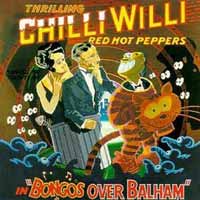 Obskure
Pubrockband um Phil Lithman (später als Snakefinger
bekannt durch seine Zusammenarbeit u. a. mit den Residents) und
dem Ex-Mighty Baby Gitarristen
Martin Stone. Obskure
Pubrockband um Phil Lithman (später als Snakefinger
bekannt durch seine Zusammenarbeit u. a. mit den Residents) und
dem Ex-Mighty Baby Gitarristen
Martin Stone. |
| Billy Cobham: "Crosswinds" (Atlantic, 1974) |
 Gefunden in der Grabbelkiste!
Gefunden in der Grabbelkiste!
(16.11.2012)

 Mehr ...
Mehr ...
Billy Cobham's second date as a leader was one of his better sessions. Four songs (all originals by the leader/drummer) comprise "Spanish Moss -- A Sound Portrait," and, in addition, Cobham contributed three other pieces. The selections team him with guitarist John Abercrombie, both of the Brecker Brothers, trombonist Garnett Brown, keyboardist George Duke, bassist John Williams, and Latin percussionist Lee Pastora. In general, the melodies and the vamps are reasonably memorable. Cobham also takes an unaccompanied drum solo on "Storm." Worth searching for by fusion collectors.
(by Scott Yanow, All Music Guide)
|
| Commander Cody & His Lost Planet Airmen: "Live From Deep In The Heart Of Texas" (MCA/Paramount, 1974) |
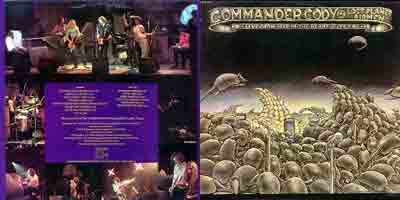 Mit
diesem Livealbum haben es die Jungs um den guten alten Commander geschafft,
Country und Western Swing in die Herzen von Hippies zu bringen. Andererseits
wurden sie in Nashville dafür gehasst: Hippies klauen uns unsere
Musik! Mit
diesem Livealbum haben es die Jungs um den guten alten Commander geschafft,
Country und Western Swing in die Herzen von Hippies zu bringen. Andererseits
wurden sie in Nashville dafür gehasst: Hippies klauen uns unsere
Musik! |
| Ry Cooder: "Paradise And
Lunch" (Reprise, 1974) |


 Mehr ...
Mehr ...
|
Ry Cooder understands that a great song is a great song, whether it was
written before the Depression or last week. Still, at the same time he
isn't afraid to explore new avenues and possibilities for the material.
Like his three previous records, Paradise and Lunch is filled with treasures
which become part of a world where eras and styles converge without ever
sounding forced or contrived. One may think that an album that contains
a traditional railroad song, tunes by assorted blues greats, and a Negro
spiritual alongside selections by the likes of Bobby Womack, Burt Bacharach,
and Little Milton may lack cohesiveness or merely come across as a history
lesson, but to Cooder this music is all part of the same fabric and is
as relevant and accessible as anything else that may be happening at the
time. No matter when it was written or how it may have been done in the
past, the tracks, led by Cooder's brilliant guitar, are taken to new territory
where they can coexist. It's as if Washington Phillips' "Tattler"
could have shared a place on the charts with Womack's "It's All Over
Now" or Little Milton's "If Walls Could Talk." That he's
successful on these, as well as the Salvation Army march of "Jesus
on the Mainline" or the funky, gospel feel of Blind Willie McTell's
"Married Man's a Fool," is not only a credit to Cooder's talent
and ingenuity as an arranger and bandleader, but also to the songs themselves.
The album closes with its most stripped-down track, an acoustic guitar
and piano duet with jazz legend Earl "Fatha" Hines on the Blind
Blake classic "Ditty Wah Ditty." Here both musicians are given
plenty of room to showcase their instrumental prowess, and the results
are nothing short of stunning. Eclectic, intelligent, and thoroughly entertaining,
Paradise and Lunch remains Ry Cooder's masterpiece.
(by Brett Hartenbach, All
Music Guide)
|
|
| Elster Silberflug: "Ich Fahr Dahin" (Hansa, 1974) |
 Mitte
der 70er, also noch in jungen Jahren, hatte ich einen kurzen, aber heftigen
Flirt mit deutschsprachiger Folklore. Ougenweide,
Liederjan, Singspiel, Scheytholz und eben auch
Elster Silberflug hiessen diese Bands, die dann gerne auch mit dem
furchtbaren Etikett Deutsch Folk (so steht's sogar auf der
Coverrückseite von "Ich Fahr Dahin") versehen wurden. Mitte
der 70er, also noch in jungen Jahren, hatte ich einen kurzen, aber heftigen
Flirt mit deutschsprachiger Folklore. Ougenweide,
Liederjan, Singspiel, Scheytholz und eben auch
Elster Silberflug hiessen diese Bands, die dann gerne auch mit dem
furchtbaren Etikett Deutsch Folk (so steht's sogar auf der
Coverrückseite von "Ich Fahr Dahin") versehen wurden.
Lange hielt meine erste "Folkphase" nicht an. Ebenfalls sehr
lange habe ich diese Platten schon nicht mehr herausgekramt, aber vor
kurzem stiess ich im Internet auf ein paar englischsprachigen Blogs, die
u.a. "Female
Vocals" oder "Old
Rock" zum Thema haben. Dort konnte ich obskure Schäze der
70er entdecken, wie zum Bleistift Comus,
Dando Shaft, Kathy
McCord, Pamela Polland und
Fuchsia, die ich bisher überhaupt
nicht kannte. Zu bewundern gab es dort überraschenderweise auch das
Debütalbum der Heidelberger Hippiefolker von Elster Silberflug,
über die ich in meinen Anmerkungen zu Ougenweide
vor einiger Zeit noch pauschal abgelästert hatte. Ich habe mir das
Album trotzdem heruntergeladen, ganz ohne sclechtes Gewissen, denn ich
besitze es ja bereits auf Vinyl seit über 30 Jahren, und merke beim
Hören, dass das eigentlich ein sehr schönes Album ist und sich
hinter englischen Folkbands der damaligen Zeit nicht zu verstecken braucht.
Dem Berliner Plattenlabel Hansa haben wir neben unfassbar viel
schrecklicher Schlagermusik auch ein paar musikalische Schätze zu
verdanken. Neben Elster Silberflug fallen mir da noch die Ur-Krautrocker
von Xhol Caravan oder das Frühwerk
der britischen Waverrocker von Japan ein.
(03.05.2010) |
| Art Farmer: "A Sleeping Bee" (Sonet, 1974) |
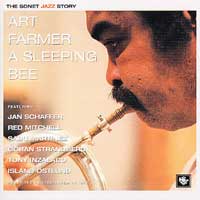 Ein eher unbekanntes, unspektakuläres Jazzalbum, das der damals in
österreich lebende amerikanische Flügelhornspieler (das ist
so was wie eine Trompete, aber kein Kornett!) in Schweden (!) aufgenommen
hatte, an das ich aber gute Erinnerungen habe: ein Freund hatte damals
(also Ende der 70er) die Platte und spielte sie auch öfter. Letztes
Jahr stand die CD für kleines Geld in der Grabbelkiste bei 2001 in
Essen - da habe ich voll nostalgischer Gefühle sofort zugeschlagen.
Beim erstmaligen Hören nach ungefähr 25 Jahren kann ich mich
sogar an manche der Lieder noch gut erinnern! Eine wirklich schöne
Platte ist das! Art Farmer hat mithin den schönsten Sound auf dem
Flügelhorn, den ich kenne. OK - so viele Flügelhornspieler kenne
ich nun auch wieder nicht. Im Moment fällt mir gar keiner ein. Wo
war ich gerade stehen geblieben???
Ein eher unbekanntes, unspektakuläres Jazzalbum, das der damals in
österreich lebende amerikanische Flügelhornspieler (das ist
so was wie eine Trompete, aber kein Kornett!) in Schweden (!) aufgenommen
hatte, an das ich aber gute Erinnerungen habe: ein Freund hatte damals
(also Ende der 70er) die Platte und spielte sie auch öfter. Letztes
Jahr stand die CD für kleines Geld in der Grabbelkiste bei 2001 in
Essen - da habe ich voll nostalgischer Gefühle sofort zugeschlagen.
Beim erstmaligen Hören nach ungefähr 25 Jahren kann ich mich
sogar an manche der Lieder noch gut erinnern! Eine wirklich schöne
Platte ist das! Art Farmer hat mithin den schönsten Sound auf dem
Flügelhorn, den ich kenne. OK - so viele Flügelhornspieler kenne
ich nun auch wieder nicht. Im Moment fällt mir gar keiner ein. Wo
war ich gerade stehen geblieben???

 Mehr ...
Mehr ...
This Sonet LP finds Art Farmer with an atypical supporting group that includes fellow veteran Red Mitchell on bass, Latin percussionist Sabú Martínez, and several Europeans, among them guitarist Jan Schaffer and pianist Goran Strandberg. The opener, an easygoing take of "It Might As Well Be Spring," finds Farmer finally opening up in the closing chorus. Farmer's rich-toned flugelhorn interacts beautifully with Mitchell's imaginative bassline in the swinging take of "Come Rain or Come Shine," while the brisk bossa nova "Green Witch" is one of the more challenging charts on the date, with Farmer switching to trumpet. "A Sleeping Bee" is often played at fast tempos, but the hip-swaying, relaxed arrangement better showcases lyrical solos by the leader and Mitchell. This excellent record is long overdue to be reissued on CD.
(by Ken Dryden, All Music Guide)
|
| Donnie Fritts: "Prone To Lean" (Atlantic, 1974) |
 Solodebüt
des Songschreibers und Gelegenheitskeyboarders (u. a. für Kris
Kristofferson, der hier auch mit Jerry Wexler produziert hat).
Wenn jemand den Namen überhaupt kennt, dann aus den Songschreibercredits
von Country- und Soulplatten. Eines seiner bekanntesten Lieder ist neben
"Breakfast In Bed", das er für Dusty
Springfield schrieb, "We Had It All", das bereits 1973 von
Dobie Gray aufgenommen wurde und
danach noch vielen anderen Künstlern gecovert wurde (u. a. Bob
Neuwirth, Scott Walker, Waylon Jennings, Rita Coolidge
und Green On Red - es soll sogar
Versionen von Bob Dylan und den Rolling Stones geben!).
Vom Publikum scheinbar ignoriert hatte er aber doch scheinbar viele Freunde
in Kollegenkreisen, die alle gerne im Studio ausgeholfen haben: neben
den bereits erwähnten Kris Kristofferson samt Ehefrau Rita
Coolidge wären da z.B. noch Tony
Joe White, John Prine, Dan Penn
(auch so eine Südstaaten-Songschreiber-Legende!) und Billy Swan
erwähnenswert. Für Musik und Songs gebe ich die volle Punktzahl,
Mr. Fritts hat nur ein kleines Problem, das ich mal "diplomatisch"
formulieren möchte: selbst sein Kollege Kris Kristofferson ist im
Verhältnis zu ihm ein begnadeter Sänger! Aber eigentlich stört
dieses Manko kaum: es macht eben nur verständlich, warum man seine
Lieder meist nur in der Interpretation von anderen kennt Solodebüt
des Songschreibers und Gelegenheitskeyboarders (u. a. für Kris
Kristofferson, der hier auch mit Jerry Wexler produziert hat).
Wenn jemand den Namen überhaupt kennt, dann aus den Songschreibercredits
von Country- und Soulplatten. Eines seiner bekanntesten Lieder ist neben
"Breakfast In Bed", das er für Dusty
Springfield schrieb, "We Had It All", das bereits 1973 von
Dobie Gray aufgenommen wurde und
danach noch vielen anderen Künstlern gecovert wurde (u. a. Bob
Neuwirth, Scott Walker, Waylon Jennings, Rita Coolidge
und Green On Red - es soll sogar
Versionen von Bob Dylan und den Rolling Stones geben!).
Vom Publikum scheinbar ignoriert hatte er aber doch scheinbar viele Freunde
in Kollegenkreisen, die alle gerne im Studio ausgeholfen haben: neben
den bereits erwähnten Kris Kristofferson samt Ehefrau Rita
Coolidge wären da z.B. noch Tony
Joe White, John Prine, Dan Penn
(auch so eine Südstaaten-Songschreiber-Legende!) und Billy Swan
erwähnenswert. Für Musik und Songs gebe ich die volle Punktzahl,
Mr. Fritts hat nur ein kleines Problem, das ich mal "diplomatisch"
formulieren möchte: selbst sein Kollege Kris Kristofferson ist im
Verhältnis zu ihm ein begnadeter Sänger! Aber eigentlich stört
dieses Manko kaum: es macht eben nur verständlich, warum man seine
Lieder meist nur in der Interpretation von anderen kennt
(13.04.2006) |
| Bryn Haworth: "Let The Days Go By" (Island, 1974) |
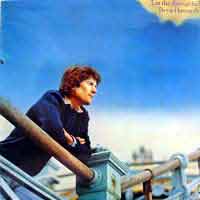 Der
Engländer Bryn Haworth gilt als ein Meister der Slidegitarre. Leider
blieb er mit seinen eigenen Platten, von denen mir dieses Debüt am
besten gefällt, ohne großen Publikumserfolg. Dagegen wussten seine
Kollegen diese Künste zu schätzen und luden ihn immer wieder
gern zu ihren Plattenaufnahmen ein (Bryn ist z. B. auf John Cales
"Fear" und Ian Matthews' "Stealin'
Home" zu hören) Der
Engländer Bryn Haworth gilt als ein Meister der Slidegitarre. Leider
blieb er mit seinen eigenen Platten, von denen mir dieses Debüt am
besten gefällt, ohne großen Publikumserfolg. Dagegen wussten seine
Kollegen diese Künste zu schätzen und luden ihn immer wieder
gern zu ihren Plattenaufnahmen ein (Bryn ist z. B. auf John Cales
"Fear" und Ian Matthews' "Stealin'
Home" zu hören) |
| "Bob Neuwirth" (Elektra/Asylum, 1974) |
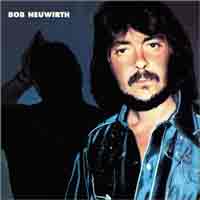 Das ist natürlich NICHT CHRIS REA, sondern einer von Bob Dylans
alten Kumpels. Ich hab ihn mal vor einigen Jahren als Package mit Howe
Gelb im kleinen Studio der Bochumer Zeche (die Halle kriegen beide
leider nicht voll!) gesehen, was ganz witzig war, denn Howe hatte mal
wieder eine seiner extremen "mein Lied darf sich auf keinen Fall
schön anhören oder aus einem Guss sein"-Phasen. Mr. Neuwirth
lauschte immer ganz andächtig und etwas amüsiert Howes schrägem
Vortrag, grinste sich einen und konterte mit einem klasse Folk- oder Countrysong.
Das ist natürlich NICHT CHRIS REA, sondern einer von Bob Dylans
alten Kumpels. Ich hab ihn mal vor einigen Jahren als Package mit Howe
Gelb im kleinen Studio der Bochumer Zeche (die Halle kriegen beide
leider nicht voll!) gesehen, was ganz witzig war, denn Howe hatte mal
wieder eine seiner extremen "mein Lied darf sich auf keinen Fall
schön anhören oder aus einem Guss sein"-Phasen. Mr. Neuwirth
lauschte immer ganz andächtig und etwas amüsiert Howes schrägem
Vortrag, grinste sich einen und konterte mit einem klasse Folk- oder Countrysong.

 Mehr ...
Mehr ...
|
"...bereits in den späten 60ern gehörte der Bohemian Poet
Bob Neuwirth zu den wichtigen Szene/In-Typen zwischen New York und Los
Angeles mit guten Kontakten zu Bob Dylan, Kris Kristofferson, Janis Joplin,
David Blue, Eric Andersen, Roger McGuinn, Patti Smith... Trotzdem dauerte
es mit seiner ersten LP bis 1974, also ein Jahr vor seiner Teilnahme an
der legendären Rolling Thunder Revue mit Dylan & Co. Dieses Album,
das für die folgenden 14 Jahre sein einziges bleiben sollte, gibt's
nun endlich als angemessene CD-Version in gutem Sound und Originalartwork
mit aktuellen Liner Notes. Auch wenn die meisten Arrangements fest in
die damalige Zeit gehören (allzu üppige Thomas Jefferson Kaye-Produktion
mit teilweise Streichern, Bläsern, Backing Chor etc.), so ist 'Bob
Neuwirth' (Asylum 1008) ein Ereignis für sich, beinhaltet wichtige
Songs wie u.a. die eigenen 'Rock & Roll Time', 'Hero', 'Rock &
Roll Rider', 'Country Livin' sowie 'Cowboys & Indians' (Bobby Charles),
'We Had It All' (Donnie Fritts/Troy Seals), 'Legend In My Time' (Don Gibson).
Die Guest List ist kaum zu überbieten: Jeff Baxter, Cass Elliott,
Don Everly, Rita Coolidge, Stephen Bruton, Dusty Springfield, Timothy
B.Schmit, Chris Hillman, Booker T., Ben Keith, Ian Matthews, Richie Furay,
Richard Greene, Kris Kristofferson, Jerry McGee, Donnie Fritts, Geoff
Muldaur u.v.a" (Glitterhouse)
|
|
| Oregon: "Winter Light" (Vanguard, 1974) |


 Mehr ...
Mehr ...
If there was a "second best" recording from Oregon in their early years, this would be it. The concept of "Winter Light" certainly reflects the visage of the Pacific Northwest in the fourth season, yet it is a music, and time of year, filled with hope for the future while pondering a somewhat bleak present. Winter can be pleasant, bearable and filled with its own snowy delights. The first three pieces on their own are worth the price of this entire project, and are definitive works from the quartet. "Tide Pool" while accented with bizarre twists, is anchored by Walcott's energetic tabla and Towner's pure bred energy on acoustic guitar. Of course Jim Pepper's "Witchi-Tai-To" is classic, made moreso by the group's personal collective serenity and peace injected into the flavor of the composition. "Ghost Beads" is really the one for Towner and oboist Paul McCandless to dig in and fully express their vitruosity. These are three great examples of early world music. While the rest of the recording is not as provocative, it is still well played and conceived. "Winter Light" is heartily recommended as your follow-up Oregon purchase after "Music Of Another Present Era," with "Distant Hills" a close third.
(by Ron Wynn, All Music Guide)
|
| Dolly Parton: "Jolene" (RCA, 1974) |
 Von
Dolly gibt es viele gute Platten. Mit "Jolene" schaffte sie
damals den Durchbruch als Solistin und Songschreiberin, denn das Album
enthält zwei gigantische Songs: Natürlich "Jolene"
selber, aber eben auch "I Will Always Love You" (#1 in den Country
Charts 1974). Von
Dolly gibt es viele gute Platten. Mit "Jolene" schaffte sie
damals den Durchbruch als Solistin und Songschreiberin, denn das Album
enthält zwei gigantische Songs: Natürlich "Jolene"
selber, aber eben auch "I Will Always Love You" (#1 in den Country
Charts 1974). |
| "Taggett" (United Artists, 1974) |
 über dieses total obskure Album bin ich vor einigen Monaten im WWW
gestolpert. Da es keine Wiederveröffentlichung gibt habe ich mir
jetzt eine CDR-Kopie der alten Vinylausgabe besorgt. Sänger Colin
Horton-Jennings war zuvor bei der Band The
Greatest Show On Earth und auch als Songschreiber tätig. Sein
offensichtlich den Bandnamen inspirierendes Eröffnungslied "Delaware
Taggett And The Outlaw Boys" fand sich bereits vor zwei Jahren auf
dem Album "Romany" der
Hollies und wird hier erstmals vom Autor selbst gesungen. Tony
Hicks, der Leadgitarrist der Hollies hat produziert und ein gewisser
Alan Parsons saß hinter'm Mischpult. Ach ja - die Musik ...
Folkrock, Pubrock, Westcoast, so was in dieser Richtung. Paßte ganz
gut zu den anderen damaligen Bands auf United Artists (Man,
Brinsley Schwarz, Help
Yourself, etc.), war aber wohl kommerziell ein totaler Flopp. Trotzdem
gute Mucke!!!
über dieses total obskure Album bin ich vor einigen Monaten im WWW
gestolpert. Da es keine Wiederveröffentlichung gibt habe ich mir
jetzt eine CDR-Kopie der alten Vinylausgabe besorgt. Sänger Colin
Horton-Jennings war zuvor bei der Band The
Greatest Show On Earth und auch als Songschreiber tätig. Sein
offensichtlich den Bandnamen inspirierendes Eröffnungslied "Delaware
Taggett And The Outlaw Boys" fand sich bereits vor zwei Jahren auf
dem Album "Romany" der
Hollies und wird hier erstmals vom Autor selbst gesungen. Tony
Hicks, der Leadgitarrist der Hollies hat produziert und ein gewisser
Alan Parsons saß hinter'm Mischpult. Ach ja - die Musik ...
Folkrock, Pubrock, Westcoast, so was in dieser Richtung. Paßte ganz
gut zu den anderen damaligen Bands auf United Artists (Man,
Brinsley Schwarz, Help
Yourself, etc.), war aber wohl kommerziell ein totaler Flopp. Trotzdem
gute Mucke!!!
(12.10.2009)

 Mehr ...
Mehr ...
This little-known Hollies spinoff project only lasted for one year and produced just one album, produced by Tony Hicks and featuring a cover of "Delaware Taggett and The Outlaw Boys", but it is an item of interest to anoraks and collectors of British rock of the 1970s, as it boasts a whole host of names recognisable to those familiar with the session scene of that time period. For starters, keyboardist/vocalist Peter Arnesen (If, Ian Hunter, Rubettes, Daddy Longlegs, Hollies) and Colin Horton-Jennings (Greatest Show On Earth) were members of this band, Peter Wingfield (Olympic Runners, Hollies, Elton John, Chris Farlowe, Colin Blunstone, Elkie Brooks, Maggie Bell, Buddy Guy, Roger Chapman, Lonnie Donegan, Keef Hartley Band, BB King, Freddie King, Level 42, Nazareth, Gerry Rafferty, Al Stewart, Streetwalkers, Chris Youlden, Richard Thompson, etc.) also contributed keyboards to the project, and Alan Parsons is listed on the album's back cover amongst the engineers involved with it./p>
Musically, it's an amalgamation of mid-70s post-glam British pop and sophisticated pre-punk era rock, which sounds as fresh and effervescent today as it did 25 years ago: maybe Heavy Metal Kids meets Roxy Music meets Hello...
(Alex Gitlin, January 2000)
|
| The Velvet Undeground: "1969 - Velvet Underground Live With Lou Reed" (PolyGram/Mercury, 1974)
|
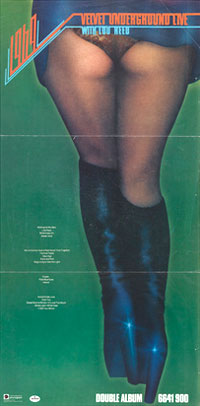 Nachträglich
veröffentliche Livealben sind oft extrem uninteressant. Auf dieses
trifft das aus mehreren Gründen aber nicht zu: es klingt relativ
gut (anders als das bekanntere Livealbum "At Max's Kansas City")
und es gibt sogar ein paar Lieder, die nur hier oder auf späteren
Sokoalben von Lou Reed zu finden sind, die alleine schon die Anschaffung
lohnen. Ach ja - live 1969 bedeutet natürlich mit Doug
Yule am Bass und ohne John Cale. Trotzdem (?) gut. Nachträglich
veröffentliche Livealben sind oft extrem uninteressant. Auf dieses
trifft das aus mehreren Gründen aber nicht zu: es klingt relativ
gut (anders als das bekanntere Livealbum "At Max's Kansas City")
und es gibt sogar ein paar Lieder, die nur hier oder auf späteren
Sokoalben von Lou Reed zu finden sind, die alleine schon die Anschaffung
lohnen. Ach ja - live 1969 bedeutet natürlich mit Doug
Yule am Bass und ohne John Cale. Trotzdem (?) gut.
(11.03.2014)

 Mehr ...
Mehr ...
|
by Mark Deming
The Velvet Underground were little more than a rumor when Lou Reed left
the band in 1970, but by 1974, thanks to Reed's success as a solo artist,
the Velvets had become a bona fide cult item, and that year Mercury Records
released a two-record set compiled from tapes from shows in Dallas and
San Francisco entitled 1969: Velvet Underground Live. The album featured
a generous 104 minutes of music, and when Mercury reissued it on CD in
1988, rather than edit the material or release a two-CD set, they put
out the album as two separate discs. While this seemed like a rather curious
move, the album's sequence was such that it divided in half quite cleanly,
and while any VU fan will want both volumes, they don't work half bad
as individual albums. 1969: Velvet Underground Live, Vol. 1 rocks a bit
harder than its counterpart; it opens with a grooving version of "Waiting
for My Man," moves on to a rave-up take of "What Goes On"
that features some of Lou Reed's finest rhythm guitar work, and closes
out with passionate renditions of "Rock and Roll" and "Beginning
to See the Light." And where there are a number of ballads on hand
(most notably a lovely take of "Lisa Says" and versions of "Sweet
Jane" and "New Age" considerably different from those on
Loaded), they sound just as committed and compelling as the rockers. While
the Doug Yule-era edition of the Velvet Underground often gets short shrift
from aficionados, the performances on 1969: Velvet Underground Live, Vol.
1 prove this band still had plenty of fire, and was playing at the top
of their game. The CD also adds a final bonus track, an unreleased version
of "Heroin"; while the same song appears on Vol. 2, this recording
is a different (and considerably more aggressive) performance.
|
|
| Wendy Waldman: "Gypsy Symphony" (Warner, 1974) |
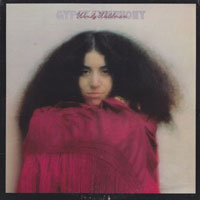 Gefunden in der Grabbelkiste!
Gefunden in der Grabbelkiste!
(01.11.2015)

 Mehr ...
Mehr ...
Marrying Waldman's sound with the inestimable Muscle Shoals musicians, Gypsy Symphony is a funky, shimmering delight, and other artists weren't slow to notice. "My Love Is All I Know," "The Good Love" and "Mad Mad Me" were recorded by Melissa Manchester, Percy Sledge and Maria Muldaur, respectively. The latter, in particular, showcases Waldman as a more accessible, more accommodating Laura Nyro, and possibly a more deft pianist, too. Most compositions on the record flaunts unexpected chord progressions, adventurous time signatures, snappy horn charts and a maverick spirit that should have shone brightly among some of the bland embarrassments emerging from the West Coast scene at the time; a shame, then, that not many people noticed.
(by Charles Donovan, All Music Guide)
|
| Jimmy Webb: "Land's End" (Elektra/Asylum, 1974) |
 Jimmy
Webb kennt man - wenn überhaupt - eher als Songschreiber denn als
Sänger. Auf sein Konto gehen unter anderem solch hochkarätige
Lieder wie "Wichita Lineman" und "By The Time I Get To
Phoenix", die Glen Campbell in den 60ern zu Welthits machte,
oder "MacArthur Park", das der irische Schauspieler Richard
Harris in die Spät60er-Charts brachte. Seine eigenen Alben haben
leider nie eine ähnliche Aufmerksamkeit erreicht, so auch das Mitt70er-Werk
"Land's End". Webb, begeisterter Segelflieger, war für
das Coverfoto mit Fotograf Henry Diltz in die Lüfte gegangen.
Details dazu in dem informativen Film "Under
The Covers" von Henry Diltz und Coverdesigner Gary Burden. Jimmy
Webb kennt man - wenn überhaupt - eher als Songschreiber denn als
Sänger. Auf sein Konto gehen unter anderem solch hochkarätige
Lieder wie "Wichita Lineman" und "By The Time I Get To
Phoenix", die Glen Campbell in den 60ern zu Welthits machte,
oder "MacArthur Park", das der irische Schauspieler Richard
Harris in die Spät60er-Charts brachte. Seine eigenen Alben haben
leider nie eine ähnliche Aufmerksamkeit erreicht, so auch das Mitt70er-Werk
"Land's End". Webb, begeisterter Segelflieger, war für
das Coverfoto mit Fotograf Henry Diltz in die Lüfte gegangen.
Details dazu in dem informativen Film "Under
The Covers" von Henry Diltz und Coverdesigner Gary Burden. |
 Das Album des Jahres
Das Album des Jahres weitere Highlights ...
weitere Highlights ...  Lost & Found!
Lost & Found! Eigentlich sind Funk- und Jazzrock nicht meine Baustellen, aber an diesem
Album von Ex-Miles-Davis-Keyboarder Herbie Hancock kommt man kaum
vorbei, denn ES ROCKT! Und das ganz ohne E-Gitarren! Stark ist auch die
Intro zur Neuauflage seines Klassikers "Watermelon Man" aus
den 60ern, gespielt auf einer Okarina. Oder ist das doch ein Synthie?
Egal!
Eigentlich sind Funk- und Jazzrock nicht meine Baustellen, aber an diesem
Album von Ex-Miles-Davis-Keyboarder Herbie Hancock kommt man kaum
vorbei, denn ES ROCKT! Und das ganz ohne E-Gitarren! Stark ist auch die
Intro zur Neuauflage seines Klassikers "Watermelon Man" aus
den 60ern, gespielt auf einer Okarina. Oder ist das doch ein Synthie?
Egal!
 Mehr ...
Mehr ...
 Die Veröffentlichung seines zweiten Soloalbums hatte er nicht mehr
erlebt. Kurz nach den Aufnahmen September 1973 starb Parsons den typischen
Rock'n'Roll-Tod (Drogen...) und hinterließ eine wunderbare Platte mit
wunderbaren Liedern: "Brass
Buttons", "$1000 Wedding" und das Duett mit Emmylou
Harris: "Love Hurts".
Die Veröffentlichung seines zweiten Soloalbums hatte er nicht mehr
erlebt. Kurz nach den Aufnahmen September 1973 starb Parsons den typischen
Rock'n'Roll-Tod (Drogen...) und hinterließ eine wunderbare Platte mit
wunderbaren Liedern: "Brass
Buttons", "$1000 Wedding" und das Duett mit Emmylou
Harris: "Love Hurts".
 Mehr ...
Mehr ...
 Die Reunion von Dylan und seiner besten Begleitband nach einer mehrjährigen
Unterbrechung führte zu diesem Studioalbum und einer sehr erfolgreichen
Tournee mit anschließendem Livealbum. Für mich ist bis heute unerklärlich,
warum diese Platte als eine der schwächeren Dylan-Platten eingeschätzt
wird: "Going, Going, Gone" und "Forever Young" gehören
zu den besten Songs von Dylan. Außerdem spielen Levon Helm, Rick
Danko, Garth Hudson, Robbie Robertson und Richard
Manual wie immer traumwandlerisch zusammen.
Die Reunion von Dylan und seiner besten Begleitband nach einer mehrjährigen
Unterbrechung führte zu diesem Studioalbum und einer sehr erfolgreichen
Tournee mit anschließendem Livealbum. Für mich ist bis heute unerklärlich,
warum diese Platte als eine der schwächeren Dylan-Platten eingeschätzt
wird: "Going, Going, Gone" und "Forever Young" gehören
zu den besten Songs von Dylan. Außerdem spielen Levon Helm, Rick
Danko, Garth Hudson, Robbie Robertson und Richard
Manual wie immer traumwandlerisch zusammen. Dieses Pie-Album habe ich damals im Weseler Kaufhof für einen 5er
vom Wühltisch ergattert - ich muss zugeben, hauptsächlich wegen
des Innencovers (benutzt eure Maus!), denn Steve Marriott, Clem
Clempson & Co. waren mir damals kaum ein Begriff. Die Musik auf
der Platte ist schwärzester Soulrock von einer weißen Band und war
damals eigentlich überhaupt nicht nach meinem Geschmack. Erst viel
später habe ich die tollen Soulsongs zu schätzen gelernt: "Groovin'
With Jesus" (Gene Barge), "Anna" (Arthur Alexander), "I
Can't Stand The Rain" und "99 Pounds" (Ann
Peebles), "Drift Away" (Dobie
Gray) etc.
Dieses Pie-Album habe ich damals im Weseler Kaufhof für einen 5er
vom Wühltisch ergattert - ich muss zugeben, hauptsächlich wegen
des Innencovers (benutzt eure Maus!), denn Steve Marriott, Clem
Clempson & Co. waren mir damals kaum ein Begriff. Die Musik auf
der Platte ist schwärzester Soulrock von einer weißen Band und war
damals eigentlich überhaupt nicht nach meinem Geschmack. Erst viel
später habe ich die tollen Soulsongs zu schätzen gelernt: "Groovin'
With Jesus" (Gene Barge), "Anna" (Arthur Alexander), "I
Can't Stand The Rain" und "99 Pounds" (Ann
Peebles), "Drift Away" (Dobie
Gray) etc.
 Mehr ...
Mehr ...
 Loudon
wurde in den 70ern als einer der vielen neuen "Dylans" gehandelt,
war aber eigentlich immer nur "Loudon". Dies ist sein 4. Album
und enthält einige seiner bekanntesten Songs: "Swimming Song"
(gab's mal in deutsch von Cochise: wer kennt die noch?), "Down
Drinking At The Bar", "The Man Who Couldn't Cry" (gibt's
'ne tolle Version von Johnny Cash!). Außerdem covert er selber
"Come A Long Way" von seiner damaligen Frau Kate
McGarrigle. In der Begleitung die damalige Nashville-Mafia (Mack
Gayden, Reggie Young, Pig Robbins, Johnny Christopher,
Tommy Cogbill, Kenny Buttrey u.a.), produziert hat der Dylan-Spezi
Bob Johnston.
Loudon
wurde in den 70ern als einer der vielen neuen "Dylans" gehandelt,
war aber eigentlich immer nur "Loudon". Dies ist sein 4. Album
und enthält einige seiner bekanntesten Songs: "Swimming Song"
(gab's mal in deutsch von Cochise: wer kennt die noch?), "Down
Drinking At The Bar", "The Man Who Couldn't Cry" (gibt's
'ne tolle Version von Johnny Cash!). Außerdem covert er selber
"Come A Long Way" von seiner damaligen Frau Kate
McGarrigle. In der Begleitung die damalige Nashville-Mafia (Mack
Gayden, Reggie Young, Pig Robbins, Johnny Christopher,
Tommy Cogbill, Kenny Buttrey u.a.), produziert hat der Dylan-Spezi
Bob Johnston.  Drittes Album einer der wichtigsten Bands der 70er und auch einer meiner
Lieblingsbands! Gleichzeitig ist es auch das letzte Album als "Band
im herkömmlichen Sinne": Nach einer langen, anstrengenden und
frustrierenden Tournee zu diesem Album brach die Truppe auseinander: Gitarrist
Jeff Baxter und Drummer Jim Hodder waren weg, nur der Gitarrist
Dennis Diaz kam auch auf dem nächsten Album "Katy
Lied" (1975) noch gelegentlich zum Einsatz. Danach war Steely
Dan nur noch ein Studioprojekt, bestehend aus den Songschreibern Walter
Becker (Bass, Gitarre) und Donald Fagan (Gesang, Keyboards).
Zu unser aller Glück hatte sich ABC damals darauf eingelassen, weshalb
es in der Zukunft noch viele tolle Steely Dan-Alben geben würde.
"Pretzel Logic" war zu Unrecht für mich lange ein übersehenes
Steely Dan-Album, denn ich hatte die Band erst mit "Katy
Lied" kennen gelernt und kannte von den drei Vorgängern
eigentlich nur das Debüt "Can't
Buy Thrill" (1972) mit den Hits "Do It Again" und "Reeling
In The Years". Im Nachhinein betrachtet ist aber auch dieses Album
nicht zu verachten und enthält ein paar exzellente Songs, z.B. den
Hit "Rikki Don't Lose That Number" und "Barrytown".
Drittes Album einer der wichtigsten Bands der 70er und auch einer meiner
Lieblingsbands! Gleichzeitig ist es auch das letzte Album als "Band
im herkömmlichen Sinne": Nach einer langen, anstrengenden und
frustrierenden Tournee zu diesem Album brach die Truppe auseinander: Gitarrist
Jeff Baxter und Drummer Jim Hodder waren weg, nur der Gitarrist
Dennis Diaz kam auch auf dem nächsten Album "Katy
Lied" (1975) noch gelegentlich zum Einsatz. Danach war Steely
Dan nur noch ein Studioprojekt, bestehend aus den Songschreibern Walter
Becker (Bass, Gitarre) und Donald Fagan (Gesang, Keyboards).
Zu unser aller Glück hatte sich ABC damals darauf eingelassen, weshalb
es in der Zukunft noch viele tolle Steely Dan-Alben geben würde.
"Pretzel Logic" war zu Unrecht für mich lange ein übersehenes
Steely Dan-Album, denn ich hatte die Band erst mit "Katy
Lied" kennen gelernt und kannte von den drei Vorgängern
eigentlich nur das Debüt "Can't
Buy Thrill" (1972) mit den Hits "Do It Again" und "Reeling
In The Years". Im Nachhinein betrachtet ist aber auch dieses Album
nicht zu verachten und enthält ein paar exzellente Songs, z.B. den
Hit "Rikki Don't Lose That Number" und "Barrytown". Sie begannen als Begleitband von Eric Burdon, konnten sich aber
ähnlich wie The Band schnell
von ihrem Vorsänger emanzipieren und brachten eine Reihe erfolgreicher
Alben unter eigenem Namen heraus. Auffällig in dieser ansonsten "schwarzen"
Truppe war immer Lee Oskar, ein dänischer (!) Mundharmonika-Virtuose,
der zusammen mit dem Saxofonisten Charles Miller starke "Bläsersätze"
spielte. Dieses Live-Doppelalbum habe ich mir damals nach einem tollen
Auftritt der Truppe im Fernsehen gekauft (muss wohl Beatclub oder Musikladen
gewesen sein).
Sie begannen als Begleitband von Eric Burdon, konnten sich aber
ähnlich wie The Band schnell
von ihrem Vorsänger emanzipieren und brachten eine Reihe erfolgreicher
Alben unter eigenem Namen heraus. Auffällig in dieser ansonsten "schwarzen"
Truppe war immer Lee Oskar, ein dänischer (!) Mundharmonika-Virtuose,
der zusammen mit dem Saxofonisten Charles Miller starke "Bläsersätze"
spielte. Dieses Live-Doppelalbum habe ich mir damals nach einem tollen
Auftritt der Truppe im Fernsehen gekauft (muss wohl Beatclub oder Musikladen
gewesen sein).
 Mehr ...
Mehr ...
 Leider ist dieser Mann bei uns völlig unbekannt! Spielte mal Ende
der 60er in einer der ersten wichtigen "Westcoast-Hippie-Bands",
den Youngbloods. Die kennt hier aber auch keiner. Wiederveröffentlichungen
auf CD sind wohl im Moment nicht verfügbar oder schweineteuer. Als
die Platten in den 70ern raus kamen gingen sie völlig an mir vorbei.
Ich hatte aber das Glück, bei einem Freund Ende der 70er das Album
"Song For Juli" von 1973
zu entdecken: wunderbar entspannte Westcoastklänge gibt es da zu
hören. In den kommenden Jahren - noch vor Einführung der CDs
- konnte ich die meisten seiner Soloalben dann aus irgendwelchen Grabbelkisten
ziehen. Solltet Ihr also irgendwas von ihm im 2nd-Hand-Plattenladen eures
Vertrauens finden: SOFORT KAUFEN!!!
Leider ist dieser Mann bei uns völlig unbekannt! Spielte mal Ende
der 60er in einer der ersten wichtigen "Westcoast-Hippie-Bands",
den Youngbloods. Die kennt hier aber auch keiner. Wiederveröffentlichungen
auf CD sind wohl im Moment nicht verfügbar oder schweineteuer. Als
die Platten in den 70ern raus kamen gingen sie völlig an mir vorbei.
Ich hatte aber das Glück, bei einem Freund Ende der 70er das Album
"Song For Juli" von 1973
zu entdecken: wunderbar entspannte Westcoastklänge gibt es da zu
hören. In den kommenden Jahren - noch vor Einführung der CDs
- konnte ich die meisten seiner Soloalben dann aus irgendwelchen Grabbelkisten
ziehen. Solltet Ihr also irgendwas von ihm im 2nd-Hand-Plattenladen eures
Vertrauens finden: SOFORT KAUFEN!!!
 Mehr ...
Mehr ...
 Ein
wunderbares Doppelalbum mit gerade einmal vier Liedern, jedes deutlich
über 20 Minuten. Aufnahmen von November 1969 bis Juni 1972 - wahrscheinlich
Outtakes von "Bitches Brew"
bis "On The Corner".
Ein
wunderbares Doppelalbum mit gerade einmal vier Liedern, jedes deutlich
über 20 Minuten. Aufnahmen von November 1969 bis Juni 1972 - wahrscheinlich
Outtakes von "Bitches Brew"
bis "On The Corner". Mehr ...
Mehr ...
 Eines der vielen Klassealben von Joni Mitchell. Hier ist die Jazzorientierung
zum ersten Mal deutlich zu erkennen: die Begleitband wird weitestgehend
von den Crusaders gestellt (Wilton Felder, Joe Sample
und Larry Carlton).
Eines der vielen Klassealben von Joni Mitchell. Hier ist die Jazzorientierung
zum ersten Mal deutlich zu erkennen: die Begleitband wird weitestgehend
von den Crusaders gestellt (Wilton Felder, Joe Sample
und Larry Carlton). Diese erste Veröffentlichung vom Ex-Fairport
Convention-Gitarristen zusammen mit seiner Frau Linda gilt allgemein
als Meilenstein des Folkrock: gigantische Lieder von Richard (ich weiß
gar nicht, welches ich besonders hervorheben soll), beeindruckender Gesang
des Paares und ein tolles Ensemblespiel, bei dem Richards Gitarre herausragt.
Als Gäste u. a. dabei: die Fairport-Kollegen
Simon Nicol und Trevor Lucas, sowie Richard Harvey
und Brian Gulland von Gryphon.
Diese erste Veröffentlichung vom Ex-Fairport
Convention-Gitarristen zusammen mit seiner Frau Linda gilt allgemein
als Meilenstein des Folkrock: gigantische Lieder von Richard (ich weiß
gar nicht, welches ich besonders hervorheben soll), beeindruckender Gesang
des Paares und ein tolles Ensemblespiel, bei dem Richards Gitarre herausragt.
Als Gäste u. a. dabei: die Fairport-Kollegen
Simon Nicol und Trevor Lucas, sowie Richard Harvey
und Brian Gulland von Gryphon.
 Mehr ...
Mehr ...
 ACHTUNG! Ein KONZEPTALBUM? Ein neues HAWKWIND-Album? Ein HöRSPIEL?
Alles irgendwie richtig! Bob Calvert, Teilzeit-Lyriker und -sänger
von Hawkwind, hatte die damals
zahlreichen Starfighter-Abstürze und die Verstrickungen der Politiker
zum Thema seines Solodebüts gemacht. Weshalb auch Franz-Josef
Strauss hier (wahrscheinlich erstmalig) zur Hauptfiguren einer britischen
Rockplatte wurde. Kippt 4 Teile Hawkwind
(bis auf den ausgestiegenen Dikmik sind alle dabei), 4 Teile Hörspiel
und je 1 Teil Pink Fairies (Paul
Rudolph und Twink) und Arthur Brown in einen Topf, rührt
um und würzt das Ganze mit ein bisschen Eno - und Ihr wisst,
wie das klingt!
ACHTUNG! Ein KONZEPTALBUM? Ein neues HAWKWIND-Album? Ein HöRSPIEL?
Alles irgendwie richtig! Bob Calvert, Teilzeit-Lyriker und -sänger
von Hawkwind, hatte die damals
zahlreichen Starfighter-Abstürze und die Verstrickungen der Politiker
zum Thema seines Solodebüts gemacht. Weshalb auch Franz-Josef
Strauss hier (wahrscheinlich erstmalig) zur Hauptfiguren einer britischen
Rockplatte wurde. Kippt 4 Teile Hawkwind
(bis auf den ausgestiegenen Dikmik sind alle dabei), 4 Teile Hörspiel
und je 1 Teil Pink Fairies (Paul
Rudolph und Twink) und Arthur Brown in einen Topf, rührt
um und würzt das Ganze mit ein bisschen Eno - und Ihr wisst,
wie das klingt!
 Mehr ...
Mehr ...
 Mehr ...
Mehr ...
 Nach dem Ende von Free taten sich Sänger Paul Rodgers
und Drummer Simon Kirke mit dem Bassisten Boz Burrell (Ex-King
Crimson, sang und spielte auf dem 1971er Werk "Islands")
und dem Gitarristen Mick Ralphs (Ex-Mott
The Hoople) zusammen und waren sogar erfolgreicher als bei Free (abgesehen
vielleicht von deren Hit "All Right Now"). Gutgemachter Hardrock
mit Popeinschlag und Gott sei dank kein dumpfes Heavymetalgebräu.
Nach dem Ende von Free taten sich Sänger Paul Rodgers
und Drummer Simon Kirke mit dem Bassisten Boz Burrell (Ex-King
Crimson, sang und spielte auf dem 1971er Werk "Islands")
und dem Gitarristen Mick Ralphs (Ex-Mott
The Hoople) zusammen und waren sogar erfolgreicher als bei Free (abgesehen
vielleicht von deren Hit "All Right Now"). Gutgemachter Hardrock
mit Popeinschlag und Gott sei dank kein dumpfes Heavymetalgebräu.
 Mehr ...
Mehr ...
 Auch Jerrys zweites Soloalbum heißt wieder einfach nur "Garcia".
Doch diesmal gibt es keine eigenen neuen Songs, die ja sonst in der Zusammenarbeit
mit Texter Robert Hunter entstehen (und oft auch den Weg in das
Dead-Repertoire finden), sondern Jerry Garcia wirkt "nur" als
Sänger und Sologitarrist für eine Reihe mehr ("Let's Spend
The Night Together" von Jagger/Richards) oder weniger (Irving Berlins
"Russian Lullaby") bekannter Fremdkompositionen, die von Stammbassist
John Kahn als verantwortlichem Produzenten vorgeschlagen und nach
Jerry's Zustimmung mit einer großen Gruppe von Studiomusikern (neben Kahn
und Merl Saunders aus der Jerry-Garcia-Band waren
das der Elvis-Trommler Ron Tutt, der danach fest in die JG-Band
einstieg, die Gitarrenlegenden Larry Carlton und Ben Benay,
Pianist Michael Omartian und viele andere) in Los Angeles aufgenommen
wurden, meist in Abwesenheit des derweil mit den Dead tourenden Gitarristen.
Fehlende psychedelische Akzente (10 relativ kurze Lieder mit nur kurzen
Gitarrensoli, Geigen, Holzbläser, etc.), sowie Song- und Musikerauswahl
haben das Album nicht zu den unter den Deadheads besonders beliebten Garcia-Veröffentlichungen
gemacht. Auch war die Platte in den späten 70ern/ frühen 80ern
schwer zu bekommen (ich habe mir mit viel Aufwand eine teure japanische
Importplatte besorgt und war zuerst auch ein bischen enttäuscht!).
Aus der Distanz heraus und inzwischen längst als CD wiederveröffentlicht
muss ich aber sagen: ein sehr schöne Platte mit schönen, meist
sehr altmodischen Songs!
Auch Jerrys zweites Soloalbum heißt wieder einfach nur "Garcia".
Doch diesmal gibt es keine eigenen neuen Songs, die ja sonst in der Zusammenarbeit
mit Texter Robert Hunter entstehen (und oft auch den Weg in das
Dead-Repertoire finden), sondern Jerry Garcia wirkt "nur" als
Sänger und Sologitarrist für eine Reihe mehr ("Let's Spend
The Night Together" von Jagger/Richards) oder weniger (Irving Berlins
"Russian Lullaby") bekannter Fremdkompositionen, die von Stammbassist
John Kahn als verantwortlichem Produzenten vorgeschlagen und nach
Jerry's Zustimmung mit einer großen Gruppe von Studiomusikern (neben Kahn
und Merl Saunders aus der Jerry-Garcia-Band waren
das der Elvis-Trommler Ron Tutt, der danach fest in die JG-Band
einstieg, die Gitarrenlegenden Larry Carlton und Ben Benay,
Pianist Michael Omartian und viele andere) in Los Angeles aufgenommen
wurden, meist in Abwesenheit des derweil mit den Dead tourenden Gitarristen.
Fehlende psychedelische Akzente (10 relativ kurze Lieder mit nur kurzen
Gitarrensoli, Geigen, Holzbläser, etc.), sowie Song- und Musikerauswahl
haben das Album nicht zu den unter den Deadheads besonders beliebten Garcia-Veröffentlichungen
gemacht. Auch war die Platte in den späten 70ern/ frühen 80ern
schwer zu bekommen (ich habe mir mit viel Aufwand eine teure japanische
Importplatte besorgt und war zuerst auch ein bischen enttäuscht!).
Aus der Distanz heraus und inzwischen längst als CD wiederveröffentlicht
muss ich aber sagen: ein sehr schöne Platte mit schönen, meist
sehr altmodischen Songs! Mehr ...
Mehr ...
 Nicht
mein Lieblinxalbum der Band, aber eigentlich doch ganz schön! Kleine
Besonderheit: es gibt gleich zwei vom Bassisten Phil Lesh komponierte
und gesungene Lieder ("Unbroken Chain" mit Synthesizereinlagen
von Lesh-Spezie Ned Lagin und der bizarre Countrysong "Pride
Of Cucamonga" mit der Pedalsteel des späteren Doobie Brothers
John McFee).
Nicht
mein Lieblinxalbum der Band, aber eigentlich doch ganz schön! Kleine
Besonderheit: es gibt gleich zwei vom Bassisten Phil Lesh komponierte
und gesungene Lieder ("Unbroken Chain" mit Synthesizereinlagen
von Lesh-Spezie Ned Lagin und der bizarre Countrysong "Pride
Of Cucamonga" mit der Pedalsteel des späteren Doobie Brothers
John McFee). Vielleicht ist das titellose dritte nicht das beste Soloalbum des Organisten aus
dem Grateful Dead Umfeld, aber auf jeden Fall
das erste, das ich damals in den frühen 80ern in der Grabbelkiste eines
Plattenladens finden konnte. Schöner Funk mit guten, alten Keyboardssounds
(Hammond! Hohner D-6! Rhodes!), schöne Flöten- und Saxofoneinlagen von
Martin Fierro. Nur Singen kann Saunders leider nicht, was er aber
auch nur einmal versucht. Dieses mal ohne Jerry Garcia
an der Gitarre, was aber nicht wirklich stört.
Vielleicht ist das titellose dritte nicht das beste Soloalbum des Organisten aus
dem Grateful Dead Umfeld, aber auf jeden Fall
das erste, das ich damals in den frühen 80ern in der Grabbelkiste eines
Plattenladens finden konnte. Schöner Funk mit guten, alten Keyboardssounds
(Hammond! Hohner D-6! Rhodes!), schöne Flöten- und Saxofoneinlagen von
Martin Fierro. Nur Singen kann Saunders leider nicht, was er aber
auch nur einmal versucht. Dieses mal ohne Jerry Garcia
an der Gitarre, was aber nicht wirklich stört.
 Mehr ...
Mehr ...
 Das muss damals am 1. Juni ein tolles Konzert gewesen sein. Der Ex-Soft
Machine-Sänger Kevin Ayers lud die verwandten Seelen John
Cale und Nico (Ex-Velvet Underground)
und Brian Eno (Ex-Roxy Music)
ein. Man musizierte getrennt und z.T. zusammen. Sehr schön sind zwei
Coverversionen: Nico "singt" Jim Morrisons "The
End", John Cale bringt "Heartbreak Hotel" (Elvis Presley)
in neue Dimensionen.
Das muss damals am 1. Juni ein tolles Konzert gewesen sein. Der Ex-Soft
Machine-Sänger Kevin Ayers lud die verwandten Seelen John
Cale und Nico (Ex-Velvet Underground)
und Brian Eno (Ex-Roxy Music)
ein. Man musizierte getrennt und z.T. zusammen. Sehr schön sind zwei
Coverversionen: Nico "singt" Jim Morrisons "The
End", John Cale bringt "Heartbreak Hotel" (Elvis Presley)
in neue Dimensionen.
 Mehr ...
Mehr ...
 Nach seinem Ausstieg bei den Faces
kaufte Ronnie Lane ein Zirkuszelt, um mit seiner Band Slim Chance
über die Dörfer zu ziehen. Die Sache war leider ein finanzielles
Fiasko, aber es entstanden in dieser Zeit ein paar schöne Alben,
von denen mir dieses erste am besten gefällt. Zur Band gehörten
anfangs auch Graham Lyle und Bernie Gallagher, die später
als Duo und Songschreiber sehr erfolgreich wurden. Die Musik könnte
man als "English Country Music" bezeichnen.
Nach seinem Ausstieg bei den Faces
kaufte Ronnie Lane ein Zirkuszelt, um mit seiner Band Slim Chance
über die Dörfer zu ziehen. Die Sache war leider ein finanzielles
Fiasko, aber es entstanden in dieser Zeit ein paar schöne Alben,
von denen mir dieses erste am besten gefällt. Zur Band gehörten
anfangs auch Graham Lyle und Bernie Gallagher, die später
als Duo und Songschreiber sehr erfolgreich wurden. Die Musik könnte
man als "English Country Music" bezeichnen.
 Mehr ...
Mehr ...
 Die
Konzerte, welche John Stewart im März 1974 in Phoenix spielte, gelten
als ein Meilenstein in seiner langjährigen Karriere. Es entstand
ein Konzertmitschnitt, der locker in eine Reihe mit "Running
On Empty" und "Four-Way-Street"
gestellt werden kann. "The Pirates Of Stone County Road", "July
You're A Woman" und "California Bloodlines" gehören
zu den bekannteren Titeln eines durchgängig guten Albums.
Die
Konzerte, welche John Stewart im März 1974 in Phoenix spielte, gelten
als ein Meilenstein in seiner langjährigen Karriere. Es entstand
ein Konzertmitschnitt, der locker in eine Reihe mit "Running
On Empty" und "Four-Way-Street"
gestellt werden kann. "The Pirates Of Stone County Road", "July
You're A Woman" und "California Bloodlines" gehören
zu den bekannteren Titeln eines durchgängig guten Albums. Die letzte Platte der Band um den Sänger, Songwriter und Bassisten
Nick Lowe wurde von Dave Edmunds produziert und enthält
mit "(What's So Funny About) Peace, Love And Understanding"
den Song, der durch die Coverversion von Curtis Stigers vom "Bodyguard-Soundtrack"
weltbekannt wurde und sicherlich nicht unerheblich zu Nick Lowe's Rentensicherung
beiträgt.
Die letzte Platte der Band um den Sänger, Songwriter und Bassisten
Nick Lowe wurde von Dave Edmunds produziert und enthält
mit "(What's So Funny About) Peace, Love And Understanding"
den Song, der durch die Coverversion von Curtis Stigers vom "Bodyguard-Soundtrack"
weltbekannt wurde und sicherlich nicht unerheblich zu Nick Lowe's Rentensicherung
beiträgt.
 Mehr ...
Mehr ...
 Ende
der 70er war ich in einer heftigen Jazzphase, in der ich mit meinen Kumpels
vor allem ECM-Platten gehört habe (und damals den Punk verschlafen
habe - aber das ist eine andere Geschichte). Jan Garbarek und Bobo Stensons
Platte mit dem Titelsong aus der Feder von Jim Pepper und dem Revolutionslied
"Hasta Siempre" ist mir aus dieser Zeit besonders gut in Erinnerung.
Ende
der 70er war ich in einer heftigen Jazzphase, in der ich mit meinen Kumpels
vor allem ECM-Platten gehört habe (und damals den Punk verschlafen
habe - aber das ist eine andere Geschichte). Jan Garbarek und Bobo Stensons
Platte mit dem Titelsong aus der Feder von Jim Pepper und dem Revolutionslied
"Hasta Siempre" ist mir aus dieser Zeit besonders gut in Erinnerung.
 Mehr ...
Mehr ...
 Dies
ist das erste Album, was ich damals von dem kanadischen Poeten gehört
habe. Da ich auch kein sonderlicher Kenner der Materie bin, weiß ich nicht,
ob das jetzt ein "wichtiges" Cohen-Album ist oder nicht. Es
enthält auf jeden Fall einige gute Songs, die ich nach langen Jahren
des Nichthörens immer noch mehr oder weniger fehlerfrei im Ohr habe:
"Is This What You Wanted", natürlich "Lover, Lover,
Lover" und "Who By Fire", aber auch "Why Don´t
You Try".
Dies
ist das erste Album, was ich damals von dem kanadischen Poeten gehört
habe. Da ich auch kein sonderlicher Kenner der Materie bin, weiß ich nicht,
ob das jetzt ein "wichtiges" Cohen-Album ist oder nicht. Es
enthält auf jeden Fall einige gute Songs, die ich nach langen Jahren
des Nichthörens immer noch mehr oder weniger fehlerfrei im Ohr habe:
"Is This What You Wanted", natürlich "Lover, Lover,
Lover" und "Who By Fire", aber auch "Why Don´t
You Try". Ein unterbewertetes Album, entstanden bereits 1972 zur Erfüllung des
Solovertrags bei Vertigo, während Matthews bereits mit seiner neuen
Band Plainsong beschäftigt
war und dafür auch schon einen Vertrag bei Elektra unterzeichnet
hatte. Das Budget für "Journeys..." war entsprechend klein
und am Ende wurde das Produkt an die kleine Firma Mooncrest verkauft,
die es erst 1974 veröffentlichte. Zu der Zeit war für Matthews
auch Plainsong schon längst
wieder Geschichte und es gab mit "Valley
Hi" und "Someday You Eat The Bear.." bereits 2 neue
Alben von Matthews. Was bleibt? Trotz allem ein schönes Album mit
kleiner, aber feiner Band (Andy Roberts von Plainsong
an der akustischen und Jerry Donahue von Fotheringay
und Fairport Convention an der elektrischen
Gitarre, Timi Donald am Schlagzeug und Pat Donaldson von
Fotheringay am Bass) und gutem
Songmaterial u.a. von Tim Hardin, Mickey Newbury, Jimmy Webb, Paul Siebel
und Merl Haggard.
Ein unterbewertetes Album, entstanden bereits 1972 zur Erfüllung des
Solovertrags bei Vertigo, während Matthews bereits mit seiner neuen
Band Plainsong beschäftigt
war und dafür auch schon einen Vertrag bei Elektra unterzeichnet
hatte. Das Budget für "Journeys..." war entsprechend klein
und am Ende wurde das Produkt an die kleine Firma Mooncrest verkauft,
die es erst 1974 veröffentlichte. Zu der Zeit war für Matthews
auch Plainsong schon längst
wieder Geschichte und es gab mit "Valley
Hi" und "Someday You Eat The Bear.." bereits 2 neue
Alben von Matthews. Was bleibt? Trotz allem ein schönes Album mit
kleiner, aber feiner Band (Andy Roberts von Plainsong
an der akustischen und Jerry Donahue von Fotheringay
und Fairport Convention an der elektrischen
Gitarre, Timi Donald am Schlagzeug und Pat Donaldson von
Fotheringay am Bass) und gutem
Songmaterial u.a. von Tim Hardin, Mickey Newbury, Jimmy Webb, Paul Siebel
und Merl Haggard. Der Titel bringt Richard Wagner und eine Imbissstube zusammen: vielleicht
etwas bizarr - aber gar nicht so falsch! Ein eher unbekanntes, aber sehr
schönes Album meiner alten Helden.
Der Titel bringt Richard Wagner und eine Imbissstube zusammen: vielleicht
etwas bizarr - aber gar nicht so falsch! Ein eher unbekanntes, aber sehr
schönes Album meiner alten Helden. Bis auf Little Feat (und vielleicht noch Steely Dan)
müsste man die Mitsiebziger (ca. 1974-75) als das absolute Jammertal
der Rockmusik bezeichnen, was auch dieses Album wieder einrucksvoll bestätigte,
auf dem man eigentlich keinen der tollen Songs besonders hervorheben muss.
Bis auf Little Feat (und vielleicht noch Steely Dan)
müsste man die Mitsiebziger (ca. 1974-75) als das absolute Jammertal
der Rockmusik bezeichnen, was auch dieses Album wieder einrucksvoll bestätigte,
auf dem man eigentlich keinen der tollen Songs besonders hervorheben muss. Ein interessanter Man-Ableger mit Phil Ryan (keyb)
und Will Youatt (g) und John Weathers (dr).
Ein interessanter Man-Ableger mit Phil Ryan (keyb)
und Will Youatt (g) und John Weathers (dr). Mal wieder ein Fund aus der Grabbelkiste!
Mal wieder ein Fund aus der Grabbelkiste!
 Mehr ...
Mehr ...
 Carlos und die Jazzharfinistin und Witwe des legendären Saxofonisten kamen
sich möglicherweise näher, als beide beim Guru Sri Chinmoy
(oder so ähnlich) abhingen, aber sicherlich eher aus musikalischen
Gründen, denn schon auf "Love,
Devotion & Surrender" seiner Zusammenarbeit mit John McLaughlin,
wurde Santanas Begeisterung für die Musik John Coltranes deutlich.
Und weil die Rockband Santana damals Unmengen von Platten
verkaufte und es noch keine Krise der Musikindustrie gab wurde ihm wohl
von seinen Chefs bei CBS dieses "unkommerzielle" Jazzalbum gestattet.
Quasi, um den Star bei Laune zu halten. Auch ich fand die Platte bei der
Veröffentlichung doof, bzw. hab sie nicht verstanden - ich war dafür
einfach noch zu jung. Kürzlich hab ich sie für den Preis von
etwa zwei Glas Bier bei 2001 entdeckt und gekauft. Jetzt muß ich
klar geststellen: gute Platte. U.a. mit Jack
DeJohnette und Dave Holland, sowie
der Rhythmus & Rasseltruppe von Santana.
Carlos und die Jazzharfinistin und Witwe des legendären Saxofonisten kamen
sich möglicherweise näher, als beide beim Guru Sri Chinmoy
(oder so ähnlich) abhingen, aber sicherlich eher aus musikalischen
Gründen, denn schon auf "Love,
Devotion & Surrender" seiner Zusammenarbeit mit John McLaughlin,
wurde Santanas Begeisterung für die Musik John Coltranes deutlich.
Und weil die Rockband Santana damals Unmengen von Platten
verkaufte und es noch keine Krise der Musikindustrie gab wurde ihm wohl
von seinen Chefs bei CBS dieses "unkommerzielle" Jazzalbum gestattet.
Quasi, um den Star bei Laune zu halten. Auch ich fand die Platte bei der
Veröffentlichung doof, bzw. hab sie nicht verstanden - ich war dafür
einfach noch zu jung. Kürzlich hab ich sie für den Preis von
etwa zwei Glas Bier bei 2001 entdeckt und gekauft. Jetzt muß ich
klar geststellen: gute Platte. U.a. mit Jack
DeJohnette und Dave Holland, sowie
der Rhythmus & Rasseltruppe von Santana. Mehr ...
Mehr ...
 An dieser Platte kam man 1974 eigentlich nicht vorbei: Supertramp schufen
ein wunderbares Album mit tollen Songs und vor allem einem tollen Sound
(zwei starke Sänger/Songschreiber, die Mundharmonika, aber vor allem
das Wurlitzer-Piano). Danach haben sie diese Erfolgsformel aber zu Tode
geritten und wurden dabei zu Weltstars. Was bleibt, ist dieses eine Album,
das man auch heute noch mit Begeisterung hören kann.
An dieser Platte kam man 1974 eigentlich nicht vorbei: Supertramp schufen
ein wunderbares Album mit tollen Songs und vor allem einem tollen Sound
(zwei starke Sänger/Songschreiber, die Mundharmonika, aber vor allem
das Wurlitzer-Piano). Danach haben sie diese Erfolgsformel aber zu Tode
geritten und wurden dabei zu Weltstars. Was bleibt, ist dieses eine Album,
das man auch heute noch mit Begeisterung hören kann. Der Flug des Adlers war der Schwanengesang von Traffic: danach startete Steve
Winwood seine Solokarriere, hat dabei aber m. E. nie mehr die Qualität
von Traffic erreicht. "Dream Gerard" mit dem tollen Saxofonspiel
von Chris Wood war damals ein echter Tanzbodenfeger in unserer
Lieblingsrockdisco "Old Daddy" in Duisburg (die gibt's immer
noch!)
Der Flug des Adlers war der Schwanengesang von Traffic: danach startete Steve
Winwood seine Solokarriere, hat dabei aber m. E. nie mehr die Qualität
von Traffic erreicht. "Dream Gerard" mit dem tollen Saxofonspiel
von Chris Wood war damals ein echter Tanzbodenfeger in unserer
Lieblingsrockdisco "Old Daddy" in Duisburg (die gibt's immer
noch!) Cale erste Platte bei Island (wenn man mal "June,
1st" außen vor lässt) gilt zu Recht als eine seiner besten.
Besonders gerne mag ich das Lied "Buffalo Ballet", das auch
lange im Repertoire von Waiting For Louise war.
Cale erste Platte bei Island (wenn man mal "June,
1st" außen vor lässt) gilt zu Recht als eine seiner besten.
Besonders gerne mag ich das Lied "Buffalo Ballet", das auch
lange im Repertoire von Waiting For Louise war.
 Mehr ...
Mehr ...
 Dies ist ganz eindeutig das beste Album des Ex-Byrd!
Genial überproduziert: wie bei "Sgt. Pepper" stimmt jeder
Song. Und ähnlich wie Jackson Browne's "Late
For The Sky" sollte man dies Platte unbedingt komplett durchhören!
Eine meiner allerliebsten Platten für die einsame Insel. Leider sah
es die Plattenfirma nicht so, machte keine Promotion und schmiss Gene
Clark bald danach raus. Unbegreiflich!
Dies ist ganz eindeutig das beste Album des Ex-Byrd!
Genial überproduziert: wie bei "Sgt. Pepper" stimmt jeder
Song. Und ähnlich wie Jackson Browne's "Late
For The Sky" sollte man dies Platte unbedingt komplett durchhören!
Eine meiner allerliebsten Platten für die einsame Insel. Leider sah
es die Plattenfirma nicht so, machte keine Promotion und schmiss Gene
Clark bald danach raus. Unbegreiflich!
 Mehr ...
Mehr ...
 Neben Brinsley Schwarz galten die Luxusenten als
wichtigste Band der englischen Pubrockszene. Ohne selber kommerziell wirklich
erfolgreich zu sein, waren sie aber vor allem das Sprungbrett für
Folgekarrieren: Sänger Sean Tyla (vorher Roadie bei Help
Yourself) konnte mehr oder weniger erfolgreich die Tyla
Gang in's Rennen schicken, Gitarrist Martin Belmont spielte
zuerst lange Jahre für Graham Parker
und anschließend für Nick Lowe.
Am erfolgreichsten waren aber Nick Garvey und Andy Mcmasters,
die mit den Motors mehrere Hits (z.B.
"Airport") landen konnten.
Neben Brinsley Schwarz galten die Luxusenten als
wichtigste Band der englischen Pubrockszene. Ohne selber kommerziell wirklich
erfolgreich zu sein, waren sie aber vor allem das Sprungbrett für
Folgekarrieren: Sänger Sean Tyla (vorher Roadie bei Help
Yourself) konnte mehr oder weniger erfolgreich die Tyla
Gang in's Rennen schicken, Gitarrist Martin Belmont spielte
zuerst lange Jahre für Graham Parker
und anschließend für Nick Lowe.
Am erfolgreichsten waren aber Nick Garvey und Andy Mcmasters,
die mit den Motors mehrere Hits (z.B.
"Airport") landen konnten. Eine der ersten ECM-Jazzplatten, die ich Mitte der 70er gehört habe und
immer noch einer meiner Favoriten aus dieser Zeit. Der amerikanische Wunderpianist
Keith Jarrett nahm zusammen mit dem norwegischen Saxofonisten Jan
Garbarek und dessen skandinavischer Rhythmusgruppe (Palle Danielsson
am Bass und Jon Christensen am Schlagzeug) einige seiner besten
Stücke auf. Gefällt mir besser als sein viel berühmteres
Solo-Live-Doppelalbum "The Köln Konzert"!
Eine der ersten ECM-Jazzplatten, die ich Mitte der 70er gehört habe und
immer noch einer meiner Favoriten aus dieser Zeit. Der amerikanische Wunderpianist
Keith Jarrett nahm zusammen mit dem norwegischen Saxofonisten Jan
Garbarek und dessen skandinavischer Rhythmusgruppe (Palle Danielsson
am Bass und Jon Christensen am Schlagzeug) einige seiner besten
Stücke auf. Gefällt mir besser als sein viel berühmteres
Solo-Live-Doppelalbum "The Köln Konzert"!
 Mehr ...
Mehr ...
 Drittes Album der deutschen Band, die sich elegant zwischen Kraut- und
Jazzrock bewegte. Gleichzeitig letztes Album der "klassischen"
Quartettbesetzung mit Hellmut Hattler (Bass), Peter Wohlbrandt
(Gitarre), Jan Fride Wohlbrandt (Schlagzeug) und Johannes Pappert
(Altsaxofon).
Drittes Album der deutschen Band, die sich elegant zwischen Kraut- und
Jazzrock bewegte. Gleichzeitig letztes Album der "klassischen"
Quartettbesetzung mit Hellmut Hattler (Bass), Peter Wohlbrandt
(Gitarre), Jan Fride Wohlbrandt (Schlagzeug) und Johannes Pappert
(Altsaxofon). Mehr ...
Mehr ...
 Eigentlich war 1974 ja eher ein Tiefpunkt der Rockmusik - und Man
haben mal wieder alles falsch gemacht, indem sie genau in diesem Jahr
gleich zwei Alben - zwei ihrer besten! - veröffentlicht haben.
Eigentlich war 1974 ja eher ein Tiefpunkt der Rockmusik - und Man
haben mal wieder alles falsch gemacht, indem sie genau in diesem Jahr
gleich zwei Alben - zwei ihrer besten! - veröffentlicht haben.  Mehr ...
Mehr ...
 Nach einem kleinen "Durchhänger" (die beiden Vorgängeralben
"Saint Dominic's Preview" und "Hard
Nose The Highway" erreichten nicht ganz die Klasse von "Moondance"
oder "Tupelo Honey", sind
aber immer noch besser als das meiste andere aus dieser Zeit!) war Van
Morrison mit diesem Album wieder voll da. Erstmalig zeichnete sich hier
seine Vorliebe für keltische Themen ab ("Streets Of Arklow",
"County Fair").
Nach einem kleinen "Durchhänger" (die beiden Vorgängeralben
"Saint Dominic's Preview" und "Hard
Nose The Highway" erreichten nicht ganz die Klasse von "Moondance"
oder "Tupelo Honey", sind
aber immer noch besser als das meiste andere aus dieser Zeit!) war Van
Morrison mit diesem Album wieder voll da. Erstmalig zeichnete sich hier
seine Vorliebe für keltische Themen ab ("Streets Of Arklow",
"County Fair"). Nur eines von Newmans zahlreichen hochkarätigen Alben aus den 70ern ...
Nur eines von Newmans zahlreichen hochkarätigen Alben aus den 70ern ...
 Mehr ...
Mehr ...
 Ace wurden von Bam King, dem ehemaligen Gitarristen von The Action
und Mighty Baby gegründet
und waren wie Brinsley Schwarz ein Bestandteil
der englischen Pubrockszene, hatten aber mit "How Long", aus
der Feder ihres Sängers Paul Carrack, direkt einen Welthit.
Sie machten danach noch zwei Alben und versuchten, in den USA Fuß zu fassen.
Das gelang leider nicht und sie verloren zusätzlich ihr heimischen
"Kneipenpublikum". Paul Carrack hat später für
viele Bands gesungen und georgelt (Frankie Miller, Roxy Music,
The Smiths, Squeeze, Nick
Lowe, Mike & The Mechanics, etc.) und immer mal wieder
eine Solokarriere versucht (und dabei noch mehrmals "How Long"
aufgenommen).
Ace wurden von Bam King, dem ehemaligen Gitarristen von The Action
und Mighty Baby gegründet
und waren wie Brinsley Schwarz ein Bestandteil
der englischen Pubrockszene, hatten aber mit "How Long", aus
der Feder ihres Sängers Paul Carrack, direkt einen Welthit.
Sie machten danach noch zwei Alben und versuchten, in den USA Fuß zu fassen.
Das gelang leider nicht und sie verloren zusätzlich ihr heimischen
"Kneipenpublikum". Paul Carrack hat später für
viele Bands gesungen und georgelt (Frankie Miller, Roxy Music,
The Smiths, Squeeze, Nick
Lowe, Mike & The Mechanics, etc.) und immer mal wieder
eine Solokarriere versucht (und dabei noch mehrmals "How Long"
aufgenommen).
 Eines meiner ersten Alben, das ich von Bonnie Raitt zeitgleich mit ihrem
"No Nukes"-Auftritt entdeckt habe. Enthält die definitive
Version von John Prines "Angel from Montgomery". Das
wird sicherlich auch Mr. Prine neidlos anerkennen. Außerdem "Rainy
Day Man" von James Taylor, "That Song About The Midway"
von Joni Mitchell und "Ain't Nobody Home" von Jerry
Ragovoy, der auch für die bluesig-soulige Produktion verantwortlich
zeichnet.
Eines meiner ersten Alben, das ich von Bonnie Raitt zeitgleich mit ihrem
"No Nukes"-Auftritt entdeckt habe. Enthält die definitive
Version von John Prines "Angel from Montgomery". Das
wird sicherlich auch Mr. Prine neidlos anerkennen. Außerdem "Rainy
Day Man" von James Taylor, "That Song About The Midway"
von Joni Mitchell und "Ain't Nobody Home" von Jerry
Ragovoy, der auch für die bluesig-soulige Produktion verantwortlich
zeichnet.
 Mehr ...
Mehr ...
 Linda
Ronstadt galt in den 70ern als die Rocksängerin schlechthin, wenn
ihre Musik auch weniger Rock und mehr Country bzw. Singer/Songwriter ist.
Zwar schreibt sie so gut wie keine eigenen Songs, hat aber wie Tom
Rush oder Judy Collins das Talent, gute Songs bisher unbekannter
Autoren zu entdecken und zu veredeln. Viele Künstler verdanken ihre
Karriere dem Sachverhalt, von Linda Ronstadt gecovert worden zu sein.
Auf dieser, ihrer meiner Meinung nach besten Platte, machte Linda uns
mit dem Titelsong zum ersten mal mit der Musik von Anna McGarrigle
vertraut, bevor Anna mit ihrer Schwester Kate im nächsten
Jahr selber eine Platte veröffentlichen konnte ("Kate
& Anna McGarrigle"). Weitere hochkarätige Songschreiber
auf dieser Platte: John David Souther ("Faithless Love"),
Paul Anka, Hank Williams, Dan Penn, Phil Everly,
James Taylor etc.
Linda
Ronstadt galt in den 70ern als die Rocksängerin schlechthin, wenn
ihre Musik auch weniger Rock und mehr Country bzw. Singer/Songwriter ist.
Zwar schreibt sie so gut wie keine eigenen Songs, hat aber wie Tom
Rush oder Judy Collins das Talent, gute Songs bisher unbekannter
Autoren zu entdecken und zu veredeln. Viele Künstler verdanken ihre
Karriere dem Sachverhalt, von Linda Ronstadt gecovert worden zu sein.
Auf dieser, ihrer meiner Meinung nach besten Platte, machte Linda uns
mit dem Titelsong zum ersten mal mit der Musik von Anna McGarrigle
vertraut, bevor Anna mit ihrer Schwester Kate im nächsten
Jahr selber eine Platte veröffentlichen konnte ("Kate
& Anna McGarrigle"). Weitere hochkarätige Songschreiber
auf dieser Platte: John David Souther ("Faithless Love"),
Paul Anka, Hank Williams, Dan Penn, Phil Everly,
James Taylor etc. Grabbelkiste!!
Grabbelkiste!! Mehr ...
Mehr ...
 Meiner
Meinung nach die letzte richtig gute Santanaplatte. Zwar nicht so stark
wie "Caravanserai"
und "Welcome" - aber immerhin
...
Meiner
Meinung nach die letzte richtig gute Santanaplatte. Zwar nicht so stark
wie "Caravanserai"
und "Welcome" - aber immerhin
... Das Debüt
einer der besten britischen R&B-Bands mit dem Sänger Lee Brilleaux
und dem genialen Gitarristen Wilko
Johnson, von Vic Maile witzigerweise in Mono produziert. Bereits
mit einigen der späteren Konzertklassiker aus der Feder von Wilko
("Roxette", "20 Yards Behind" und "She Does It
Right"), sowie Coverversionen von John Lee Hooker und Mickey
Jupp. Besonders gut gefällt mir der live eingespielte Gassenhauer
"Tequila", bei dem sich Bob Andrews und Brinsley Schwarz
kurz nach dem Split ihrer Stammband Brinsley
Schwarz und noch vor der Gründung von Graham
Parker & The Rumour" als dilettantischer, aber hingebungsvoller
Bläsersatz präsentieren!
Das Debüt
einer der besten britischen R&B-Bands mit dem Sänger Lee Brilleaux
und dem genialen Gitarristen Wilko
Johnson, von Vic Maile witzigerweise in Mono produziert. Bereits
mit einigen der späteren Konzertklassiker aus der Feder von Wilko
("Roxette", "20 Yards Behind" und "She Does It
Right"), sowie Coverversionen von John Lee Hooker und Mickey
Jupp. Besonders gut gefällt mir der live eingespielte Gassenhauer
"Tequila", bei dem sich Bob Andrews und Brinsley Schwarz
kurz nach dem Split ihrer Stammband Brinsley
Schwarz und noch vor der Gründung von Graham
Parker & The Rumour" als dilettantischer, aber hingebungsvoller
Bläsersatz präsentieren!
 Mehr ...
Mehr ...
 Das dritte Album der englischen Band mit der ungewöhnlichen Frontline
bestehend aus Blockflöte und Fagott. Eine der wenigen Platten auf
dem kultigen Brainlabel, die definitiv kein DEUTSCH ROCK war. Eher so'was
wie Prog-Folk-Rock. Vier instrumentale Lieder (vielleicht
besser gesagt: Kompositionen) von jeweils 10 Minuten sind
zu hören. Virtuos, aber trotzdem schön.
Das dritte Album der englischen Band mit der ungewöhnlichen Frontline
bestehend aus Blockflöte und Fagott. Eine der wenigen Platten auf
dem kultigen Brainlabel, die definitiv kein DEUTSCH ROCK war. Eher so'was
wie Prog-Folk-Rock. Vier instrumentale Lieder (vielleicht
besser gesagt: Kompositionen) von jeweils 10 Minuten sind
zu hören. Virtuos, aber trotzdem schön. Mehr ...
Mehr ...
 Obskure
Pubrockband um Phil Lithman (später als Snakefinger
bekannt durch seine Zusammenarbeit u. a. mit den Residents) und
dem Ex-Mighty Baby Gitarristen
Martin Stone.
Obskure
Pubrockband um Phil Lithman (später als Snakefinger
bekannt durch seine Zusammenarbeit u. a. mit den Residents) und
dem Ex-Mighty Baby Gitarristen
Martin Stone. Gefunden in der Grabbelkiste!
Gefunden in der Grabbelkiste! Mehr ...
Mehr ...
 Mit
diesem Livealbum haben es die Jungs um den guten alten Commander geschafft,
Country und Western Swing in die Herzen von Hippies zu bringen. Andererseits
wurden sie in Nashville dafür gehasst: Hippies klauen uns unsere
Musik!
Mit
diesem Livealbum haben es die Jungs um den guten alten Commander geschafft,
Country und Western Swing in die Herzen von Hippies zu bringen. Andererseits
wurden sie in Nashville dafür gehasst: Hippies klauen uns unsere
Musik!
 Mehr ...
Mehr ...
 Mitte
der 70er, also noch in jungen Jahren, hatte ich einen kurzen, aber heftigen
Flirt mit deutschsprachiger Folklore. Ougenweide,
Liederjan, Singspiel, Scheytholz und eben auch
Elster Silberflug hiessen diese Bands, die dann gerne auch mit dem
furchtbaren Etikett Deutsch Folk (so steht's sogar auf der
Coverrückseite von "Ich Fahr Dahin") versehen wurden.
Mitte
der 70er, also noch in jungen Jahren, hatte ich einen kurzen, aber heftigen
Flirt mit deutschsprachiger Folklore. Ougenweide,
Liederjan, Singspiel, Scheytholz und eben auch
Elster Silberflug hiessen diese Bands, die dann gerne auch mit dem
furchtbaren Etikett Deutsch Folk (so steht's sogar auf der
Coverrückseite von "Ich Fahr Dahin") versehen wurden.  Ein eher unbekanntes, unspektakuläres Jazzalbum, das der damals in
österreich lebende amerikanische Flügelhornspieler (das ist
so was wie eine Trompete, aber kein Kornett!) in Schweden (!) aufgenommen
hatte, an das ich aber gute Erinnerungen habe: ein Freund hatte damals
(also Ende der 70er) die Platte und spielte sie auch öfter. Letztes
Jahr stand die CD für kleines Geld in der Grabbelkiste bei 2001 in
Essen - da habe ich voll nostalgischer Gefühle sofort zugeschlagen.
Beim erstmaligen Hören nach ungefähr 25 Jahren kann ich mich
sogar an manche der Lieder noch gut erinnern! Eine wirklich schöne
Platte ist das! Art Farmer hat mithin den schönsten Sound auf dem
Flügelhorn, den ich kenne. OK - so viele Flügelhornspieler kenne
ich nun auch wieder nicht. Im Moment fällt mir gar keiner ein. Wo
war ich gerade stehen geblieben???
Ein eher unbekanntes, unspektakuläres Jazzalbum, das der damals in
österreich lebende amerikanische Flügelhornspieler (das ist
so was wie eine Trompete, aber kein Kornett!) in Schweden (!) aufgenommen
hatte, an das ich aber gute Erinnerungen habe: ein Freund hatte damals
(also Ende der 70er) die Platte und spielte sie auch öfter. Letztes
Jahr stand die CD für kleines Geld in der Grabbelkiste bei 2001 in
Essen - da habe ich voll nostalgischer Gefühle sofort zugeschlagen.
Beim erstmaligen Hören nach ungefähr 25 Jahren kann ich mich
sogar an manche der Lieder noch gut erinnern! Eine wirklich schöne
Platte ist das! Art Farmer hat mithin den schönsten Sound auf dem
Flügelhorn, den ich kenne. OK - so viele Flügelhornspieler kenne
ich nun auch wieder nicht. Im Moment fällt mir gar keiner ein. Wo
war ich gerade stehen geblieben???
 Mehr ...
Mehr ...
 Solodebüt
des Songschreibers und Gelegenheitskeyboarders (u. a. für Kris
Kristofferson, der hier auch mit Jerry Wexler produziert hat).
Wenn jemand den Namen überhaupt kennt, dann aus den Songschreibercredits
von Country- und Soulplatten. Eines seiner bekanntesten Lieder ist neben
"Breakfast In Bed", das er für Dusty
Springfield schrieb, "We Had It All", das bereits 1973 von
Dobie Gray aufgenommen wurde und
danach noch vielen anderen Künstlern gecovert wurde (u. a. Bob
Neuwirth, Scott Walker, Waylon Jennings, Rita Coolidge
und Green On Red - es soll sogar
Versionen von Bob Dylan und den Rolling Stones geben!).
Vom Publikum scheinbar ignoriert hatte er aber doch scheinbar viele Freunde
in Kollegenkreisen, die alle gerne im Studio ausgeholfen haben: neben
den bereits erwähnten Kris Kristofferson samt Ehefrau Rita
Coolidge wären da z.B. noch Tony
Joe White, John Prine, Dan Penn
(auch so eine Südstaaten-Songschreiber-Legende!) und Billy Swan
erwähnenswert. Für Musik und Songs gebe ich die volle Punktzahl,
Mr. Fritts hat nur ein kleines Problem, das ich mal "diplomatisch"
formulieren möchte: selbst sein Kollege Kris Kristofferson ist im
Verhältnis zu ihm ein begnadeter Sänger! Aber eigentlich stört
dieses Manko kaum: es macht eben nur verständlich, warum man seine
Lieder meist nur in der Interpretation von anderen kennt
Solodebüt
des Songschreibers und Gelegenheitskeyboarders (u. a. für Kris
Kristofferson, der hier auch mit Jerry Wexler produziert hat).
Wenn jemand den Namen überhaupt kennt, dann aus den Songschreibercredits
von Country- und Soulplatten. Eines seiner bekanntesten Lieder ist neben
"Breakfast In Bed", das er für Dusty
Springfield schrieb, "We Had It All", das bereits 1973 von
Dobie Gray aufgenommen wurde und
danach noch vielen anderen Künstlern gecovert wurde (u. a. Bob
Neuwirth, Scott Walker, Waylon Jennings, Rita Coolidge
und Green On Red - es soll sogar
Versionen von Bob Dylan und den Rolling Stones geben!).
Vom Publikum scheinbar ignoriert hatte er aber doch scheinbar viele Freunde
in Kollegenkreisen, die alle gerne im Studio ausgeholfen haben: neben
den bereits erwähnten Kris Kristofferson samt Ehefrau Rita
Coolidge wären da z.B. noch Tony
Joe White, John Prine, Dan Penn
(auch so eine Südstaaten-Songschreiber-Legende!) und Billy Swan
erwähnenswert. Für Musik und Songs gebe ich die volle Punktzahl,
Mr. Fritts hat nur ein kleines Problem, das ich mal "diplomatisch"
formulieren möchte: selbst sein Kollege Kris Kristofferson ist im
Verhältnis zu ihm ein begnadeter Sänger! Aber eigentlich stört
dieses Manko kaum: es macht eben nur verständlich, warum man seine
Lieder meist nur in der Interpretation von anderen kennt Der
Engländer Bryn Haworth gilt als ein Meister der Slidegitarre. Leider
blieb er mit seinen eigenen Platten, von denen mir dieses Debüt am
besten gefällt, ohne großen Publikumserfolg. Dagegen wussten seine
Kollegen diese Künste zu schätzen und luden ihn immer wieder
gern zu ihren Plattenaufnahmen ein (Bryn ist z. B. auf John Cales
"Fear" und Ian Matthews' "Stealin'
Home" zu hören)
Der
Engländer Bryn Haworth gilt als ein Meister der Slidegitarre. Leider
blieb er mit seinen eigenen Platten, von denen mir dieses Debüt am
besten gefällt, ohne großen Publikumserfolg. Dagegen wussten seine
Kollegen diese Künste zu schätzen und luden ihn immer wieder
gern zu ihren Plattenaufnahmen ein (Bryn ist z. B. auf John Cales
"Fear" und Ian Matthews' "Stealin'
Home" zu hören) Das ist natürlich NICHT CHRIS REA, sondern einer von Bob Dylans
alten Kumpels. Ich hab ihn mal vor einigen Jahren als Package mit Howe
Gelb im kleinen Studio der Bochumer Zeche (die Halle kriegen beide
leider nicht voll!) gesehen, was ganz witzig war, denn Howe hatte mal
wieder eine seiner extremen "mein Lied darf sich auf keinen Fall
schön anhören oder aus einem Guss sein"-Phasen. Mr. Neuwirth
lauschte immer ganz andächtig und etwas amüsiert Howes schrägem
Vortrag, grinste sich einen und konterte mit einem klasse Folk- oder Countrysong.
Das ist natürlich NICHT CHRIS REA, sondern einer von Bob Dylans
alten Kumpels. Ich hab ihn mal vor einigen Jahren als Package mit Howe
Gelb im kleinen Studio der Bochumer Zeche (die Halle kriegen beide
leider nicht voll!) gesehen, was ganz witzig war, denn Howe hatte mal
wieder eine seiner extremen "mein Lied darf sich auf keinen Fall
schön anhören oder aus einem Guss sein"-Phasen. Mr. Neuwirth
lauschte immer ganz andächtig und etwas amüsiert Howes schrägem
Vortrag, grinste sich einen und konterte mit einem klasse Folk- oder Countrysong.
 Mehr ...
Mehr ...

 Mehr ...
Mehr ...
 Von
Dolly gibt es viele gute Platten. Mit "Jolene" schaffte sie
damals den Durchbruch als Solistin und Songschreiberin, denn das Album
enthält zwei gigantische Songs: Natürlich "Jolene"
selber, aber eben auch "I Will Always Love You" (#1 in den Country
Charts 1974).
Von
Dolly gibt es viele gute Platten. Mit "Jolene" schaffte sie
damals den Durchbruch als Solistin und Songschreiberin, denn das Album
enthält zwei gigantische Songs: Natürlich "Jolene"
selber, aber eben auch "I Will Always Love You" (#1 in den Country
Charts 1974). über dieses total obskure Album bin ich vor einigen Monaten im WWW
gestolpert. Da es keine Wiederveröffentlichung gibt habe ich mir
jetzt eine CDR-Kopie der alten Vinylausgabe besorgt. Sänger Colin
Horton-Jennings war zuvor bei der Band The
Greatest Show On Earth und auch als Songschreiber tätig. Sein
offensichtlich den Bandnamen inspirierendes Eröffnungslied "Delaware
Taggett And The Outlaw Boys" fand sich bereits vor zwei Jahren auf
dem Album "Romany" der
Hollies und wird hier erstmals vom Autor selbst gesungen. Tony
Hicks, der Leadgitarrist der Hollies hat produziert und ein gewisser
Alan Parsons saß hinter'm Mischpult. Ach ja - die Musik ...
Folkrock, Pubrock, Westcoast, so was in dieser Richtung. Paßte ganz
gut zu den anderen damaligen Bands auf United Artists (Man,
Brinsley Schwarz, Help
Yourself, etc.), war aber wohl kommerziell ein totaler Flopp. Trotzdem
gute Mucke!!!
über dieses total obskure Album bin ich vor einigen Monaten im WWW
gestolpert. Da es keine Wiederveröffentlichung gibt habe ich mir
jetzt eine CDR-Kopie der alten Vinylausgabe besorgt. Sänger Colin
Horton-Jennings war zuvor bei der Band The
Greatest Show On Earth und auch als Songschreiber tätig. Sein
offensichtlich den Bandnamen inspirierendes Eröffnungslied "Delaware
Taggett And The Outlaw Boys" fand sich bereits vor zwei Jahren auf
dem Album "Romany" der
Hollies und wird hier erstmals vom Autor selbst gesungen. Tony
Hicks, der Leadgitarrist der Hollies hat produziert und ein gewisser
Alan Parsons saß hinter'm Mischpult. Ach ja - die Musik ...
Folkrock, Pubrock, Westcoast, so was in dieser Richtung. Paßte ganz
gut zu den anderen damaligen Bands auf United Artists (Man,
Brinsley Schwarz, Help
Yourself, etc.), war aber wohl kommerziell ein totaler Flopp. Trotzdem
gute Mucke!!! Mehr ...
Mehr ...
 Nachträglich
veröffentliche Livealben sind oft extrem uninteressant. Auf dieses
trifft das aus mehreren Gründen aber nicht zu: es klingt relativ
gut (anders als das bekanntere Livealbum "At Max's Kansas City")
und es gibt sogar ein paar Lieder, die nur hier oder auf späteren
Sokoalben von Lou Reed zu finden sind, die alleine schon die Anschaffung
lohnen. Ach ja - live 1969 bedeutet natürlich mit Doug
Yule am Bass und ohne John Cale. Trotzdem (?) gut.
Nachträglich
veröffentliche Livealben sind oft extrem uninteressant. Auf dieses
trifft das aus mehreren Gründen aber nicht zu: es klingt relativ
gut (anders als das bekanntere Livealbum "At Max's Kansas City")
und es gibt sogar ein paar Lieder, die nur hier oder auf späteren
Sokoalben von Lou Reed zu finden sind, die alleine schon die Anschaffung
lohnen. Ach ja - live 1969 bedeutet natürlich mit Doug
Yule am Bass und ohne John Cale. Trotzdem (?) gut. Mehr ...
Mehr ...
 Gefunden in der Grabbelkiste!
Gefunden in der Grabbelkiste! Mehr ...
Mehr ...
 Jimmy
Webb kennt man - wenn überhaupt - eher als Songschreiber denn als
Sänger. Auf sein Konto gehen unter anderem solch hochkarätige
Lieder wie "Wichita Lineman" und "By The Time I Get To
Phoenix", die Glen Campbell in den 60ern zu Welthits machte,
oder "MacArthur Park", das der irische Schauspieler Richard
Harris in die Spät60er-Charts brachte. Seine eigenen Alben haben
leider nie eine ähnliche Aufmerksamkeit erreicht, so auch das Mitt70er-Werk
"Land's End". Webb, begeisterter Segelflieger, war für
das Coverfoto mit Fotograf Henry Diltz in die Lüfte gegangen.
Details dazu in dem informativen Film "Under
The Covers" von Henry Diltz und Coverdesigner Gary Burden.
Jimmy
Webb kennt man - wenn überhaupt - eher als Songschreiber denn als
Sänger. Auf sein Konto gehen unter anderem solch hochkarätige
Lieder wie "Wichita Lineman" und "By The Time I Get To
Phoenix", die Glen Campbell in den 60ern zu Welthits machte,
oder "MacArthur Park", das der irische Schauspieler Richard
Harris in die Spät60er-Charts brachte. Seine eigenen Alben haben
leider nie eine ähnliche Aufmerksamkeit erreicht, so auch das Mitt70er-Werk
"Land's End". Webb, begeisterter Segelflieger, war für
das Coverfoto mit Fotograf Henry Diltz in die Lüfte gegangen.
Details dazu in dem informativen Film "Under
The Covers" von Henry Diltz und Coverdesigner Gary Burden.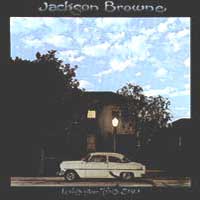 Mein absolutes Lieblingsalbum von Jackson Browne, vielleicht sogar eines meines
Lieblingsalben überhaupt, das ich damals, wie viele andere wunderbare
Musik, in der Radiosendung "Night Flight" von Alan Bangs
kennen gelernt habe. Der Titel "Fountain Of Sorrow" hat mich
damals nachts am Radio total beeindruckt, ist aber nur einer von vielen
sehr guten Songs. Aus der Begleitband muss David Lindley hervorgehoben
werden, der hier absolut göttlich spielt.
Mein absolutes Lieblingsalbum von Jackson Browne, vielleicht sogar eines meines
Lieblingsalben überhaupt, das ich damals, wie viele andere wunderbare
Musik, in der Radiosendung "Night Flight" von Alan Bangs
kennen gelernt habe. Der Titel "Fountain Of Sorrow" hat mich
damals nachts am Radio total beeindruckt, ist aber nur einer von vielen
sehr guten Songs. Aus der Begleitband muss David Lindley hervorgehoben
werden, der hier absolut göttlich spielt.

 Das unübertroffene Debüt der Band! Die Keimzelle der
Das unübertroffene Debüt der Band! Die Keimzelle der  Musikalisch sicherlich einer der Höhepunkte in der langen Bandgeschichte.
Das Bandkarussell hatte sich mal wieder gedreht, was bislang konstante
Höchstleistungen im Studio verhinderte. Von der alten Truppe blieben
nur Micky Jones (g,v) und Terry Williams (dr) übrig.
Deke Leonard (g,v) kehrte von seinem
Musikalisch sicherlich einer der Höhepunkte in der langen Bandgeschichte.
Das Bandkarussell hatte sich mal wieder gedreht, was bislang konstante
Höchstleistungen im Studio verhinderte. Von der alten Truppe blieben
nur Micky Jones (g,v) und Terry Williams (dr) übrig.
Deke Leonard (g,v) kehrte von seinem  Skandalös: "On The Beach" ist eine der besten Neil Young-Platten
- und es gibt sie immer noch nicht auf CD: ich hab mir deshalb jetzt
selber eine CD-Version gebastelt, damit ich sie auch im Auto hören
kann. Allen denen, die Herrn Young nur von seinem Hitalbum "
Skandalös: "On The Beach" ist eine der besten Neil Young-Platten
- und es gibt sie immer noch nicht auf CD: ich hab mir deshalb jetzt
selber eine CD-Version gebastelt, damit ich sie auch im Auto hören
kann. Allen denen, die Herrn Young nur von seinem Hitalbum " Benannt nach einer Dylan-Textzeile und mit einem hauptamtlichen Rickenbacker-12string
Gitarristen sind die Byrds-Vergleiche bei dieser englischen Band natürlich
unvermeidlich. Aber: es gibt ausschließlich eigenes hochkarätiges
Songmaterial, das seine historischen Referenzen nicht verleugnet. Außerdem
klingt die Ricky hier besser als jemals bei Roger McGuinn geklungen
hat. Es gibt auch ein paar interessante musikalische Gäste: Englands
Pedalsteel-Legende B.J.Cole, Lindisfarnes Mandolinenspieler
Ray Jackson (der ja auch schon Rolf Stuttgarts "Maggie May"
veredelt hat) und Gitarrist/Komponist Russ Ballard von Argent
am Piano.
Benannt nach einer Dylan-Textzeile und mit einem hauptamtlichen Rickenbacker-12string
Gitarristen sind die Byrds-Vergleiche bei dieser englischen Band natürlich
unvermeidlich. Aber: es gibt ausschließlich eigenes hochkarätiges
Songmaterial, das seine historischen Referenzen nicht verleugnet. Außerdem
klingt die Ricky hier besser als jemals bei Roger McGuinn geklungen
hat. Es gibt auch ein paar interessante musikalische Gäste: Englands
Pedalsteel-Legende B.J.Cole, Lindisfarnes Mandolinenspieler
Ray Jackson (der ja auch schon Rolf Stuttgarts "Maggie May"
veredelt hat) und Gitarrist/Komponist Russ Ballard von Argent
am Piano. An dieser Platte (Album Nr. 2 der Band) hängt mein Herz immer noch
ein wenig, denn es ist die erste, die ich mir damals von der Band gekauft
habe. Mitte der 70er habe ich die Minnerocker dann sehr intensiv gehört,
um sie danach aber wieder komplett aus meinen Hörgewohnheiten zu verdrängen.
Jetzt aus der Distanz kann ich es etwas gelassener betrachten: eigentlich
ist das eine ganz nette Platte!
An dieser Platte (Album Nr. 2 der Band) hängt mein Herz immer noch
ein wenig, denn es ist die erste, die ich mir damals von der Band gekauft
habe. Mitte der 70er habe ich die Minnerocker dann sehr intensiv gehört,
um sie danach aber wieder komplett aus meinen Hörgewohnheiten zu verdrängen.
Jetzt aus der Distanz kann ich es etwas gelassener betrachten: eigentlich
ist das eine ganz nette Platte! Neben
Neben